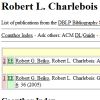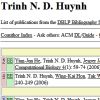| |
   
Jean-Christophe Aude,
Yolande Diaz-Lazcoz,
Jean-Jacques Codani and
Jean-Loup Risler. Applications of the Pyramidal Clustering Method to Biological Objects. In CC, Vol. 23(3-4):303-315, 1999.
Keywords: from distances, phylogenetic network, phylogeny, Program Pyramids, pyramid, reconstruction, software, visualization.
Note: http://dx.doi.org/10.1016/S0097-8485(99)00006-6.
|
|
| |
|
| |
 
Hans-Jürgen Bandelt and
Andreas W. M. Dress. Weak hierarchies associated with similarity measures: an additive clustering technique. In BMB, Vol. 51:113-166, 1989.
Keywords: abstract network, clustering, from distances, from trees, phylogenetic network, phylogeny, Program WeakHierarchies, reconstruction, weak hierarchy.
Note: http://dx.doi.org/10.1007/BF02458841.
Toggle abstract
"A new and apparently rather useful and natural concept in cluster analysis is studied: given a similarity measure on a set of objects, a sub-set is regarded as a cluster if any two objects a, b inside this sub-set have greater similarity than any third object outside has to at least one of a, b. These clusters then form a closure system which can be described as a hypergraph without triangles. Conversely, given such a system, one may attach some weight to each cluster and then compose a similarity measure additively, by letting the similarity of a pair be the sum of weights of the clusters containing that particular pair. The original clusters can be reconstructed from the obtained similarity measure. This clustering model is thus located between the general additive clustering model of Shepard and Arabie (1979) and the standard hierarchical model. Potential applications include fitting dendrograms with few additional nonnested clusters and simultaneous representation of some families of multiple dendrograms (in particular, two-dendrogram solutions), as well as assisting the search for phylogenetic relationships by proposing a somewhat larger system of possibly relevant "family groups", from which an appropriate choice (based on additional insight or individual preferences) remains to be made. © 1989 Society for Mathematical Biology."
|
|
| |
|
| |
|
| |
|
| |
   
Mihaela Baroni,
Stefan Grünewald,
Vincent Moulton and
Charles Semple. Bounding the number of hybridization events for a consistent evolutionary history. In JOMB, Vol. 51(2):171-182, 2005.
Keywords: agreement forest, bound, explicit network, from rooted trees, hybridization, minimum number, phylogenetic network, phylogeny, reconstruction, SPR distance.
Note: http://www.math.canterbury.ac.nz/~c.semple/papers/BGMS05.pdf.
Toggle abstract
"Evolutionary processes such as hybridisation, lateral gene transfer, and recombination are all key factors in shaping the structure of genes and genomes. However, since such processes are not always best represented by trees, there is now considerable interest in using more general networks instead. For example, in recent studies it has been shown that networks can be used to provide lower bounds on the number of recombination events and also for the number of lateral gene transfers that took place in the evolutionary history of a set of molecular sequences. In this paper we describe the theoretical performance of some related bounds that result when merging pairs of trees into networks. © Springer-Verlag 2005."
|
|
| |
   
Jaroslaw Byrka,
Pawel Gawrychowski,
Katharina Huber and
Steven Kelk. Worst-case optimal approximation algorithms for maximizing triplet consistency within phylogenetic networks. In Journal of Discrete Algorithms, Vol. 8(1):65-75, 2010.
Keywords: approximation, explicit network, from triplets, galled tree, level k phylogenetic network, phylogenetic network, phylogeny, reconstruction.
Note: http://arxiv.org/abs/0710.3258.
Toggle abstract
"The study of phylogenetic networks is of great interest to computational evolutionary biology and numerous different types of such structures are known. This article addresses the following question concerning rooted versions of phylogenetic networks. What is the maximum value of p ∈ [0, 1] such that for every input set T of rooted triplets, there exists some network N such that at least p | T | of the triplets are consistent with N? We call an algorithm that computes such a network (where p is maximum) worst-case optimal. Here we prove that the set containing all triplets (the full triplet set) in some sense defines p. Moreover, given a network N that obtains a fraction p′ for the full triplet set (for any p′), we show how to efficiently modify N to obtain a fraction ≥ p′ for any given triplet set T. We demonstrate the power of this insight by presenting a worst-case optimal result for level-1 phylogenetic networks improving considerably upon the 5/12 fraction obtained recently by Jansson, Nguyen and Sung. For level-2 phylogenetic networks we show that p ≥ 0.61. We emphasize that, because we are taking | T | as a (trivial) upper bound on the size of an optimal solution for each specific input T, the results in this article do not exclude the existence of approximation algorithms that achieve approximation ratio better than p. Finally, we note that all the results in this article also apply to weighted triplet sets. © 2009 Elsevier B.V. All rights reserved."
|
|
| |
  
Hans-Jürgen Bandelt,
Vincent Macaulay and
Martin Richards. Median networks: speedy construction and greedy reduction, one simulation, and two case studies from human mtDNA. In MPE, Vol. 16:8-28, 2000.
Keywords: from sequences, from splits, median network, phylogenetic network, phylogeny, reconstruction.
Note: http://www.stats.gla.ac.uk/~vincent/papers/speedy.pdf.
Toggle abstract
"Molecular data sets characterized by few phylogenetically informative characters with a broad spectrum of mutation rates, such as intraspecific control-region sequence variation of human mitochondrial DNA (mtDNA), can be usefully visualized in the form of median networks. Here we provide a step-by-step guide to the construction of such networks by hand. We improve upon a previously implemented algorithm by outlining an efficient parametrized strategy amenable to large data sets, greedy reduction, which makes it possible to reconstruct some of the confounding recurrent mutations. This entails some postprocessing as well, which assists in capturing more parsimonious solutions. To simplify the creation of the resulting network by hand, we describe a speedy approach to network construction, based on a careful planning of the processing order. A coalescent simulation tailored to human mtDNA variation in Eurasia testifies to the usefulness of reduced median networks, while highlighting notorious problems faced by all phylogenetic methods in this context. Finally, we discuss two case studies involving the comparison of characters in the two hypervariable segments of the human mtDNA control region in the light of the worldwide control-region sequence database, as well as additional restriction fragment length polymorphism information. We conclude that only a minority of the mutations that hit the second segment occur at sites that would have a mutation rate comparable to those at most sites in the first segment. Discarding the known 'noisy' sites of the second segment enhances the analysis. (C) 2000 Academic Press."
|
|
| |
 
David Bryant and
Vincent Moulton. NeighborNet: An Agglomerative Method for the Construction of Phylogenetic Networks. In MBE, Vol. 21(2):255-265, 2004.
Keywords: phylogenetic network, phylogeny, Program SplitsTree, reconstruction, split network.
Note: http://www.math.auckland.ac.nz/~bryant/Papers/04NeighborNet.pdf.
Toggle abstract
"We present Neighbor-Net, a distance based method for constructing phylogenetic networks that is based on the Neighbor-Joining (NJ) algorithm of Saitou and Nei. Neighbor-Net provides a snapshot of the data that can guide more detailed analysis. Unlike split decomposition, Neighbor-Net scales well and can quickly produce detailed and informative networks for several hundred taxa. We illustrate the method by reanalyzing three published data sets: a collection of 110 highly recombinant Salmonella multi-locus sequence typing sequences, the 135 "African Eve" human mitochondrial sequences published by Vigilant et al., and a collection of 12 Archeal chaperonin sequences demonstrating strong evidence for gene conversion. Neighbor-Net is available as part of the SplitsTree4 software package."
|
|
| |
  
Mihaela Baroni,
Charles Semple and
Mike Steel. A framework for representing reticulate evolution. In ACOM, Vol. 8:398-401, 2004.
Keywords: explicit network, from clusters, hybridization, minimum number, phylogenetic network, phylogeny, reconstruction, regular network, SPR distance.
Note: http://www.math.canterbury.ac.nz/~c.semple/papers/BSS04.pdf.
Toggle abstract
"Acyclic directed graphs (ADGs) are increasingly being viewed as more appropriate for representing certain evolutionary relationships, particularly in biology, than rooted trees. In this paper, we develop a framework for the analysis of these graphs which we call hybrid phylogenies. We are particularly interested in the problem whereby one is given a set of phylogenetic trees and wishes to determine a hybrid phylogeny that 'embeds' each of these trees and which requires the smallest number of hybridisation events. We show that this quantity can be greatly reduced if additional species are involved, and investigate other combinatorial aspects of this and related questions."
|
|
| |
  
Mihaela Baroni,
Charles Semple and
Mike Steel. Hybrids in Real Time. In Systematic Biology, Vol. 55(1):46-56, 2006.
Keywords: agreement forest, from rooted trees, phylogenetic network, phylogeny, polynomial, reconstruction, time consistent network.
Note: http://www.math.canterbury.ac.nz/~m.steel/Non_UC/files/research/hybrids.pdf.
Toggle abstract
"We describe some new and recent results that allow for the analysis and representation of reticulate evolution by nontree networks. In particular, we (1) present a simple result to show that, despite the presence of reticulation, there is always a well-defined underlying tree that corresponds to those parts of life that do not have a history of reticulation; (2) describe and apply new theory for determining the smallest number of hybridization events required to explain conflicting gene trees; and (3) present a new algorithm to determine whether an arbitrary rooted network can be realized by contemporaneous reticulation events. We illustrate these results with examples. Copyright © Society of Systematic Biologists."
|
|
| |
   
Ho-Leung Chan,
Jesper Jansson,
Tak-Wah Lam and
Siu-Ming Yiu. Reconstructing an Ultrametric Galled Phylogenetic Network from a Distance Matrix. In JBCB, Vol. 4(4):807-832, 2006.
Keywords: explicit network, from distances, galled tree, phylogenetic network, phylogeny, polynomial, reconstruction.
Note: http://www.df.lth.se/~jj/Publications/dist_ugn7_JBCB2006.pdf.
Toggle abstract
"Given a distance matrix M that specifies the pairwise evolutionary distances between n species, the phylogenetic tree reconstruction problem asks for an edge-weighted phylogenetic tree that satisfies M, if one exists. We study some extensions of this problem to rooted phylogenetic networks. Our main result is an O(n2 log n)-time algorithm for determining whether there is an ultrametric galled network that satisfies M, and if so, constructing one. In fact, if such an ultrametric galled network exists, our algorithm is guaranteed to construct one containing the minimum possible number of nodes with more than one parent (hybrid nodes). We also prove that finding a largest possible submatrix M′ of M such that there exists an ultrametric galled network that satisfies M′ is NP-hard. Furthermore, we show that given an incomplete distance matrix (i.e. where some matrix entries are missing), it is also NP-hard to determine whether there exists an ultrametric galled network which satisfies it. © 2006 Imperial College Press."
|
|
| |
  
Mark Clement,
David Posada and
Keith A. Crandall. TCS: a computer program to estimate gene genealogies. In MOLE, Vol. 9:1657-1659, 2000.
Keywords: from sequences, parsimony, phylogenetic network, phylogeny, Program TCS, reconstruction, software, statistical parsimony.
Note: http://darwin.uvigo.es/download/papers/08.tcs00.pdf.
Toggle abstract
[No abstract available]
|
|
| |
 
Andreas W. M. Dress and
Daniel H. Huson. Constructing splits graphs. In TCBB, Vol. 1(3):109-115, 2004.
Keywords: abstract network, circular split system, from trees, phylogenetic network, phylogeny, Program SplitsTree, reconstruction, split network, visualization.
Note: http://scilib.kiev.ua/ieee/tcbb/2004/03/n3/n0109.pdf.
Toggle abstract
"Phylogenetic trees correspond one-to-one to compatible systems of splits and so splits play an important role in theoretical and computational aspects of phylogeny. Whereas any tree reconstruction method can be thought of as producing a compatible system of splits, an increasing number of phylogenetlc algorithms are available that compute split systems that are not necessarily compatible and, thus, cannot always be represented by a tree. Such methods include the split decomposition, Neighbor-Net, consensus networks, and the Z-closure method. A more general split system of this kind can be represented graphically by a so-called splits graph, which generalizes the concept of a phylogenetic tree. This paper addresses the problem of computing a splits graph for a given set of splits. We have implemented all presented algorithms in a new program called SplitsTree4. © 2004 IEEE."
|
|
| |
|
| |
 
Olivier Gauthier and
François-Joseph Lapointe. Hybrids and Phylogenetics Revisited: A Statistical Test of Hybridization Using Quartets. In Systematic Botany, Vol. 32(1):8-15, 2007.
Keywords: explicit network, from quartets, hybridization, phylogenetic network, phylogeny, reconstruction, reticulogram, split decomposition.
Note: http://dx.doi.org/10.1600/036364407780360238.
Toggle abstract
"The occurrence of reticulations in the evolutionary history of species poses serious challenges for all modern practitioners of phylogenetic analysis. Such events, including hybridization, introgression, and lateral gene transfer, lead to evolutionary histories that cannot be adequately represented in the form of phylogenetic trees. Although numerous methods that allow for the reconstruction of phylogenetic networks have been proposed in recent years, the detection of reticulations still remains problematic. In this paper we present a Hybrid Detection Criterion (HDC) along with a statistical procedure that allows for the identification of hybrid taxa. The test assesses whether a putative hybrid is consistently intermediate between its postulated parents, with respect to the other taxa. The performance of the statistical method is evaluated using known hybrids of the genus Aphelandra (Acanthaceae) using two network methods: reticulograms and split decomposition graphs. Our results indicate that the HDC test is reliable when used jointly with split decomposition. On the other hand, the test lacks power and provides misleading results when using reticulograms. We then show how the procedure can be used as a tool to identify putative hybrids. © Copyright 2007 by the American Society of Plant Taxonomists."
|
|
| |
  
Dan Gusfield,
Satish Eddhu and
Charles Langley. Optimal, Efficient Reconstruction of Phylogenetic Networks with Constrained Recombination. In JBCB, Vol. 2(1):173-213, 2004.
Keywords: explicit network, from sequences, galled tree, phylogenetic network, phylogeny, recombination, reconstruction.
Note: http://wwwcsif.cs.ucdavis.edu/~gusfield/exfinalrec.pdf.
Toggle abstract
"A phylogenetic network is a generalization of a phylogenetic tree, allowing structural properties that are not tree-like. In a seminal paper, Wang et al.1 studied the problem of constructing a phylogenetic network, allowing recombination between sequences, with the constraint that the resulting cycles must be disjoint. We call such a phylogenetic network a "galled-tree". They gave a polynomial-time algorithm that was intended to determine whether or not a set of sequences could be generated on galled-tree. Unfortunately, the algorithm by Wang et al.1 is incomplete and does not constitute a necessary test for the existence of a galled-tree for the data. In this paper, we completely solve the problem. Moreover, we prove that if there is a galled-tree, then the one produced by our algorithm minimizes the number of recombinations over all phylogenetic networks for the data, even allowing multiple-crossover recombinations. We also prove that when there is a galled-tree for the data, the galled-tree minimizing the number of recombinations is "essentially unique" . We. also note two additional results: first, any set of sequences that can be derived on a galled tree can be derived on a true tree (without recombination cycles), where at most one back mutation per site is allowed; second, the site compatibility problem (which is NP-hard in general) can be solved in polynomial time for any set of sequences that can be derived on a galled tree. Perhaps more important than the specific results about galled-trees, we introduce an approach that can be used to study recombination in general phylogenetic networks. This paper greatly extends the conference version that appears in an earlier work.8 PowerPoint slides of the conference talk can be found at our website. © Imperial College Press."
|
|
| |
  
Dan Gusfield,
Satish Eddhu and
Charles Langley. The fine structure of galls in phylogenetic networks. In INCOMP, Vol. 16(4):459-469, 2004.
Keywords: explicit network, from sequences, galled tree, phylogenetic network, phylogeny, reconstruction.
Note: http://wwwcsif.cs.ucdavis.edu/~gusfield/informs.pdf.
Toggle abstract
"A phylogenetic network is a generalization of a phylogenetic tree, allowing properties that are not tree-like. With the growth of genomic data, much of which does not fit ideal tree models, there is greater need to understand the algorithmics and combinatorics of phylogenetic networks (Posada and Crandall 2001, Schierup and Hein 2000). Wang et al. (2001) studied the problem of constructing a phylogenetic network for a set of n binary sequences derived from the all-zero ancestral sequence, when each site in the sequence can mutate from zero to one at most once in the network, and recombination between sequences is allowed. They showed that the problem of minimizing the number of recombinations in such networks is NP-hard, but introduced a special case of the problem, i.e., to determine whether the sequences could be derived on a phylogenetic network where the recombination cycles are node-disjoint. Wang et al. (2001) provide a sufficient, but not a necessary test, for such solutions. Gusfield et al. (2003, 2004) gave a polynomial-time algorithm that is both a necessary and sufficient test. In this paper, we study in much more detail the fine combinatorial structure of node-disjoint cycles in phylogenetic networks, both for purposes of insight into phylogenetic networks and to speed up parts of the previous algorithm. We explicitly characterize all the ways in which mutations can be arranged on a disjoint cycle, and prove a strong necessary condition for a set of mutations to be on a disjoint cycle. The main contribution here is to show how structure in the phylogenetic network is reflected in the structure of an efficiently-computable graph, called the conflict graph. The success of this approach suggests that additional insight into the structure of phylogenetic networks can be obtained by exploring structural properties of the conflict graph."
|
|
| |
   
Stefan Grünewald,
Kristoffer Forslund,
Andreas W. M. Dress and
Vincent Moulton. QNet: An agglomerative method for the construction of phylogenetic networks from weighted quartets. In MBE, Vol. 24(2):532-538, 2007.
Keywords: abstract network, circular split system, from quartets, phylogenetic network, phylogeny, Program QNet, reconstruction, software.
Note: http://mbe.oxfordjournals.org/cgi/content/abstract/24/2/532.
Toggle abstract
"We present QNet, a method for constructing split networks from weighted quartet trees. QNet can be viewed as a quartet analogue of the distance-based Neighbor-Net (NNet) method for network construction. Just as NNet, QNet works by agglomeratively computing a collection of circular weighted splits of the taxa set which is subsequently represented by a planar split network. To illustrate the applicability of QNet, we apply it to a previously published Salmonella data set. We conclude that QNet can provide a useful alternative to NNet if distance data are not available or a character-based approach is preferred. Moreover, it can be used as an aid for determining when a quartet-based tree-building method may or may not be appropriate for a given data set. QNet is freely available for download. © The Author 2006. Published by Oxford University Press on behalf of the Society for Molecular Biology and Evolution. All rights reserved."
|
|
| |
  
Stefan Grünewald,
Katharina Huber and
Qiong Wu. Two novel closure rules for constructing phylogenetic super-networks. In BMB, Vol. 70(7):1906-1924, 2008.
Keywords: abstract network, from splits, from unrooted trees, phylogenetic network, phylogeny, Program MY CLOSURE, reconstruction, supernetwork.
Note: http://arxiv.org/abs/0709.0283, slides available at http://www.newton.cam.ac.uk/webseminars/pg+ws/2007/plg/plgw01/0904/huber/.
Toggle abstract
"A contemporary and fundamental problem faced by many evolutionary biologists is how to puzzle together a collection P of partial trees (leaf-labeled trees whose leaves are bijectively labeled by species or, more generally, taxa, each supported by, e.g., a gene) into an overall parental structure that displays all trees in P. This already difficult problem is complicated by the fact that the trees in P regularly support conflicting phylogenetic relationships and are not on the same but only overlapping taxa sets. A desirable requirement on the sought after parental structure, therefore, is that it can accommodate the observed conflicts. Phylogenetic networks are a popular tool capable of doing precisely this. However, not much is known about how to construct such networks from partial trees, a notable exception being the Z-closure super-network approach, which is based on the Z-closure rule, and the Q-imputation approach. Although attractive approaches, they both suffer from the fact that the generated networks tend to be multidimensional making it necessary to apply some kind of filter to reduce their complexity. To avoid having to resort to a filter, we follow a different line of attack in this paper and develop closure rules for generating circular phylogenetic networks which have the attractive property that they can be represented in the plane. In particular, we introduce the novel Y-(closure) rule and show that this rule on its own or in combination with one of Meacham's closure rules (which we call the M-rule) has some very desirable theoretical properties. In addition, we present a case study based on Rivera et al. "ring of life" to explore the reconstructive power of the M- and Y-rule and also reanalyze an Arabidopsis thaliana data set. © 2008 Society for Mathematical Biology."
|
|
| |
  
Stefan Grünewald,
Vincent Moulton and
Andreas Spillner. Consistency of the QNet algorithm for generating planar split networks from weighted quartets. In DAM, Vol. 157(10):2325-2334, 2009.
Keywords: abstract network, consistency, from quartets, phylogenetic network, phylogeny, Program QNet, reconstruction, software.
Note: http://dx.doi.org/10.1016/j.dam.2008.06.038.
Toggle abstract
"Phylogenetic networks are a generalization of evolutionary or phylogenetic trees that allow the representation of conflicting signals or alternative evolutionary histories in a single diagram. Recently the Quartet-Net or "QNet" method was introduced, a method for computing a special kind of phylogenetic network called a split network from a collection of weighted quartet trees (i.e. phylogenetic trees with 4 leaves). This can be viewed as a quartet analogue of the distance-based Neighbor-Net (NNet) method for constructing outer-labeled planar split networks. In this paper, we prove that QNet is a consistent method, that is, we prove that if QNet is applied to a collection of weighted quartets arising from a circular split weight function, then it will return precisely this function. This key property of QNet not only ensures that it is guaranteed to produce a tree if the input corresponds to a tree, and an outer-labeled planar split network if the input corresponds to such a network, but also provides the main guiding principle for the design of the method. © 2008 Elsevier B.V. All rights reserved."
|
|
| |
|
| |
   
Barbara R. Holland,
Glenn Conner,
Katharina Huber and
Vincent Moulton. Imputing Supertrees and Supernetworks from Quartets. In Systematic Biology, Vol. 56(1):57-67, 2007.
Keywords: abstract network, from unrooted trees, phylogenetic network, phylogeny, Program Quartet, reconstruction, split network, supernetwork.
Note: http://citeseerx.ist.psu.edu/viewdoc/summary?doi=10.1.1.99.3215.
Toggle abstract
"Inferring species phylogenies is an important part of understanding molecular evolution. Even so, it is well known that an accurate phylogenetic tree reconstruction for a single gene does not always necessarily correspond to the species phylogeny. One commonly accepted strategy to cope with this problem is to sequence many genes; the way in which to analyze the resulting collection of genes is somewhat more contentious. Supermatrix and supertree methods can be used, although these can suppress conflicts arising from true differences in the gene trees caused by processes such as lineage sorting, horizontal gene transfer, or gene duplication and loss. In 2004, Huson et al. (IEEE/ACM Trans. Comput. Biol. Bioinformatics 1:151-158) presented the Z-closure method that can circumvent this problem by generating a supernetwork as opposed to a supertree. Here we present an alternative way for generating supernetworks called Q-imputation. In particular, we describe a method that uses quartet information to add missing taxa into gene trees. The resulting trees are subsequently used to generate consensus networks, networks that generalize strict and majority-rule consensus trees. Through simulations and application to real data sets, we compare Q-imputation to the matrix representation with parsimony (MRP) supertree method and Z-closure, and demonstrate that it provides a useful complementary tool. Copyright © Society of Systematic Biologists."
|
|
| |
   
Daniel H. Huson,
Tobias Dezulian,
Tobias Kloepper and
Mike Steel. Phylogenetic Super-Networks from Partial Trees. In TCBB, Vol. 1(4):151-158, 2004.
Keywords: abstract network, from unrooted trees, phylogenetic network, phylogeny, Program SplitsTree, reconstruction, supernetwork.
Note: http://hdl.handle.net/10092/3177.
Toggle abstract
"In practice, one is often faced with incomplete phylogenetic data, such as a collection of partial trees or partial splits. This paper poses the problem of Inferring a phylogenetic super-network from such data and provides an efficient algorithm for doing so, called the Z-closure method. Additionally, the questions of assigning lengths to the edges of the network and how to restrict the "dimensionality" of the network are addressed. Applications to a set of five published partial gene trees relating different fungal species and to six published partial gene trees relating different grasses illustrate the usefulness of the method and an experimental study confirms Its potential. The method Is implemented as a plug-in for the program SplitsTree4. © 2004 IEEE."
|
|
| |
   
Katharina Huber,
Bengt Oxelman,
Martin Lott and
Vincent Moulton. Reconstructing the Evolutionary History of Polyploids from Multilabeled Trees. In MBE, Vol. 23(9):1784-1791, 2007.
Keywords: duplication, explicit network, from multilabeled tree, from trees, phylogenetic network, phylogeny, Program PADRE, reconstruction, software.
Note: http://mbe.oxfordjournals.org/cgi/content/full/23/9/1784.
Toggle abstract
"In recent studies, phylogenetic networks have been derived from so-called multilabeled trees in order to understand the origins of certain polyploids. Although the trees used in these studies were constructed using sophisticated techniques in phylogenetic analysis, the presented networks were inferred using ad hoc arguments that cannot be easily extended to larger, more complicated examples. In this paper, we present a general method for constructing such networks, which takes as input a multilabeled phylogenetic tree and outputs a phylogenetic network with certain desirable properties. To illustrate the applicability of our method, we discuss its use in reconstructing the evolutionary history of plant allopolyploids. We conclude with a discussion concerning possible future directions. The network construction method has been implemented and is freely available for use from http://www.uea.ac.uk/ ∼a043878/padre.html. © The Author 2006. Published by Oxford University Press on behalf of the Society for Molecular Biology and Evolution. All rights reserved."
|
|
| |
 
Vincent Moulton and
Katharina Huber. Phylogenetic networks from multi-labelled trees. In JOMB, Vol. 52(5):613-632, 2006.
Keywords: duplication, explicit network, from multilabeled tree, phylogenetic network, phylogeny, Program PADRE, reconstruction.
Note: http://www.uea.ac.uk/~a043878/jmb.pdf.
Toggle abstract
"It is now quite well accepted that the evolutionary past of certain species is better represented by phylogenetic networks as opposed to trees. For example, polyploids are typically thought to have resulted through hybridization and duplication, processes that are probably not best represented as bifurcating speciation events. Based on the knowledge of a multi-labelled tree relating collection of polyploids, we present a canonical construction of a phylogenetic network that exhibits the tree. In addition, we prove that the resulting network is in some well-defined sense a minimal network having this property. © Springer-Verlag 2006."
|
|
| |
 
Jesper Jansson and
Wing-Kin Sung. Inferring a level-1 phylogenetic network from a dense set of rooted triplets. In TCS, Vol. 363(1):60-68, 2006.
Keywords: explicit network, from triplets, galled tree, level k phylogenetic network, phylogenetic network, phylogeny, polynomial, reconstruction.
Note: http://www.df.lth.se/~jj/Publications/ipnrt8_TCS2006.pdf.
Toggle abstract
"We consider the following problem: Given a set T of rooted triplets with leaf set L, determine whether there exists a phylogenetic network consistent with T, and if so, construct one. We show that if no restrictions are placed on the hybrid nodes in the solution, the problem is trivially solved in polynomial time by a simple sorting network-based construction. For the more interesting (and biologically more motivated) case where the solution is required to be a level-1 phylogenetic network, we present an algorithm solving the problem in O (| T |2) time when T is dense, i.e., when T contains at least one rooted triplet for each cardinality three subset of L. We also give an O (| T |5 / 3)-time algorithm for finding the set of all phylogenetic networks having a single hybrid node attached to exactly one leaf (and having no other hybrid nodes) that are consistent with a given dense set of rooted triplets. © 2006 Elsevier B.V. All rights reserved."
|
|
| |
  
Jesper Jansson,
Nguyen Bao Nguyen and
Wing-Kin Sung. Algorithms for Combining Rooted Triplets into a Galled Phylogenetic Network. In SICOMP, Vol. 35(5):1098-1121, 2006.
Keywords: approximation, explicit network, from triplets, galled tree, phylogenetic network, phylogeny, polynomial, reconstruction.
Note: http://www.df.lth.se/~jj/Publications/triplets_to_gn7_SICOMP2006.pdf.
Toggle abstract
"This paper considers the problem of determining whether a given set Τ of rooted triplets can be merged without conflicts into a galled phylogenetic network and, if so, constructing such a network. When the input Τ is dense, we solve the problem in O(|Τ|) time, which is optimal since the size of the input is Θ(|Τ|). In comparison, the previously fastest algorithm for this problem runs in O(|Τ|2) time. We also develop an optimal O(|Τ|)-time algorithm for enumerating all simple phylogenetic networks leaf-labeled by L that are consistent with Τ, where L is the set of leaf labels in Τ, which is used by our main algorithm. Next, we prove that the problem becomes NP-hard if extended to nondense inputs, even for the special case of simple phylogenetic networks. We also show that for every positive integer n, there exists some set Τ of rooted triplets on n leaves such that any galled network can be consistent with at most 0.4883 ·|Τ| of the rooted triplets in Τ. On the other hand, we provide a polynomial-time approximation algorithm that always outputs a galled network consistent with at least a factor of 5/12 (> 0.4166) of the rooted triplets in Τ. © 2006 Society for Industrial and Applied Mathematics."
|
|
| |
   
Guohua Jin,
Luay Nakhleh,
Sagi Snir and
Tamir Tuller. Maximum Likelihood of Phylogenetic Networks. In BIO, Vol. 22(21):2604-2611, 2006.
Keywords: explicit network, likelihood, phylogenetic network, phylogeny, Program Nepal, reconstruction.
Note: http://www.cs.rice.edu/~nakhleh/Papers/NetworksML06.pdf, supplementary material: http://www.cs.rice.edu/~nakhleh/Papers/Supp-ML.pdf.
|
|
| |
|
| |
|
| |

François-Joseph Lapointe. How to account for reticulation events in phylogenetic analysis: A review of distance-based methods. In Journal of Classification, Vol. 17:175-184, 2000.
Keywords: abstract network, evaluation, from distances, phylogenetic network, Program Pyramids, Program SplitsTree, Program T REX, pyramid, reconstruction, reticulogram, split network, survey, weak hierarchy.
Note: http://dx.doi.org/10.1007/s003570000016.
|
|
| |
|
| |
|
| |
|
| |

David A. Morrison. Networks in phylogenetic analysis: new tools for population biology. In IJP, Vol. 35:567-582, 2005.
Keywords: median network, NeighborNet, phylogenetic network, phylogeny, population genetics, Program Network, Program Spectronet, Program SplitsTree, Program T REX, Program TCS, reconstruction, reticulogram, split decomposition, survey.
Note: http://hem.fyristorg.com/acacia/papers/networks.pdf.
|
|
| |
   
Luay Nakhleh,
Tandy Warnow,
C. Randal Linder and
Katherine St. John. Reconstructing reticulate evolution in species - theory and practice. In JCB, Vol. 12(6):796-811, 2005.
Keywords: from rooted trees, galled tree, phylogenetic network, phylogeny, polynomial, Program SPNet, reconstruction, software.
Note: http://www.cs.rice.edu/~nakhleh/Papers/NWLSjcb.pdf.
|
|
| |
  
Alan R. Templeton,
Keith A. Crandall and
Charles F. Sing. A Cladistic Analysis of Phenotypic Associations With Haplotypes Inferred From Restriction Endonuclease Mapping and DNA Sequence Data. III. Cladogram Estimation. In GEN, Vol. 132:619-633, 2000.
Keywords: from sequences, parsimony, phylogenetic network, phylogeny, Program TCS, recombination, reconstruction, statistical parsimony.
Note: http://www.genetics.org/cgi/content/abstract/132/2/619.
|
|
| |
    
Richard C. Winkworth,
David Bryant,
Peter J. Lockhart,
David Havell and
Vincent Moulton. Biogeographic Interpretation of Splits Graphs: Least Squares Optimization of Branch Lengths. In Systematic Biology, Vol. 54(1):56-65, 2005.
Keywords: abstract network, from distances, from network, phylogenetic network, phylogeny, reconstruction, split, split network.
Note: http://www.math.auckland.ac.nz/~bryant/Papers/05Biogeographic.pdf.
|
|
| |
|
| |
|
| |
|
| |
   
Dave MacLeod,
Robert L. Charlebois,
W. Ford Doolittle and
Eric Bapteste. Deduction of probable events of lateral gene transfer through comparison of phylogenetic trees by recursive consolidation and rearrangement. In BMCEB, Vol. 5(27), 2005.
Keywords: explicit network, from rooted trees, lateral gene transfer, phylogenetic network, phylogeny, Program HorizStory, reconstruction, software.
Note: http://dx.doi.org/10.1186/1471-2148-5-27.
Toggle abstract
"Background: When organismal phylogenies based on sequences of single marker genes are poorly resolved, a logical approach is to add more markers, on the assumption that weak but congruent phylogenetic signal will be reinforced in such multigene trees. Such approaches are valid only when the several markers indeed have identical phylogenies, an issue which many multigene methods (such as the use of concatenated gene sequences or the assembly of supertrees) do not directly address. Indeed, even when the true history is a mixture of vertical descent for some genes and lateral gene transfer (LGT) for others, such methods produce unique topologies. Results: We have developed software that aims to extract evidence for vertical and lateral inheritance from a set of gene trees compared against an arbitrary reference tree. This evidence is then displayed as a synthesis showing support over the tree for vertical inheritance, overlaid with explicit lateral gene transfer (LGT) events inferred to have occurred over the history of the tree. Like splits-tree methods, one can thus identify nodes at which conflict occurs. Additionally one can make reasonable inferences about vertical and lateral signal, assigning putative donors and recipients. Conclusion: A tool such as ours can serve to explore the reticulated dimensionality of molecular evolution, by dissecting vertical and lateral inheritance at high resolution. By this, we mean that individual nodes can be examined not only for congruence, but also for coherence in light of LGT. We assert that our tools will facilitate the comparison of phylogenetic trees, and the interpretation of conflicting data. © 2005 MacLeod et al; licensee BioMed Central Ltd."
|
|
| |
 
Robert G. Beiko and
Nicholas Hamilton. Phylogenetic identification of lateral genetic transfer events. In BMCEB, Vol. 6(15), 2006.
Keywords: evaluation, from rooted trees, from unrooted trees, lateral gene transfer, Program EEEP, Program HorizStory, Program LatTrans, reconstruction, software, SPR distance.
Note: http://dx.doi.org/10.1186/1471-2148-6-15.
Toggle abstract
"Background: Lateral genetic transfer can lead to disagreements among phylogenetic trees comprising sequences from the same set of taxa. Where topological discordance is thought to have arisen through genetic transfer events, tree comparisons can be used to identify the lineages that may have shared genetic information. An 'edit path' of one or more transfer events can be represented with a series of subtree prune and regraft (SPR) operations, but finding the optimal such set of operations is NP-hard for comparisons between rooted trees, and may be so for unrooted trees as well. Results: Efficient Evaluation of Edit Paths (EEEP) is a new tree comparison algorithm that uses evolutionarily reasonable constraints to identify and eliminate many unproductive search avenues, reducing the time required to solve many edit path problems. The performance of EEEP compares favourably to that of other algorithms when applied to strictly bifurcating trees with specified numbers of SPR operations. We also used EEEP to recover edit paths from over 19 000 unrooted, incompletely resolved protein trees containing up to 144 taxa as part of a large phylogenomic study. While inferred protein trees were far more similar to a reference supertree than random trees were to each other, the phylogenetic distance spanned by random versus inferred transfer events was similar, suggesting that real transfer events occur most frequently between closely related organisms, but can span large phylogenetic distances as well. While most of the protein trees examined here were very similar to the reference supertree, requiring zero or one edit operations for reconciliation, some trees implied up to 40 transfer events within a single orthologous set of proteins. Conclusion: Since sequence trees typically have no implied root and may contain unresolved or multifurcating nodes, the strategy implemented in EEEP is the most appropriate for phylogenomic analyses. The high degree of consistency among inferred protein trees shows that vertical inheritance is the dominant pattern of evolution, at least for the set of organisms considered here. However, the edit paths inferred using EEEP suggest an important role for genetic transfer in the evolution of microbial genomes as well. © 2006Beiko and Hamilton; licensee BioMed Central Ltd."
|
|
| |
 
Ulrik Brandes and
Sabine Cornelsen. Phylogenetic Graph Models Beyond Trees. In DAM, Vol. 157(10):2361-2369, 2009.
Keywords: abstract network, cactus graph, from splits, phylogenetic network, phylogeny, polynomial, reconstruction.
Note: http://www.inf.uni-konstanz.de/~cornelse/Papers/bc-pgmbt-07.pdf.
Toggle abstract
"A graph model for a set S of splits of a set X consists of a graph and a map from X to the vertices of the graph such that the inclusion-minimal cuts of the graph represent S. Phylogenetic trees are graph models in which the graph is a tree. We show that the model can be generalized to a cactus (i.e. a tree of edges and cycles) without losing computational efficiency. A cactus can represent a quadratic rather than linear number of splits in linear space. We show how to decide in linear time in the size of a succinct representation of S whether a set of splits has a cactus model, and if so construct it within the same time bounds. As a byproduct, we show how to construct the subset of all compatible splits and a maximal compatible set of splits in linear time. Note that it is N P-complete to find a compatible subset of maximum size. Finally, we briefly discuss further generalizations of tree models. © 2008 Elsevier B.V. All rights reserved."
|
|
| |
 
Katharina Huber,
Elizabeth E. Watson and
Mike Hendy. An Algorithm for Constructing Local Regions in a Phylogenetic Network. In MPE, Vol. 19(1):1-8, 2000.
Keywords: abstract network, median network, phylogenetic network, phylogeny, reconstruction, split.
Note: http://dx.doi.org/10.1006/mpev.2000.0891.
Toggle abstract
"The groupings of taxa in a phylogenetic tree cannot represent all the conflicting signals that usually occur among site patterns in aligned homologous genetic sequences. Hence a tree-building program must compromise by reporting a subset of the patterns, using some discriminatory criterion. Thus, in the worst case, out of possibly a large number of equally good trees, only an arbitrarily chosen tree might be reported by the tree-building program as" The Tree." This tree might then be used as a basis for phylogenetic conclusions. One strategy to represent conflicting patterns in the data is to construct a network. The Buneman graph is a theoretically very attractive example of such a network. In particular, a characterization for when this network will be a tree is known. Also the Buneman graph contains each of the most parsimonious trees indicated by the data. In this paper we describe a new method for constructing the Buneman graph that can be used for a generalization of Hadamard conjugation to networks. This new method differs from previous methods by allowing us to focus on local regions of the graph without having to first construct the full graph. The construction is illustrated by an example. © 2001 Academic Press."
|
|
| |
|
| |
   
Dan Gusfield,
Vikas Bansal,
Vineet Bafna and
Yun S. Song. A Decomposition Theory for Phylogenetic Networks and Incompatible Characters. In JCB, Vol. 14(10):1247-1272, 2007.
Keywords: explicit network, from sequences, galled tree, phylogenetic network, phylogeny, Program Beagle, Program GalledTree, recombination, reconstruction, software.
Note: http://www.eecs.berkeley.edu/~yss/Pub/decomposition.pdf.
|
|
| |
    
Yun S. Song,
Zhihong Ding,
Dan Gusfield,
Charles Langley and
Yufeng Wu. Algorithms to Distinguish the Role of Gene-Conversion from Single-Crossover Recombination in the Derivation of SNP Sequences in Populations. In JCB, Vol. 14(10):1273-1286, 2007.
Keywords: ARG, from sequences, phylogenetic network, phylogeny, Program SHRUB, reconstruction.
Note: http://dx.doi.org/10.1089/cmb.2007.0096.
Toggle abstract
"Meiotic recombination is a fundamental biological event and one of the principal evolutionary forces responsible for shaping genetic variation within species. In addition to its fundamental role, recombination is central to several critical applied problems. The most important example is "association mapping" in populations, which is widely hoped to help find genes that influence genetic diseases (Carlson et al., 2004; Clark, 2003). Hence, a great deal of recent attention has focused on problems of inferring the historical derivation of sequences in populations when both mutations and recombinations have occurred. In the algorithms literature, most of that recent work has been directed to single-crossover recombination. However, gene-conversion is an important, and more common, form of (two-crossover) recombination which has been much less investigated in the algorithms literature. In this paper, we explicitly incorporate gene-conversion into discrete methods to study historical recombination. We are concerned with algorithms for identifying and locating the extent of historical crossing-over and gene-conversion (along with single-nucleotide mutation), and problems of constructing full putative histories of those events. The novel technical issues concern the incorporation of gene-conversion into recently developed discrete methods (Myers and Griffiths, 2003; Song et al., 2005) that compute lower and upper-bound information on the amount of needed recombination without gene-conversion. We first examine the most natural extension of the lower bound methods from Myers and Griffiths (2003), showing that the extension can be computed efficiently, but that this extension can only yield weak lower bounds. We then develop additional ideas that lead to higher lower bounds, and show how to solve, via integer-linear programming, a more biologically realistic version of the lower bound problem. We also show how to compute effective upper bounds on the number of needed single-crossovers and gene-conversions, along with explicit networks showing a putative history of mutations, single-crossovers and gene-conversions. Both lower and upper bound methods can handle data with missing entries, and the upper bound method can be used to infer missing entries with high accuracy. We validate the significance of these methods by showing that they can be effectively used to distinguish simulation-derived sequences generated without gene-conversion from sequences that were generated with gene-conversion. We apply the methods to recently studied sequences of Arabidopsis thaliana, identifying many more regions in the sequences than were previously identified (Plagnol et al., 2006), where gene-conversion may have played a significant role. Demonstration software is available at www.csif.cs.ucdavis.edu/∼gusfield. © 2007 Mary Ann Liebert, Inc."
|
|
| |
|
| |
  
Insa Cassens,
Patrick Mardulyn and
Michel C. Milinkovitch. Evaluating Intraspecific Network Construction Methods Using Simulated Sequence Data: Do Existing Algorithms Outperform the Global Maximum Parsimony Approach? In Systematic Biology, Vol. 54(3):363-372, 2005.
Keywords: abstract network, evaluation, from unrooted trees, haplotype network, parsimony, phylogenetic network, phylogeny, Program Arlequin, Program CombineTrees, Program Network, Program TCS, reconstruction, software.
Note: http://www.lanevol.org/LANE/publications_files/Cassens_etal_SystBio_2005.pdf.
|
|
| |
|
| |
  
Leo van Iersel,
Steven Kelk and
Matthias Mnich. Uniqueness, intractability and exact algorithms: reflections on level-k phylogenetic networks. In JBCB, Vol. 7(4):597-623, 2009.
Keywords: explicit network, from triplets, galled tree, level k phylogenetic network, NP complete, phylogenetic network, phylogeny, reconstruction, uniqueness.
Note: http://arxiv.org/pdf/0712.2932v2.
|
|
| |
   
Andreas W. M. Dress,
Katharina Huber,
Jacobus Koolen and
Vincent Moulton. Compatible decompositions and block realizations of finite metrics. In EJC, Vol. 29(7):1617-1633, 2008.
Keywords: abstract network, block realization, from distances, phylogenetic network, phylogeny, realization, reconstruction.
Note: http://www.ims.nus.edu.sg/preprints/2007-21.pdf.
Toggle abstract
"Given a metric D defined on a finite set X, we define a finite collection D of metrics on X to be a compatible decomposition of D if any two distinct metrics in D are linearly independent (considered as vectors in RX × X), D = ∑d ∈ D d holds, and there exist points x, x′ ∈ X for any two distinct metrics d, d′ in D such that d (x, y) d′ (x′, y) = 0 holds for every y ∈ X. In this paper, we show that such decompositions are in one-to-one correspondence with (isomorphism classes of) block realizations of D, that is, graph realizations G of D for which G is a block graph and for which every vertex in G not labelled by X has degree at least 3 and is a cut point of G. This generalizes a fundamental result in phylogenetic combinatorics that states that a metric D defined on X can be realized by a tree if and only if there exists a compatible decomposition D of D such that all metrics d ∈ D are split metrics, and lays the foundation for a more general theory of metric decompositions that will be explored in future papers. © 2007 Elsevier Ltd. All rights reserved."
|
|
| |
|
| |
   
Barbara R. Holland,
Steffi Benthin,
Peter J. Lockhart,
Vincent Moulton and
Katharina Huber. Using supernetworks to distinguish hybridization from lineage-sorting. In BMCEB, Vol. 8(202), 2008.
Keywords: explicit network, from unrooted trees, hybridization, lineage sorting, phylogenetic network, phylogeny, reconstruction, supernetwork.
Note: http://dx.doi.org/10.1186/1471-2148-8-202.
Toggle abstract
"Background. A simple and widely used approach for detecting hybridization in phylogenies is to reconstruct gene trees from independent gene loci, and to look for gene tree incongruence. However, this approach may be confounded by factors such as poor taxon-sampling and/or incomplete lineage-sorting. Results. Using coalescent simulations, we investigated the potential of supernetwork methods to differentiate between gene tree incongruence arising from taxon sampling and incomplete lineage-sorting as opposed to hybridization. For few hybridization events, a large number of independent loci, and well-sampled taxa across these loci, we found that it was possible to distinguish incomplete lineage-sorting from hybridization using the filtered Z-closure and Q-imputation supernetwork methods. Moreover, we found that the choice of supernetwork method was less important than the choice of filtering, and that count-based filtering was the most effective filtering technique. Conclusion. Filtered supernetworks provide a tool for detecting and identifying hybridization events in phylogenies, a tool that should become increasingly useful in light of current genome sequencing initiatives and the ease with which large numbers of independent gene loci can be determined using new generation sequencing technologies. © 2008 Holland et al; licensee BioMed Central Ltd."
|
|
| |
 
Supriya Munshaw and
Thomas B. Kepler. An Information-Theoretic Method for the Treatment of Plural Ancestry in Phylogenetics. In MBE, Vol. 25(6):1199-1208, 2008.
Keywords: explicit network, from sequences, heuristic, phylogenetic network, reconstruction, simulated annealing, software.
Note: http://dx.doi.org/10.1093/molbev/msn066.
Toggle abstract
"In the presence of recombination and gene conversion, a given genomic segment may inherit information from 2 distinct immediate ancestors. The importance of this type of molecular inheritance has become increasingly clear over the years, and the potential for erroneous inference when it is not accounted for in the statistical model is well documented. Yet, the inclusion of plural ancestry (PA) in phylogenetic analysis is still not routine. This omission is due to the greater difficulty of phylogenetic inference on general acyclic graphs compared that on with trees and the accompanying computational burden. We have developed a technique for phylogenetic inference in the presence of PA based on the principle of minimum description length, which assigns a cost - the description length - to each network topology given the observed sequence data. The description length combines the cost of poor data fit and model complexity in terms of information. This device allows us to search through network topologies to minimize the total description length. By comparing the best models obtained with and without PA, one can determine whether or not recombination has played an active role in the evolution of the genes under investigation, identify those genes that appear to be mosaic, and infer the phylogenetic network that best represents the history of the alignment. We show that the method performs well on simulated data and demonstrate its application on HIV env gene sequence data from 8 human subjects. The software implementation of the method is available upon request. © The Author 2008. Published by Oxford University Press on behalf of the Society for Molecular Biology and Evolution. All rights reserved."
|
|
| |
|
| |
 
Roderic D.M. Page and
Michael A. Charleston. Trees within trees: phylogeny and historical associations. In TEE, Vol. 13(9):356-359, 1998.
Keywords: duplication, explicit network, from rooted trees, from species tree, lateral gene transfer, phylogenetic network, phylogeny, reconstruction, survey.
Note: http://taxonomy.zoology.gla.ac.uk/rod/papers/tree.pdf.
|
|
| |
 
Ran Libeskind-Hadas and
Michael A. Charleston. On the Computational Complexity of the Reticulate Cophylogeny Reconstruction Problem. In JCB, Vol. 16(1):105-117, 2009.
Keywords: cophylogeny, heuristic, NP complete, parsimony, phylogenetic network, reconstruction.
Note: http://dx.doi.org/10.1089/cmb.2008.0084.
Toggle abstract
"The cophylogeny reconstruction problem is that of finding minimal cost explanations of differences between evolutionary histories of ecologically linked groups of biological organisms. We present a proof that shows that the general problem of reconciling evolutionary histories is NP-complete and provide a sharp boundary where this intractability begins. We also show that a related problem, that of finding Pareto optimal solutions, is NP-hard. As a byproduct of our results, we give a framework by which meta-heuristics can be applied to find good solutions to this problem. © Mary Ann Liebert, Inc. 2009."
|
|
| |

Stephen J. Willson. Regular Networks Can Be Uniquely Constructed from Their Trees. In TCBB, Vol. 8(3):785-796, 2010.
Keywords: explicit network, from rooted trees, phylogenetic network, phylogeny, reconstruction, regular network.
Note: http://www.public.iastate.edu/~swillson/RegularNetsFromTrees5.pdf.
Toggle abstract
"A rooted acyclic digraph N with labeled leaves displays a tree T when there exists a way to select a unique parent of each hybrid vertex resulting in the tree T. Let Tr(N) denote the set of all trees displayed by the network N. In general, there may be many other networks M, such that Tr(M) = Tr(N). A network is regular if it is isomorphic with its cover digraph. If N is regular and D is a collection of trees displayed by N, this paper studies some procedures to try to reconstruct N given D. If the input is D=Tr(N), one procedure is described, which will reconstruct N. Hence, if N and M are regular networks and Tr(N) = Tr(M), it follows that N = M, proving that a regular network is uniquely determined by its displayed trees. If D is a (usually very much smaller) collection of displayed trees that satisfies certain hypotheses, modifications of the procedure will still reconstruct N given D. © 2011 IEEE."
|
|
| |
   
Martin Lott,
Andreas Spillner,
Katharina Huber and
Vincent Moulton. PADRE: A Package for Analyzing and Displaying Reticulate Evolution. In BIO, Vol. 25(9):1199-1200, 2009.
Keywords: duplication, explicit network, from multilabeled tree, phylogenetic network, phylogeny, Program PADRE, reconstruction, software.
Note: http://dx.doi.org/10.1093/bioinformatics/btp133.
Toggle abstract
"Recent advances in gene sequencing for polyploid species, coupled with standard phylogenetic tree reconstruction, leads to gene trees in which the same species can label several leaves. Such multi-labeled trees are then used to reconstruct the evolutionary history of the polyploid species in question. However, this reconstruction process requires new techniques that are not available in current phylogenetic software packages. Here, we describe the software package PADRE (Package for Analyzing and Displaying Reticulate Evolution) that implements such techniques, allowing the reconstruction of complex evolutionary histories for polyploids in the form of phylogenetic networks. © The Author 2009. Published by Oxford University Press. All rights reserved."
|
|
| |
 
Sarah C. Ayling and
Terence A. Brown. Novel methodology for construction and pruning of quasi-median networks. In BMCB, Vol. 9:115, 2009.
Keywords: abstract network, from sequences, median network, phylogenetic network, phylogeny, quasi-median network, reconstruction.
Note: http://dx.doi.org/10.1186/1471-2105-9-115.
Toggle abstract
"BACKGROUND: Visualising the evolutionary history of a set of sequences is a challenge for molecular phylogenetics. One approach is to use undirected graphs, such as median networks, to visualise phylogenies where reticulate relationships such as recombination or homoplasy are displayed as cycles. Median networks contain binary representations of sequences as nodes, with edges connecting those sequences differing at one character; hypothetical ancestral nodes are invoked to generate a connected network which contains all most parsimonious trees. Quasi-median networks are a generalisation of median networks which are not restricted to binary data, although phylogenetic information contained within the multistate positions can be lost during the preprocessing of data. Where the history of a set of samples contain frequent homoplasies or recombination events quasi-median networks will have a complex topology. Graph reduction or pruning methods have been used to reduce network complexity but some of these methods are inapplicable to datasets in which recombination has occurred and others are procedurally complex and/or result in disconnected networks. RESULTS: We address the problems inherent in construction and reduction of quasi-median networks. We describe a novel method of generating quasi-median networks that uses all characters, both binary and multistate, without imposing an arbitrary ordering of the multistate partitions. We also describe a pruning mechanism which maintains at least one shortest path between observed sequences, displaying the underlying relations between all pairs of sequences while maintaining a connected graph. CONCLUSION: Application of this approach to 5S rDNA sequence data from sea beet produced a pruned network within which genetic isolation between populations by distance was evident, demonstrating the value of this approach for exploration of evolutionary relationships."
|
|
| |

Frederick A. Matsen. ConstNJ: an algorithm to reconstruct sets of phylogenetic trees satisfying pairwise topological constraints. In JCB, Vol. 17(6):799-818, 2010.
Keywords: from distances, Program constNJ, reconstruction.
Note: http://arxiv.org/abs/0901.1598v2.
Toggle abstract
"This article introduces constNJ (constrained neighbor-joining), an algorithm for phylogenetic reconstruction of sets of trees with constrained pairwise rooted subtree-prune-regraft (rSPR) distance. We are motivated by the problem of constructing sets of trees that must fit into a recombination, hybridization, or similar network. Rather than first finding a set of trees that are optimal according to a phylogenetic criterion (e.g., likelihood or parsimony) and then attempting to fit them into a network, constNJ estimates the trees while enforcing specified rSPR distance constraints. The primary input for constNJ is a collection of distance matrices derived from sequence blocks which are assumed to have evolved in a tree-like manner, such as blocks of an alignment which do not contain any recombination breakpoints. The other input is a set of rSPR constraint inequalities for any set of pairs of trees. constNJ is consistent and a strict generalization of the neighbor-joining algorithm; it uses the new notion of maximum agreement partitions (MAPs) to assure that the resulting trees satisfy the given rSPR distance constraints. Copyright 2010, Mary Ann Liebert, Inc."
|
|
| |
   
Katharina Huber,
Leo van Iersel,
Steven Kelk and
Radoslaw Suchecki. A Practical Algorithm for Reconstructing Level-1 Phylogenetic Networks. In TCBB, Vol. 8(3):607-620, 2011.
Keywords: explicit network, from triplets, galled tree, generation, heuristic, phylogenetic network, phylogeny, Program LEV1ATHAN, Program Lev1Generator, reconstruction, software.
Note: http://arxiv.org/abs/0910.4067.
Toggle abstract
"Recently, much attention has been devoted to the construction of phylogenetic networks which generalize phylogenetic trees in order to accommodate complex evolutionary processes. Here, we present an efficient, practical algorithm for reconstructing level-1 phylogenetic networks-a type of network slightly more general than a phylogenetic tree-from triplets. Our algorithm has been made publicly available as the program Lev1athan. It combines ideas from several known theoretical algorithms for phylogenetic tree and network reconstruction with two novel subroutines. Namely, an exponential-time exact and a greedy algorithm both of which are of independent theoretical interest. Most importantly, Lev1athan runs in polynomial time and always constructs a level-1 network. If the data are consistent with a phylogenetic tree, then the algorithm constructs such a tree. Moreover, if the input triplet set is dense and, in addition, is fully consistent with some level-1 network, it will find such a network. The potential of Lev1athan is explored by means of an extensive simulation study and a biological data set. One of our conclusions is that Lev1athan is able to construct networks consistent with a high percentage of input triplets, even when these input triplets are affected by a low to moderate level of noise. © 2011 IEEE."
|
|
| |
  
Josh Voorkamp né Collins,
Simone Linz and
Charles Semple. Quantifying hybridization in realistic time. In JCB, Vol. 18(10):1305-1318, 2011.
Keywords: explicit network, FPT, from rooted trees, hybridization, minimum number, phylogenetic network, phylogeny, Program HybridInterleave, reconstruction, software.
Note: http://wwwcsif.cs.ucdavis.edu/~linzs/CLS10_interleave.pdf, software available at http://www.math.canterbury.ac.nz/~c.semple/software.shtml.
Toggle abstract
"Recently, numerous practical and theoretical studies in evolutionary biology aim at calculating the extent to which reticulation-for example, horizontal gene transfer, hybridization, or recombination-has influenced the evolution for a set of present-day species. It has been shown that inferring the minimum number of hybridization events that is needed to simultaneously explain the evolutionary history for a set of trees is an NP-hard and also fixed-parameter tractable problem. In this article, we give a new fixed-parameter algorithm for computing the minimum number of hybridization events for when two rooted binary phylogenetic trees are given. This newly developed algorithm is based on interleaving-a technique using repeated kernelization steps that are applied throughout the exhaustive search part of a fixed-parameter algorithm. To show that our algorithm runs efficiently to be applicable to a wide range of practical problem instances, we apply it to a grass data set and highlight the significant improvements in terms of running times in comparison to an algorithm that has previously been implemented. © 2011, Mary Ann Liebert, Inc."
|
|
| |
 
Joel Velasco and
Elliott Sober. Testing for Treeness: Lateral Gene Transfer, Phylogenetic Inference, and Model Selection. In Biology and Philosophy, Vol. 25(4):675-687, 2010.
Keywords: explicit network, model selection, phylogenetic network, phylogeny, reconstruction, statistical model.
Note: http://joelvelasco.net/Papers/velascosober-testingfortreeness.pdf.
Toggle abstract
"A phylogeny that allows for lateral gene transfer (LGT) can be thought of as a strictly branching tree (all of whose branches are vertical) to which lateral branches have been added. Given that the goal of phylogenetics is to depict evolutionary history, we should look for the best supported phylogenetic network and not restrict ourselves to considering trees. However, the obvious extensions of popular tree-based methods such as maximum parsimony and maximum likelihood face a serious problem-if we judge networks by fit to data alone, networks that have lateral branches will always fit the data at least as well as any network that restricts itself to vertical branches. This is analogous to the well-studied problem of overfitting data in the curve-fitting problem. Analogous problems often have analogous solutions and we propose to treat network inference as a case of model selection and use the Akaike Information Criterion (AIC). Strictly tree-like networks are more parsimonious than those that postulate lateral as well as vertical branches. This leads to the conclusion that we should not always infer LGT events whenever it would improve our fit-to-data, but should do so only when the improved fit is larger than the penalty for adding extra lateral branches. © 2010 Springer Science+Business Media B.V."
|
|
| |
  
Simone Linz,
Charles Semple and
Tanja Stadler. Analyzing and reconstructing reticulation networks under timing constraints. In JOMB, Vol. 61(5):715-737, 2010.
Keywords: explicit network, from rooted trees, hybridization, lateral gene transfer, NP complete, phylogenetic network, phylogeny, reconstruction, time consistent network.
Note: http://dx.doi.org/10.1007/s00285-009-0319-y..
Toggle abstract
"Reticulation networks are now frequently used to model the history of life for various groups of species whose evolutionary past is likely to include reticulation events such as horizontal gene transfer or hybridization. However, the reconstructed networks are rarely guaranteed to be temporal. If a reticulation network is temporal, then it satisfies the two biologically motivated timing constraints of instantaneously occurring reticulation events and successively occurring speciation events. On the other hand, if a reticulation network is not temporal, it is always possible to make it temporal by adding a number of additional unsampled or extinct taxa. In the first half of the paper, we show that deciding whether a given number of additional taxa is sufficient to transform a non-temporal reticulation network into a temporal one is an NP-complete problem. As one is often given a set of gene trees instead of a network in the context of hybridization, this motivates the second half of the paper which provides an algorithm, called TemporalHybrid, for reconstructing a temporal hybridization network that simultaneously explains the ancestral history of two trees or indicates that no such network exists. We further derive two methods to decide whether or not a temporal hybridization network exists for two given trees and illustrate one of the methods on a grass data set. © 2009 The Author(s)."
|
|
| |
     
Martin Lott,
Andreas Spillner,
Katharina Huber,
Anna Petri,
Bengt Oxelman and
Vincent Moulton. Inferring polyploid phylogenies from multiply-labeled gene trees. In BMCEB, Vol. 9:216, 2009.
Keywords: duplication, explicit network, from multilabeled tree, phylogenetic network, phylogeny, Program PADRE, reconstruction.
Note: http://dx.doi.org/10.1186/1471-2148-9-216.
Toggle abstract
"Background : Gene trees that arise in the context of reconstructing the evolutionary history of polyploid species are often multiply-labeled, that is, the same leaf label can occur several times in a single tree. This property considerably complicates the task of forming a consensus of a collection of such trees compared to usual phylogenetic trees. Results. We present a method for computing a consensus tree of multiply-labeled trees. As with the well-known greedy consensus tree approach for phylogenetic trees, our method first breaks the given collection of gene trees into a set of clusters. It then aims to insert these clusters one at a time into a tree, starting with the clusters that are supported by most of the gene trees. As the problem to decide whether a cluster can be inserted into a multiply-labeled tree is computationally hard, we have developed a heuristic method for solving this problem. Conclusion. We illustrate the applicability of our method using two collections of trees for plants of the genus Silene, that involve several allopolyploids at different levels. © 2009 Lott et al; licensee BioMed Central Ltd."
|
|
| |
  
Tal Dagan,
Yael Artzy-Randrup and
William Martin. Modular networks and cumulative impact of lateral transfer in prokaryote genome evolution. In PNAS, Vol. 105:10039-10044, 2008.
Keywords: from sequences, from species tree, heuristic, lateral gene transfer, phylogenetic network, phylogeny, reconstruction.
Note: http://dx.doi.org/10.1073/pnas.0800679105.
Toggle abstract
"Lateral gene transfer is an important mechanism of natural variation among prokaryotes, but the significance of its quantitative contribution to genome evolution is debated. Here, we report networks that capture both vertical and lateral components of evolutionary history among 539,723 genes distributed across 181 sequenced prokaryotic genomes. Partitioning of these networks by an eigenspectrum analysis identifies community structure in prokaryotic gene-sharing networks, the modules of which do not correspond to a strictly hierarchical prokaryotic classification. Our results indicate that, on average, at least 81 ± 15% of the genes in each genome studied were involved in lateral gene transfer at some point in their history, even though they can be vertically inherited after acquisition, uncovering a substantial cumulative effect of lateral gene transfer on longer evolutionary time scales. © 2008 by The National Academy of Sciences of the USA."
|
|
| |
  
Ali Tofigh,
Mike Hallett and
Jens Lagergren. Simultaneous Identification of Duplications and Lateral Gene Transfers. In TCBB, Vol. 8(2):517-535, 2011.
Keywords: duplication, explicit network, FPT, from rooted trees, from species tree, lateral gene transfer, loss, NP complete, phylogenetic network, phylogeny, reconstruction.
Note: http://dx.doi.org/10.1109/TCBB.2010.14.
Toggle abstract
"The incongruency between a gene tree and a corresponding species tree can be attributed to evolutionary events such as gene duplication and gene loss. This paper describes a combinatorial model where so-called DTL-scenarios are used to explain the differences between a gene tree and a corresponding species tree taking into account gene duplications, gene losses, and lateral gene transfers (also known as horizontal gene transfers). The reasonable biological constraint that a lateral gene transfer may only occur between contemporary species leads to the notion of acyclic DTL-scenarios. Parsimony methods are introduced by defining appropriate optimization problems. We show that finding most parsimonious acyclic DTL-scenarios is NP-hard. However, by dropping the condition of acyclicity, the problem becomes tractable, and we provide a dynamic programming algorithm as well as a fixed-parameter tractable algorithm for finding most parsimonious DTL-scenarios. © 2011 IEEE."
|
|
| |

Hans-Jürgen Bandelt and
Arne Dür. Translating DNA data tables into quasi-median networks for parsimony analysis and error detection. In MPE, Vol. 42(1):256-271, 2007.
Keywords: abstract network, from sequences, parsimony, phylogenetic network, phylogeny, quasi-median network, reconstruction.
Note: http://dx.doi.org/10.1016/j.ympev.2006.07.013.
Toggle abstract
"Every DNA data table can be turned into a quasi-median network that faithfully represents the data. We show that for (weighted) condensed data tables the associated network harbors all most parsimonious reconstructions for any tree that connects the sampled haplotypes. Structural features of this network can be computed directly from the data table. The key principle repeatedly used is that the quasi-median network is uniquely determined by the sub-tables for pairs of characters. The translation of a table into a network enhances the understanding of the properties of the data in regard to homoplasy and potential artifacts. The total number of nodes of such a network measures the complexity of the data. In particular, networks that display the results of filter analyses by which hotspot mutations are removed help to detect data idiosyncrasies and thus pinpoint sequencing problems. A pertinent example drawn from human mtDNA illustrates these points. © 2006 Elsevier Inc. All rights reserved."
|
|
| |
 
Leo van Iersel and
Steven Kelk. When two trees go to war. In JTB, Vol. 269(1):245-255, 2011.
Keywords: APX hard, explicit network, from clusters, from rooted trees, from sequences, from triplets, level k phylogenetic network, minimum number, NP complete, phylogenetic network, phylogeny, polynomial, reconstruction.
Note: http://arxiv.org/abs/1004.5332.
Toggle abstract
"Rooted phylogenetic networks are used to model non-treelike evolutionary histories. Such networks are often constructed by combining trees, clusters, triplets or characters into a single network that in some well-defined sense simultaneously represents them all. We review these four models and investigate how they are related. Motivated by the parsimony principle, one often aims to construct a network that contains as few reticulations (non-treelike evolutionary events) as possible. In general, the model chosen influences the minimum number of reticulation events required. However, when one obtains the input data from two binary (i.e. fully resolved) trees, we show that the minimum number of reticulations is independent of the model. The number of reticulations necessary to represent the trees, triplets, clusters (in the softwired sense) and characters (with unrestricted multiple crossover recombination) are all equal. Furthermore, we show that these results also hold when not the number of reticulations but the level of the constructed network is minimised. We use these unification results to settle several computational complexity questions that have been open in the field for some time. We also give explicit examples to show that already for data obtained from three binary trees the models begin to diverge. © 2010 Elsevier Ltd."
|
|
| |

Robert G. Beiko. Gene sharing and genome evolution: networks in trees and trees in networks. In Biology and Philosophy, Vol. 25(4):659-673, 2010.
Keywords: abstract network, explicit network, from rooted trees, galled network, phylogenetic network, phylogeny, Program Dendroscope, Program SplitsTree, reconstruction, split network, survey.
Note: http://dx.doi.org/10.1007/s10539-010-9217-3.
Toggle abstract
"Frequent lateral genetic transfer undermines the existence of a unique "tree of life" that relates all organisms. Vertical inheritance is nonetheless of vital interest in the study of microbial evolution, and knowing the "tree of cells" can yield insights into ecological continuity, the rates of change of different cellular characters, and the evolutionary plasticity of genomes. Notwithstanding within-species recombination, the relationships most frequently recovered from genomic data at shallow to moderate taxonomic depths are likely to reflect cellular inheritance. At the same time, it is clear that several types of 'average signals' from whole genomes can be highly misleading, and the existence of a central tendency must not be taken as prima facie evidence of vertical descent. Phylogenetic networks offer an attractive solution, since they can be formulated in ways that mitigate the misleading aspects of hybrid evolutionary signals in genomes. But the connections in a network typically show genetic relatedness without distinguishing between vertical and lateral inheritance of genetic material. The solution may lie in a compromise between strict tree-thinking and network paradigms: build a phylogenetic network, but identify the set of connections in the network that are potentially due to vertical descent. Even if a single tree cannot be unambiguously identified, choosing a subnetwork of putative vertical connections can still lead to drastic reductions in the set of candidate vertical hypotheses. © 2010 Springer Science+Business Media B.V."
|
|
| |
  
Hyun Jung Park,
Guohua Jin and
Luay Nakhleh. Bootstrap-based Support of HGT Inferred by Maximum Parsimony. In BMCEB, Vol. 10:131, 2010.
Keywords: bootstrap, explicit network, from sequences, lateral gene transfer, parsimony, phylogenetic network, phylogeny, Program Nepal, reconstruction.
Note: http://dx.doi.org/10.1186/1471-2148-10-131.
Toggle abstract
"Background. Maximum parsimony is one of the most commonly used criteria for reconstructing phylogenetic trees. Recently, Nakhleh and co-workers extended this criterion to enable reconstruction of phylogenetic networks, and demonstrated its application to detecting reticulate evolutionary relationships. However, one of the major problems with this extension has been that it favors more complex evolutionary relationships over simpler ones, thus having the potential for overestimating the amount of reticulation in the data. An ad hoc solution to this problem that has been used entails inspecting the improvement in the parsimony length as more reticulation events are added to the model, and stopping when the improvement is below a certain threshold. Results. In this paper, we address this problem in a more systematic way, by proposing a nonparametric bootstrap-based measure of support of inferred reticulation events, and using it to determine the number of those events, as well as their placements. A number of samples is generated from the given sequence alignment, and reticulation events are inferred based on each sample. Finally, the support of each reticulation event is quantified based on the inferences made over all samples. Conclusions. We have implemented our method in the NEPAL software tool (available publicly at http://bioinfo.cs.rice.edu/), and studied its performance on both biological and simulated data sets. While our studies show very promising results, they also highlight issues that are inherently challenging when applying the maximum parsimony criterion to detect reticulate evolution. © 2010 Park et al; licensee BioMed Central Ltd."
|
|
| |
   
Sophie Abby,
Eric Tannier,
Manolo Gouy and
Vincent Daubin. Detecting lateral gene transfers by statistical reconciliation of phylogenetic forests. In BMCB, Vol. 11:324, 2010.
Keywords: agreement forest, explicit network, from rooted trees, from species tree, heuristic, lateral gene transfer, phylogenetic network, phylogeny, Program EEEP, Program PhyloNet, Program Prunier, reconstruction, software.
Note: http://www.biomedcentral.com/1471-2105/11/324.
Toggle abstract
"Background: To understand the evolutionary role of Lateral Gene Transfer (LGT), accurate methods are needed to identify transferred genes and infer their timing of acquisition. Phylogenetic methods are particularly promising for this purpose, but the reconciliation of a gene tree with a reference (species) tree is computationally hard. In addition, the application of these methods to real data raises the problem of sorting out real and artifactual phylogenetic conflict.Results: We present Prunier, a new method for phylogenetic detection of LGT based on the search for a maximum statistical agreement forest (MSAF) between a gene tree and a reference tree. The program is flexible as it can use any definition of "agreement" among trees. We evaluate the performance of Prunier and two other programs (EEEP and RIATA-HGT) for their ability to detect transferred genes in realistic simulations where gene trees are reconstructed from sequences. Prunier proposes a single scenario that compares to the other methods in terms of sensitivity, but shows higher specificity. We show that LGT scenarios carry a strong signal about the position of the root of the species tree and could be used to identify the direction of evolutionary time on the species tree. We use Prunier on a biological dataset of 23 universal proteins and discuss their suitability for inferring the tree of life.Conclusions: The ability of Prunier to take into account branch support in the process of reconciliation allows a gain in complexity, in comparison to EEEP, and in accuracy in comparison to RIATA-HGT. Prunier's greedy algorithm proposes a single scenario of LGT for a gene family, but its quality always compares to the best solutions provided by the other algorithms. When the root position is uncertain in the species tree, Prunier is able to infer a scenario per root at a limited additional computational cost and can easily run on large datasets.Prunier is implemented in C++, using the Bio++ library and the phylogeny program Treefinder. It is available at: http://pbil.univ-lyon1.fr/software/prunier. © 2010 Abby et al; licensee BioMed Central Ltd."
|
|
| |
 
Tao Sang and
Yang Zhong. Testing Hybridization Hypotheses Based on Incongruent Gene Trees. In Systematic Biology, Vol. 49(3):422-434, 2000.
Keywords: bootstrap, from rooted trees, hybridization, lateral gene transfer, lineage sorting, phylogenetic network, phylogeny, reconstruction, statistical model.
Note: http://dx.doi.org/10.1080/10635159950127321.
|
|
| |
 
Mihaela Baroni and
Mike Steel. Accumulation Phylogenies. In ACOM, Vol. 10(1):19-30, 2006.
Keywords: abstract network, from clusters, from distances, phylogenetic network, phylogeny, polynomial, reconstruction, regular network.
Note: http://citeseerx.ist.psu.edu/viewdoc/summary?doi=10.1.1.137.1960.
Toggle abstract
"We investigate the computational complexity of a new combinatorial problem of inferring a smallest possible multi-labeled phylogenetic tree (MUL tree) which is consistent with each of the rooted triplets in a given set. We prove that even the restricted case of determining if there exists a MUL tree consistent with the input and having just one leaf duplication is NP-hard. Furthermore, we show that the general minimization problem is NP-hard to approximate within a ratio of n 1-ε for any constant 0<ε≤1, where n denotes the number of distinct leaf labels in the input set, although a simple polynomial-time approximation algorithm achieves the approximation ratio n. We also provide an exact algorithm for the problem running in O *(7 n ) time and O *(3 n ) space. © 2009 Springer-Verlag Berlin Heidelberg."
|
|
| |
Mark T. Holder,
Jennifer A. Anderson and
Alisha K. Holloway. Difficulties in Detecting Hybridization. In Systematic Biology, Vol. 50(6):978-982, 2001.
Keywords: bootstrap, from rooted trees, hybridization, lateral gene transfer, lineage sorting, phylogenetic network, phylogeny, reconstruction, statistical model.
Note: http://dx.doi.org/10.1080/106351501753462911.
Toggle abstract
[No abstract available]
|
|
| |

Alain Guénoche. Graphical Representation of a Boolean Array. In Computers and the Humanities, Vol. 20(4):277-281, 1986.
Keywords: from splits, median network, reconstruction.
Note: http://dx.doi.org/10.1007/BF02400118.
Toggle abstract
"In this paper, we represent a boolean array of data with a median connected graph. Vertices are the different lines of the array plus virtual monomials, and an edge links two vertices that are different for only one variable. We describe an algorithm to compute this graph, that is an exact representation of the symmetrical difference distance between lines, and we show an application to Bronze age pins. © 1986 Paradigm Press, Inc."
|
|
| |
|
| |
   
Yun Yu,
Cuong Than,
James H. Degnan and
Luay Nakhleh. Coalescent Histories on Phylogenetic Networks and Detection of Hybridization Despite Incomplete Lineage Sorting. In Systematic Biology, Vol. 60(2):138-149, 2011.
Keywords: coalescent, hybridization, lineage sorting, reconstruction, statistical model.
Note: http://www.cs.rice.edu/~nakhleh/Papers/YuEtAl-SB11.pdf.
Toggle abstract
"Analyses of the increasingly available genomic data continue to reveal the extent of hybridization and its role in the evolutionary diversification of various groups of species. We show, through extensive coalescent-based simulations of multilocus data sets on phylogenetic networks, how divergence times before and after hybridization events can result in incomplete lineage sorting with gene tree incongruence signatures identical to those exhibited by hybridization. Evolutionary analysis of such data under the assumption of a species tree model can miss all hybridization events, whereas analysis under the assumption of a species network model would grossly overestimate hybridization events. These issues necessitate a paradigm shift in evolutionary analysis under these scenarios, from a model that assumes a priori a single source of gene tree incongruence to one that integrates multiple sources in a unifying framework. We propose a framework of coalescence within the branches of a phylogenetic network and show how this framework can be used to detect hybridization despite incomplete lineage sorting. We apply the model to simulated data and show that the signature of hybridization can be revealed as long as the interval between the divergence times of the species involved in hybridization is not too small. We reanalyze a data set of 106 loci from 7 in-group Saccharomyces species for which a species tree with no hybridization has been reported in the literature. Our analysis supports the hypothesis that hybridization occurred during the evolution of this group, explaining a large amount of the incongruence in the data. Our findings show that an integrative approach to gene tree incongruence and its reconciliation is needed. Our framework will help in systematically analyzing genomic data for the occurrence of hybridization and elucidating its evolutionary role. [Coalescent history; incomplete lineage sorting; hybridization; phylogenetic network.]. © 2011 The Author(s)."
|
|
| |
  
Steven Kelk,
Celine Scornavacca and
Leo van Iersel. On the elusiveness of clusters. In TCBB, Vol. 9(2):517-534, 2012.
Keywords: explicit network, from clusters, from rooted trees, from triplets, level k phylogenetic network, phylogenetic network, phylogeny, Program Clustistic, reconstruction, software.
Note: http://arxiv.org/abs/1103.1834.
|
|
| |
 
Marc Thuillard and
Vincent Moulton. Identifying and reconstructing lateral transfers from distance matrices by combining the Minimum Contradiction Method and Neighbor-Net. In JBCB, Vol. 9(4):453-470, 2011.
Keywords: from distances, lateral gene transfer, minimum contradiction, NeighborNet, phylogenetic network, phylogeny, reconstruction.
Note: http://dx.doi.org/10.1142/S0219720011005409, slides available at http://www.newton.ac.uk/programmes/PLG/seminars/062015501.html.
Toggle abstract
"Identifying lateral gene transfers is an important problem in evolutionary biology. Under a simple model of evolution, the expected values of an evolutionary distance matrix describing a phylogenetic tree fulfill the so-called Kalmanson inequalities. The Minimum Contradiction method for identifying lateral gene transfers exploits the fact that lateral transfers may generate large deviations from the Kalmanson inequalities. Here a new approach is presented to deal with such cases that combines the Neighbor-Net algorithm for computing phylogenetic networks with the Minimum Contradiction method. A subset of taxa, prescribed using Neighbor-Net, is obtained by measuring how closely the Kalmanson inequalities are fulfilled by each taxon. A criterion is then used to identify the taxa, possibly involved in a lateral transfer between nonconsecutive taxa. We illustrate the utility of the new approach by applying it to a distance matrix for Archaea, Bacteria, and Eukaryota. © 2011 Imperial College Press."
|
|
| |
 
Gergely J. Szöllösi and
Vincent Daubin. Modeling Gene Family Evolution and Reconciling Phylogenetic Discord. In Evolutionary Genomics, Statistical and Computational Methods, Volume 2, Methods in Molecular Biology, Vol. 856:29-51, Chapter 2, springer, 2011.
Keywords: duplication, from multilabeled tree, lateral gene transfer, likelihood, phylogeny, reconstruction, statistical model.
Note: ArXiv version entitled The pattern and process of gene family evolution.
Toggle abstract
"Large-scale databases are available that contain homologous gene families constructed from hundreds of complete genome sequences from across the three domains of life. Here, we discuss the approaches of increasing complexity aimed at extracting information on the pattern and process of gene family evolution from such datasets. In particular, we consider the models that invoke processes of gene birth (duplication and transfer) and death (loss) to explain the evolution of gene families. First, we review birth-and-death models of family size evolution and their implications in light of the universal features of family size distribution observed across different species and the three domains of life. Subsequently, we proceed to recent developments on models capable of more completely considering information in the sequences of homologous gene families through the probabilistic reconciliation of the phylogenetic histories of individual genes with the phylogenetic history of the genomes in which they have resided. To illustrate the methods and results presented, we use data from the HOGENOM database, demonstrating that the distribution of homologous gene family sizes in the genomes of the eukaryota, archaea, and bacteria exhibits remarkably similar shapes. We show that these distributions are best described by models of gene family size evolution, where for individual genes the death (loss) rate is larger than the birth (duplication and transfer) rate but new families are continually supplied to the genome by a process of origination. Finally, we use probabilistic reconciliation methods to take into consideration additional information from gene phylogenies, and find that, for prokaryotes, the majority of birth events are the result of transfer. © 2012 Springer Science+Business Media, LLC."
|
|
| |
  
Andreas Spillner,
Binh T. Nguyen and
Vincent Moulton. Constructing and Drawing Regular Planar Split Networks. In TCBB, Vol. 9(2):395-407, 2012.
Keywords: abstract network, from splits, phylogenetic network, phylogeny, reconstruction, visualization.
Note: slides and presentation available at http://www.newton.ac.uk/programmes/PLG/seminars/062111501.html.
Toggle abstract
"Split networks are commonly used to visualize collections of bipartitions, also called splits, of a finite set. Such collections arise, for example, in evolutionary studies. Split networks can be viewed as a generalization of phylogenetic trees and may be generated using the SplitsTree package. Recently, the NeighborNet method for generating split networks has become rather popular, in part because it is guaranteed to always generate a circular split system, which can always be displayed by a planar split network. Even so, labels must be placed on the "outside" of the network, which might be problematic in some applications. To help circumvent this problem, it can be helpful to consider so-called flat split systems, which can be displayed by planar split networks where labels are allowed on the inside of the network too. Here, we present a new algorithm that is guaranteed to compute a minimal planar split network displaying a flat split system in polynomial time, provided the split system is given in a certain format. We will also briefly discuss two heuristics that could be useful for analyzing phylogeographic data and that allow the computation of flat split systems in this format in polynomial time. © 2006 IEEE."
|
|
| |
 
Paul Phipps and
Sergey Bereg. Optimizing Phylogenetic Networks for Circular Split Systems. In TCBB, Vol. 9(2):535-547, 2012.
Keywords: abstract network, from distances, from splits, phylogenetic network, phylogeny, Program PhippsNetwork, reconstruction, software.
Toggle abstract
"We address the problem of realizing a given distance matrix by a planar phylogenetic network with a minimum number of faces. With the help of the popular software SplitsTree4, we start by approximating the distance matrix with a distance metric that is a linear combination of circular splits. The main results of this paper are the necessary and sufficient conditions for the existence of a network with a single face. We show how such a network can be constructed, and we present a heuristic for constructing a network with few faces using the first algorithm as the base case. Experimental results on biological data show that this heuristic algorithm can produce phylogenetic networks with far fewer faces than the ones computed by SplitsTree4, without affecting the approximation of the distance matrix. © 2012 IEEE."
|
|
| |
 
Steven Kelk and
Celine Scornavacca. Constructing minimal phylogenetic networks from softwired clusters is fixed parameter tractable. In ALG, Vol. 68(4):886-915, 2014.
Keywords: explicit network, FPT, from clusters, level k phylogenetic network, phylogenetic network, phylogeny, reconstruction.
Note: http://arxiv.org/abs/1108.3653.
Toggle abstract
"Here we show that, given a set of clusters C on a set of taxa X, where |X|=n, it is possible to determine in time f(k)×poly(n) whether there exists a level-≤k network (i.e. a network where each biconnected component has reticulation number at most k) that represents all the clusters in C in the softwired sense, and if so to construct such a network. This extends a result from Kelk et al. (in IEEE/ACM Trans. Comput. Biol. Bioinform. 9:517-534, 2012) which showed that the problem is polynomial-time solvable for fixed k. By defining "k-reticulation generators" analogous to "level-k generators", we then extend this fixed parameter tractability result to the problem where k refers not to the level but to the reticulation number of the whole network. © 2012 Springer Science+Business Media New York."
|
|
| |
 
Andreas Spillner and
Vincent Moulton. Optimal algorithms for computing edge weights in planar split-networks. In Journal of Applied Mathematics and Computing, Vol. 39(1-2):1-13, 2012.
Keywords: abstract network, from distances, phylogenetic network, phylogeny, reconstruction, split, split network.
Note: http://dx.doi.org/10.1007/s12190-011-0506-z.
Toggle abstract
"In phylogenetics, biologists commonly compute split networks when trying to better understand evolutionary data. These graph-theoretical structures represent collections of weighted bipartitions or splits of a finite set, and provide a means to display conflicting evolutionary signals. The weights associated to the splits are used to scale the edges in the network and are often computed using some distance matrix associated with the data. In this paper we present optimal polynomial time algorithms for three basic problems that arise in this context when computing split weights for planar split-networks. These generalize algorithms that have been developed for special classes of split networks (namely, trees and outer-labeled planar networks). As part of our analysis, we also derive a Crofton formula for full flat split systems, structures that naturally arise when constructing planar split-networks. © 2011 Korean Society for Computational and Applied Mathematics."
|
|
| |
 
Sagi Snir and
Edward Trifonov. A Novel Technique for Detecting Putative Horizontal Gene Transfer in the Sequence Space. In JCB, Vol. 17(11):1535-1548, 2010.
Keywords: from sequences, phylogenetic network, phylogeny, reconstruction.
Note: http://research.haifa.ac.il/~ssagi/published%20papers/JCB-HGT.pdf.
Toggle abstract
"Horizontal transfer (HT) is the event of a DNA sequence being transferred between species not by inheritance. This phenomenon violates the tree-like evolution of the species under study turning the trees into networks. At the sequence level, HT offers basic characteristics that enable not only clear identification and distinguishing from other sequence similarity cases but also the possibility of dating the events. We developed a novel, self-contained technique to identify relatively recent horizontal transfer elements (HTEs) in the sequences. Appropriate formalism allows one to obtain confidence values for the events detected. The technique does not rely on such problematic prerequisites as reliable phylogeny and/or statistically justified pairwise sequence alignment. In conjunction with the unique properties of HT, it gives rise to a two-level sequence similarity algorithm that, to the best of our knowledge, has not been explored. From evolutionary perspective, the novelty of the work is in the combination of small scale and large scale mutational events. The technique is employed on both simulated and real biological data. The simulation results show high capability of discriminating between HT and conserved regions. On the biological data, the method detected documented HTEs along with their exact locations in the recipient genomes. Supplementary Material is available online at www.libertonline.com/cmb. Copyright 2010, Mary Ann Liebert, Inc."
|
|
| |
   
Mukul S. Bansal,
Guy Banay,
J. Peter Gogarten and
Ron Shamir. Detecting Highways of Horizontal Gene Transfer. In JCB, Vol. 18(9):1087-1114, 2011.
Keywords: explicit network, from rooted trees, from species tree, lateral gene transfer, phylogenetic network, phylogeny, polynomial, reconstruction.
Note: http://people.csail.mit.edu/mukul/HighwayFull_preprint.pdf.
Toggle abstract
"In a horizontal gene transfer (HGT) event, a gene is transferred between two species that do not have an ancestor-descendant relationship. Typically, no more than a few genes are horizontally transferred between any two species. However, several studies identified pairs of species between which many different genes were horizontally transferred. Such a pair is said to be linked by a highway of gene sharing. We present a method for inferring such highways. Our method is based on the fact that the evolutionary histories of horizontally transferred genes disagree with the corresponding species phylogeny. Specifically, given a set of gene trees and a trusted rooted species tree, each gene tree is first decomposed into its constituent quartet trees and the quartets that are inconsistent with the species tree are identified. Our method finds a pair of species such that a highway between them explains the largest (normalized) fraction of inconsistent quartets. For a problem on n species and m input quartet trees, we give an efficient O(m+n 2)-time algorithm for detecting highways, which is optimal with respect to the quartets input size. An application of our method to a dataset of 1128 genes from 11 cyanobacterial species, as well as to simulated datasets, illustrates the efficacy of our method. © 2011, Mary Ann Liebert, Inc."
|
|
| |
  
Celine Scornavacca,
Simone Linz and
Benjamin Albrecht. A fi�rst step towards computing all hybridization networks for two rooted binary phylogenetic trees. In JCB, Vol. 19:1227-1242, 2012.
Keywords: agreement forest, explicit network, FPT, from rooted trees, phylogenetic network, phylogeny, Program Dendroscope, Program Hybroscale, reconstruction.
Note: http://arxiv.org/abs/1109.3268.
Toggle abstract
"Recently, considerable effort has been put into developing fast algorithms to reconstruct a rooted phylogenetic network that explains two rooted phylogenetic trees and has a minimum number of hybridization vertices. With the standard app1235roach to tackle this problem being combinatorial, the reconstructed network is rarely unique. From a biological point of view, it is therefore of importance to not only compute one network, but all possible networks. In this article, we make a first step toward approaching this goal by presenting the first algorithm-called allMAAFs-that calculates all maximum-acyclic-agreement forests for two rooted binary phylogenetic trees on the same set of taxa. © Copyright 2012, Mary Ann Liebert, Inc. 2012."
|
|
| |
 
Katharina Huber and
Vincent Moulton. Encoding and Constructing 1-Nested Phylogenetic Networks with Trinets. In ALG, Vol. 66(3):714-738, 2013.
Keywords: explicit network, from subnetworks, from trinets, phylogenetic network, phylogeny, reconstruction, uniqueness.
Note: http://arxiv.org/abs/1110.0728.
Toggle abstract
"Phylogenetic networks are a generalization of phylogenetic trees that are used in biology to represent reticulate or non-treelike evolution. Recently, several algorithms have been developed which aim to construct phylogenetic networks from biological data using triplets, i.e. binary phylogenetic trees on 3-element subsets of a given set of species. However, a fundamental problem with this approach is that the triplets displayed by a phylogenetic network do not necessarily uniquely determine or encode the network. Here we propose an alternative approach to encoding and constructing phylogenetic networks, which uses phylogenetic networks on 3-element subsets of a set, or trinets, rather than triplets. More specifically, we show that for a special, well-studied type of phylogenetic network called a 1-nested network, the trinets displayed by a 1-nested network always encode the network. We also present an efficient algorithm for deciding whether a dense set of trinets (i.e. one that contains a trinet on every 3-element subset of a set) can be displayed by a 1-nested network or not and, if so, constructs that network. In addition, we discuss some potential new directions that this new approach opens up for constructing and comparing phylogenetic networks. © 2012 Springer Science+Business Media, LLC."
|
|
| |
 
Simon Joly,
Patricia A. McLenachan and
Peter J. Lockhart. A Statistical Approach for Distinguishing Hybridization and Incomplete Lineage Sorting. In The American Naturalist, Vol. 174(2):E54-E70, 2009.
Keywords: hybridization, lineage sorting, phylogenetic network, phylogeny, reconstruction, statistical model.
Note: http://www.plantevolution.org/pdf/Joly&al_2009_AmNat.pdf.
Toggle abstract
"The extent and evolutionary significance of hybridization is difficult to evaluate because of the difficulty in distinguishing hybridization from incomplete lineage sorting. Here we present a novel parametric approach for statistically distinguishing hybridization from incomplete lineage sorting based on minimum genetic distances of a nonrecombining locus. It is based on the idea that the expected minimum genetic distance between sequences from two species is smaller for some hybridization events than for incomplete lineage sorting scenarios. When applied to empirical data sets, distributions can be generated for the minimum interspecies distances expected under incomplete lineage sorting using coalescent simulations. If the observed distance between sequences from two species is smaller than its predicted distribution, incomplete lineage sorting can be rejected and hybridization inferred. We demonstrate the power of the method using simulations and illustrate its application on New Zealand alpine buttercups (Ranunculus). The method is robust and complements existing approaches. Thus it should allow biologists to assess with greater accuracy the importance of hybridization in evolution. © 2009 by The University of Chicago."
|
|
| |
 
Zhi-Zhong Chen and
Lusheng Wang. Algorithms for Reticulate Networks of Multiple Phylogenetic Trees. In TCBB, Vol. 9(2):372-384, 2012.
Keywords: explicit network, from rooted trees, minimum number, phylogenetic network, phylogeny, Program CMPT, Program MaafB, reconstruction, software.
Note: http://rnc.r.dendai.ac.jp/~chen/papers/rMaaf.pdf.
Toggle abstract
"A reticulate network N of multiple phylogenetic trees may have nodes with two or more parents (called reticulation nodes). There are two ways to define the reticulation number of N. One way is to define it as the number of reticulation nodes in N in this case, a reticulate network with the smallest reticulation number is called an optimal type-I reticulate network of the trees. The better way is to define it as the total number of parents of reticulation nodes in N minus the number of reticulation nodes in N ; in this case, a reticulate network with the smallest reticulation number is called an optimal type-II reticulate network of the trees. In this paper, we first present a fast fixed-parameter algorithm for constructing one or all optimal type-I reticulate networks of multiple phylogenetic trees. We then use the algorithm together with other ideas to obtain an algorithm for estimating a lower bound on the reticulation number of an optimal type-II reticulate network of the input trees. To our knowledge, these are the first fixed-parameter algorithms for the problems. We have implemented the algorithms in ANSI C, obtaining programs CMPT and MaafB. Our experimental data show that CMPT can construct optimal type-I reticulate networks rapidly and MaafB can compute better lower bounds for optimal type-II reticulate networks within shorter time than the previously best program PIRN designed by Wu. © 2006 IEEE."
|
|
| |

Stephen J. Willson. Tree-average distances on certain phylogenetic networks have their weights uniquely determined. In ALMOB, Vol. 7(13), 2012.
Keywords: from distances, from network, normal network, phylogenetic network, phylogeny, reconstruction, tree-child network.
Note: hhttp://www.public.iastate.edu/~swillson/Tree-AverageDis10All.pdf.
Toggle abstract
"A phylogenetic network N has vertices corresponding to species and arcs corresponding to direct genetic inheritance from the species at the tail to the species at the head. Measurements of DNA are often made on species in the leaf set, and one seeks to infer properties of the network, possibly including the graph itself. In the case of phylogenetic trees, distances between extant species are frequently used to infer the phylogenetic trees by methods such as neighbor-joining.This paper proposes a tree-average distance for networks more general than trees. The notion requires a weight on each arc measuring the genetic change along the arc. For each displayed tree the distance between two leaves is the sum of the weights along the path joining them. At a hybrid vertex, each character is inherited from one of its parents. We will assume that for each hybrid there is a probability that the inheritance of a character is from a specified parent. Assume that the inheritance events at different hybrids are independent. Then for each displayed tree there will be a probability that the inheritance of a given character follows the tree; this probability may be interpreted as the probability of the tree. The tree-average distance between the leaves is defined to be the expected value of their distance in the displayed trees.For a class of rooted networks that includes rooted trees, it is shown that the weights and the probabilities at each hybrid vertex can be calculated given the network and the tree-average distances between the leaves. Hence these weights and probabilities are uniquely determined. The hypotheses on the networks include that hybrid vertices have indegree exactly 2 and that vertices that are not leaves have a tree-child. © 2012 Willson; licensee BioMed Central Ltd."
|
|
| |
   
Jean-Philippe Doyon,
Vincent Ranwez,
Vincent Daubin and
Vincent Berry. Models, algorithms and programs for phylogeny reconciliation. In Briefings in Bioinformatics, Vol. 12(5):392-400, 2011.
Keywords: explicit network, lateral gene transfer, phylogenetic network, phylogeny, reconstruction, survey.
Toggle abstract
"Gene sequences contain a goldmine of phylogenetic information. But unfortunately for taxonomists this information does not only tell the story of the species from which it was collected. Genes have their own complex histories which record speciation events, of course, but also many other events. Among them, gene duplications, transfers and losses are especially important to identify. These events are crucial to account for when reconstructing the history of species, and they play a fundamental role in the evolution of genomes, the diversification of organisms and the emergence of new cellular functions.We review reconciliations between gene and species trees, which are rigorous approaches for identifying duplications, transfers and losses that mark the evolution of a gene family. Existing reconciliation models and algorithms are reviewed and difficulties in modeling gene transfers are discussed. We also compare different reconciliation programs along with their advantages and disadvantages. © The Author 2011. Published by Oxford University Press."
|
|
| |
 
Alix Boc and
Vladimir Makarenkov. Towards an accurate identification of mosaic genes and partial horizontal gene transfers. In NAR, Vol. 39(21):e144, 2011.
Keywords: explicit network, from sequences, lateral gene transfer, phylogenetic network, phylogeny, Program T REX, reconstruction.
Note: http://dx.doi.org/10.1093/nar/gkr735.
Toggle abstract
"Many bacteria and viruses adapt to varying environmental conditions through the acquisition of mosaic genes. A mosaic gene is composed of alternating sequence polymorphisms either belonging to the host original allele or derived from the integrated donor DNA. Often, the integrated sequence contains a selectable genetic marker (e.g. marker allowing for antibiotic resistance). An effective identification of mosaic genes and detection of corresponding partial horizontal gene transfers (HGTs) are among the most important challenges posed by evolutionary biology. We developed a method for detecting partial HGT events and related intragenic recombination giving rise to the formation of mosaic genes. A bootstrap procedure incorporated in our method is used to assess the support of each predicted partial gene transfer. The proposed method can be also applied to confirm or discard complete (i.e. traditional) horizontal gene transfers detected by any HGT inferring method. While working on a full-genome scale, the new method can be used to assess the level of mosaicism in the considered genomes as well as the rates of complete and partial HGT underlying their evolution. © 2011 The Author(s)."
|
|
| |
    
Changiz Eslahchi,
Reza Hassanzadeh,
Ehsan Mottaghi,
Mahnaz Habibi,
Hamid Pezeshk and
Mehdi Sadeghi. Constructing circular phylogenetic networks from weighted quartets using simulated annealing. In MBIO, Vol. 235(2):123-127, 2012.
Keywords: abstract network, from quartets, heuristic, phylogenetic network, phylogeny, Program SAQ-Net, Program SplitsTree, reconstruction, simulated annealing, software, split network.
Note: http://dx.doi.org/10.1016/j.mbs.2011.11.003.
Toggle abstract
"In this paper, we present a heuristic algorithm based on the simulated annealing, SAQ-Net, as a method for constructing phylogenetic networks from weighted quartets. Similar to QNet algorithm, SAQ-Net constructs a collection of circular weighted splits of the taxa set. This collection is represented by a split network. In order to show that SAQ-Net performs better than QNet, we apply these algorithm to both the simulated and actual data sets containing salmonella, Bees, Primates and Rubber data sets. Then we draw phylogenetic networks corresponding to outputs of these algorithms using SplitsTree4 and compare the results. We find that SAQ-Net produces a better circular ordering and phylogenetic networks than QNet in most cases. SAQ-Net has been implemented in Matlab and is available for download at http://bioinf.cs.ipm.ac.ir/softwares/saq.net. © 2011 Elsevier Inc."
|
|
| |
   
Benjamin Albrecht,
Celine Scornavacca,
Alberto Cenci and
Daniel H. Huson. Fast computation of minimum hybridization networks. In BIO, Vol. 28(2):191-197, 2012.
Keywords: explicit network, from rooted trees, minimum number, phylogenetic network, phylogeny, Program Dendroscope, Program Hybroscale, reconstruction.
Note: http://dx.doi.org/10.1093/bioinformatics/btr618.
Toggle abstract
"Motivation: Hybridization events in evolution may lead to incongruent gene trees. One approach to determining possible interspecific hybridization events is to compute a hybridization network that attempts to reconcile incongruent gene trees using a minimum number of hybridization events. Results: We describe how to compute a representative set of minimum hybridization networks for two given bifurcating input trees, using a parallel algorithm and provide a user-friendly implementation. A simulation study suggests that our program performs significantly better than existing software on biologically relevant data. Finally, we demonstrate the application of such methods in the context of the evolution of the Aegilops/Triticum genera. Availability and implementation: The algorithm is implemented in the program Dendroscope 3, which is freely available from www.dendroscope.org and runs on all three major operating systems. © The Author 2011. Published by Oxford University Press. All rights reserved."
|
|
| |
     
Steven Kelk,
Leo van Iersel,
Nela Lekic,
Simone Linz,
Celine Scornavacca and
Leen Stougie. Cycle killer... qu'est-ce que c'est? On the comparative approximability of hybridization number and directed feedback vertex set. In SIDMA, Vol. 26(4):1635-1656, 2012.
Keywords: agreement forest, approximation, explicit network, from rooted trees, minimum number, phylogenetic network, phylogeny, Program CycleKiller, reconstruction.
Note: http://arxiv.org/abs/1112.5359, about the title.
Toggle abstract
"We show that the problem of computing the hybridization number of two rooted binary phylogenetic trees on the same set of taxa X has a constant factor polynomial-time approximation if and only if the problem of computing a minimum-size feedback vertex set in a directed graph (DFVS) has a constant factor polynomial-time approximation. The latter problem, which asks for a minimum number of vertices to be removed from a directed graph to transform it into a directed acyclic graph, is one of the problems in Karp's seminal 1972 list of 21 NP-complete problems. Despite considerable attention from the combinatorial optimization community, it remains to this day unknown whether a constant factor polynomial-time approximation exists for DFVS. Our result thus places the (in)approximability of hybridization number in a much broader complexity context, and as a consequence we obtain that it inherits inapproximability results from the problem Vertex Cover. On the positive side, we use results from the DFVS literature to give an O(log r log log r) approximation for the hybridization number where r is the correct value. Copyright © by SIAM."
|
|
| |

Rosalba Radice. A Bayesian Approach to Modelling Reticulation Events with Application to the Ribosomal Protein Gene rps11 of Flowering Plants. In Australian & New Zealand Journal of Statistics, Vol. 54(4):401-426, 2012.
Keywords: bayesian, phylogenetic network, phylogeny, reconstruction, statistical model.
Toggle abstract
"Traditional phylogenetic inference assumes that the history of a set of taxa can be explained by a tree. This assumption is often violated as some biological entities can exchange genetic material giving rise to non-treelike events often called reticulations. Failure to consider these events might result in incorrectly inferred phylogenies. Phylogenetic networks provide a flexible tool which allows researchers to model the evolutionary history of a set of organisms in the presence of reticulation events. In recent years, a number of methods addressing phylogenetic network parameter estimation have been introduced. Some of them are based on the idea that a phylogenetic network can be defined as a directed acyclic graph. Based on this definition, we propose a Bayesian approach to the estimation of phylogenetic network parameters which allows for different phylogenies to be inferred at different parts of a multiple DNA alignment. The algorithm is tested on simulated data and applied to the ribosomal protein gene rps11 data from five flowering plants, where reticulation events are suspected to be present. The proposed approach can be applied to a wide variety of problems which aim at exploring the possibility of reticulation events in the history of a set of taxa. © 2012 Australian Statistical Publishing Association Inc. Published by Wiley Publishing Asia Pty Ltd."
|
|
| |
  
Philippe Gambette,
Vincent Berry and
Christophe Paul. Quartets and Unrooted Phylogenetic Networks. In JBCB, Vol. 10(4):1250004, 2012.
Keywords: abstract network, circular split system, explicit network, from quartets, level k phylogenetic network, orientation, phylogenetic network, phylogeny, polynomial, reconstruction, split, split network.
Note: http://hal.archives-ouvertes.fr/hal-00678046/en/.
Toggle abstract
"Phylogenetic networks were introduced to describe evolution in the presence of exchanges of genetic material between coexisting species or individuals. Split networks in particular were introduced as a special kind of abstract network to visualize conflicts between phylogenetic trees which may correspond to such exchanges. More recently, methods were designed to reconstruct explicit phylogenetic networks (whose vertices can be interpreted as biological events) from triplet data. In this article, we link abstract and explicit networks through their combinatorial properties, by introducing the unrooted analog of level-k networks. In particular, we give an equivalence theorem between circular split systems and unrooted level-1 networks. We also show how to adapt to quartets some existing results on triplets, in order to reconstruct unrooted level-k phylogenetic networks. These results give an interesting perspective on the combinatorics of phylogenetic networks and also raise algorithmic and combinatorial questions. © 2012 Imperial College Press."
|
|
| |
  
Reza Hassanzadeh,
Changiz Eslahchi and
Wing-Kin Sung. Constructing phylogenetic supernetworks based on simulated annealing. In MPE, Vol. 63(3):738-744, 2012.
Keywords: abstract network, from unrooted trees, heuristic, phylogenetic network, phylogeny, Program SNSA, reconstruction, simulated annealing, software, split network.
Note: http://dx.doi.org/10.1016/j.ympev.2012.02.009.
Toggle abstract
Different partial phylogenetic trees can be derived from different sources of evidence and different methods. One important problem is to summarize these partial phylogenetic trees using a supernetwork. We propose a novel simulated annealing based method called SNSA which uses an optimization function to produce a simple network that still retains a great deal of phylogenetic information. We report the performance of this new method on real and simulated datasets. © 2012 Elsevier Inc.
|
|
| |
 
Leo van Iersel and
Simone Linz. A quadratic kernel for computing the hybridization number of multiple trees. In IPL, Vol. 113:318-323, 2013.
Keywords: explicit network, FPT, from rooted trees, kernelization, minimum number, phylogenetic network, phylogeny, Program Clustistic, Program MaafB, Program PIRN, reconstruction.
Note: http://arxiv.org/abs/1203.4067, poster.
Toggle abstract
"It has recently been shown that the NP-hard problem of calculating the minimum number of hybridization events that is needed to explain a set of rooted binary phylogenetic trees by means of a hybridization network is fixed-parameter tractable if an instance of the problem consists of precisely two such trees. In this paper, we show that this problem remains fixed-parameter tractable for an arbitrarily large set of rooted binary phylogenetic trees. In particular, we present a quadratic kernel. © 2013 Elsevier B.V."
|
|
| |
  
Hadi Poormohammadi,
Changiz Eslahchi and
Ruzbeh Tusserkani. TripNet: A Method for Constructing Rooted Phylogenetic Networks from Rooted Triplets. In PLoS ONE, Vol. 9(9):e106531, 2014.
Keywords: explicit network, from triplets, heuristic, level k phylogenetic network, phylogenetic network, phylogeny, Program TripNet, reconstruction, software.
Note: http://arxiv.org/abs/1201.3722.
Toggle abstract
"The problem of constructing an optimal rooted phylogenetic network from an arbitrary set of rooted triplets is an NP-hard problem. In this paper, we present a heuristic algorithm called TripNet, which tries to construct a rooted phylogenetic network with the minimum number of reticulation nodes from an arbitrary set of rooted triplets. Despite of current methods that work for dense set of rooted triplets, a key innovation is the applicability of TripNet to non-dense set of rooted triplets. We prove some theorems to clarify the performance of the algorithm. To demonstrate the efficiency of TripNet, we compared TripNet with SIMPLISTIC. It is the only available software which has the ability to return some rooted phylogenetic network consistent with a given dense set of rooted triplets. But the results show that for complex networks with high levels, the SIMPLISTIC running time increased abruptly. However in all cases TripNet outputs an appropriate rooted phylogenetic network in an acceptable time. Also we tetsed TripNet on the Yeast data. The results show that Both TripNet and optimal networks have the same clustering and TripNet produced a level-3 network which contains only one more reticulation node than the optimal network."
|
|
| |
  
Chris Whidden,
Robert G. Beiko and
Norbert Zeh. Fixed-Parameter Algorithms for Maximum Agreement Forests. In SICOMP, Vol. 42(4):1431-1466, 2013.
Keywords: agreement forest, explicit network, FPT, from rooted trees, hybridization, minimum number, phylogenetic network, phylogeny, Program HybridInterleave, reconstruction, SPR distance.
Note: http://arxiv.org/abs/1108.2664, slides.
Toggle abstract
"We present new and improved fixed-parameter algorithms for computing maximum agreement forests of pairs of rooted binary phylogenetic trees. The size of such a forest for two trees corresponds to their subtree prune-and-regraft distance and, if the agreement forest is acyclic, to their hybridization number. These distance measures are essential tools for understanding reticulate evolution. Our algorithm for computing maximum acyclic agreement forests is the first depth-bounded search algorithm for this problem. Our algorithms substantially outperform the best previous algorithms for these problems. © 2013 Society for Industrial and Applied Mathematics."
|
|
| |
  
Alix Boc,
Alpha B. Diallo and
Vladimir Makarenkov. T-REX: a web server for inferring, validating and visualizing phylogenetic trees and networks. In NAR, Vol. 40(W1):W573-W579, 2012.
Keywords: from rooted trees, from species tree, lateral gene transfer, phylogenetic network, phylogeny, Program T REX, reconstruction, reticulogram, software.
Note: http://dx.doi.org/10.1093/nar/gks485.
Toggle abstract
"T-REX (Tree and reticulogram REConstruction) is a web server dedicated to the reconstruction of phylogenetic trees, reticulation networks and to the inference of horizontal gene transfer (HGT) events. T-REX includes several popular bioinformatics applications such as MUSCLE, MAFFT, Neighbor Joining, NINJA, BioNJ, PhyML, RAxML, random phylogenetic tree generator and some well-known sequence-to-distance transformation models. It also comprises fast and effective methods for inferring phylogenetic trees from complete and incomplete distance matrices as well as for reconstructing reticulograms and HGT networks, including the detection and validation of complete and partial gene transfers, inference of consensus HGT scenarios and interactive HGT identification, developed by the authors. The included methods allows for validating and visualizing phylogenetic trees and networks which can be built from distance or sequence data. The web server is available at: www.trex.uqam.ca. © 2012 The Author(s)."
|
|
| |
 
Daniel H. Huson and
Celine Scornavacca. Dendroscope 3: An Interactive Tool for Rooted Phylogenetic Trees and Networks. In Systematic Biology, Vol. 61(6):1061-1067, 2012.
Keywords: from rooted trees, from triplets, phylogenetic network, phylogeny, Program Dendroscope, reconstruction, software, visualization.
Toggle abstract
"Dendroscope 3 is a new program for working with rooted phylogenetic trees and networks. It provides a number of methods for drawing and comparing rooted phylogenetic networks, and for computing them from rooted trees. The program can be used interactively or in command-line mode. The program is written in Java, use of the software is free, and installers for all 3 major operating systems can be downloaded from www.dendroscope.org. [Phylogenetic trees; phylogenetic networks; software.] © 2012 The Author(s)."
|
|
| |
 
Zhi-Zhong Chen,
Lusheng Wang and
Satoshi Yamanaka. A fast tool for minimum hybridization networks. In BMCB, Vol. 13:155, 2012.
Keywords: agreement forest, explicit network, from rooted trees, phylogenetic network, phylogeny, Program FastHN, reconstruction, software.
Note: http://dx.doi.org/10.1186/1471-2105-13-155.
Toggle abstract
"Background: Due to hybridization events in evolution, studying two different genes of a set of species may yield two related but different phylogenetic trees for the set of species. In this case, we want to combine the two phylogenetic trees into a hybridization network with the fewest hybridization events. This leads to three computational problems, namely, the problem of computing the minimum size of a hybridization network, the problem of constructing one minimum hybridization network, and the problem of enumerating a representative set of minimum hybridization networks. The previously best software tools for these problems (namely, Chen and Wang's HybridNet and Albrecht et al.'s Dendroscope 3) run very slowly for large instances that cannot be reduced to relatively small instances. Indeed, when the minimum size of a hybridization network of two given trees is larger than 23 and the problem for the trees cannot be reduced to relatively smaller independent subproblems, then HybridNet almost always takes longer than 1 day and Dendroscope 3 often fails to complete. Thus, a faster software tool for the problems is in need.Results: We develop a software tool in ANSI C, named FastHN, for the following problems: Computing the minimum size of a hybridization network, constructing one minimum hybridization network, and enumerating a representative set of minimum hybridization networks. We obtain FastHN by refining HybridNet with three ideas. The first idea is to preprocess the input trees so that the trees become smaller or the problem becomes to solve two or more relatively smaller independent subproblems. The second idea is to use a fast algorithm for computing the rSPR distance of two given phylognetic trees to cut more branches of the search tree in the exhaustive-search stage of the algorithm. The third idea is that during the exhaustive-search stage of the algorithm, we find two sibling leaves in one of the two forests (obtained from the given trees by cutting some edges) such that they are as far as possible in the other forest. As the result, FastHN always runs much faster than HybridNet. Unlike Dendroscope 3, FastHN is a single-threaded program. Despite this disadvantage, our experimental data shows that FastHN runs substantially faster than the multi-threaded Dendroscope 3 on a PC with multiple cores. Indeed, FastHN can finish within 16 minutes (on average on a Windows-7 (x64) desktop PC with i7-2600 CPU) even if the minimum size of a hybridization network of two given trees is about 25, the trees each have 100 leaves, and the problem for the input trees cannot be reduced to two or more independent subproblems via cluster reductions. It is also worth mentioning that like HybridNet, FastHN does not use much memory (indeed, the amount of memory is at most quadratic in the input size). In contrast, Dendroscope 3 uses a huge amount of memory. Executables of FastHN for Windows XP (x86), Windows 7 (x64), Linux, and Mac OS are available (see the Results and discussion section for details).Conclusions: For both biological datasets and simulated datasets, our experimental results show that FastHN runs substantially faster than HybridNet and Dendroscope 3. The superiority of FastHN in speed over the previous tools becomes more significant as the hybridization number becomes larger. In addition, FastHN uses much less memory than Dendroscope 3 and uses the same amount of memory as HybridNet. © 2012 Chen et al.; licensee BioMed Central Ltd."
|
|
| |
 
Michel Habib and
Thu-Hien To. Constructing a Minimum Phylogenetic Network from a Dense Triplet Set. In JBCB, Vol. 10(5):1250013, 2012.
Keywords: explicit network, from triplets, level k phylogenetic network, phylogenetic network, phylogeny, polynomial, reconstruction.
Note: http://arxiv.org/abs/1103.2266.
Toggle abstract
"For a given set L of species and a set T of triplets on L, we seek to construct a phylogenetic network which is consistent with T i.e. which represents all triplets of T. The level of a network is defined as the maximum number of hybrid vertices in its biconnected components. When T is dense, there exist polynomial time algorithms to construct level-0,1 and 2 networks (Aho et al., 1981; Jansson, Nguyen and Sung, 2006; Jansson and Sung, 2006; Iersel et al., 2009). For higher levels, partial answers were obtained in the paper by Iersel and Kelk (2008), with a polynomial time algorithm for simple networks. In this paper, we detail the first complete answer for the general case, solving a problem proposed in Jansson and Sung (2006) and Iersel et al. (2009). For any k fixed, it is possible to construct a level-k network having the minimum number of hybrid vertices and consistent with T, if there is any, in time O(|T| k+1 n⌊4k/3⌋+1). © 2012 Imperial College Press."
|
|
| |
 
Ruogu Sheng and
Sergey Bereg. Approximating Metrics with Planar Boundary-Labeled Phylogenetic Networks. In JBCB, Vol. 10(6):1250017, 2012.
Keywords: abstract network, from distances, phylogenetic network, phylogeny, reconstruction.
Toggle abstract
"Phylogenetic networks are useful for visualizing evolutionary relationships between species with reticulate events such as hybridizations and horizontal gene transfers. In this paper, we consider the problem of constructing undirected phylogenetic networks that (1) are planar graphs and (2) admit embeddings in the plane where the vertices labeling all taxa are on the boundary of the network. We develop a new algorithm for constructing phylogenetic networks satisfying these constraints. First, we show that only approximate networks can be constructed for some distance matrices with at least five taxa. Then we prove that any five-point metric can be represented approximately by a planar boundary-labeled network with guaranteed fit value of 94.79. We extend the networks constructed in the proof to design an algorithm for computing planar boundary-labeled networks for any number of taxa. © 2012 Imperial College Press."
|
|
| |
 
Teresa Piovesan and
Steven Kelk. A simple fixed parameter tractable algorithm for computing the hybridization number of two (not necessarily binary) trees. In TCBB, Vol. 10(1):18-25, 2013.
Keywords: FPT, from rooted trees, phylogenetic network, phylogeny, Program TerminusEst, reconstruction.
Note: http://arxiv.org/abs/1207.6090.
Toggle abstract
"Here, we present a new fixed parameter tractable algorithm to compute the hybridization number (r) of two rooted, not necessarily binary phylogenetic trees on taxon set (X) in time ((6r r) · poly(n)), where (n= |X|). The novelty of this approach is its use of terminals, which are maximal elements of a natural partial order on (X), and several insights from the softwired clusters literature. This yields a surprisingly simple and practical bounded-search algorithm and offers an alternative perspective on the underlying combinatorial structure of the hybridization number problem. © 2004-2012 IEEE."
|
|
| |
|
| |
|
| |
 
Leo van Iersel and
Vincent Moulton. Trinets encode tree-child and level-2 phylogenetic networks. In JOMB, Vol. 68(7):1707-1729, 2014.
Keywords: explicit network, from subnetworks, from trinets, level k phylogenetic network, phylogenetic network, phylogeny, reconstruction.
Note: http://arxiv.org/abs/1210.0362.
Toggle abstract
"Phylogenetic networks generalize evolutionary trees, and are commonly used to represent evolutionary histories of species that undergo reticulate evolutionary processes such as hybridization, recombination and lateral gene transfer. Recently, there has been great interest in trying to develop methods to construct rooted phylogenetic networks from triplets, that is rooted trees on three species. However, although triplets determine or encode rooted phylogenetic trees, they do not in general encode rooted phylogenetic networks, which is a potential issue for any such method. Motivated by this fact, Huber and Moulton recently introduced trinets as a natural extension of rooted triplets to networks. In particular, they showed that level-1 phylogenetic networks are encoded by their trinets, and also conjectured that all "recoverable" rooted phylogenetic networks are encoded by their trinets. Here we prove that recoverable binary level-2 networks and binary tree-child networks are also encoded by their trinets. To do this we prove two decomposition theorems based on trinets which hold for all recoverable binary rooted phylogenetic networks. Our results provide some additional evidence in support of the conjecture that trinets encode all recoverable rooted phylogenetic networks, and could also lead to new approaches to construct phylogenetic networks from trinets. © 2013 Springer-Verlag Berlin Heidelberg."
|
|
| |
  
Peter J. Humphries,
Simone Linz and
Charles Semple. On the complexity of computing the temporal hybridization number for two phylogenies. In DAM, Vol. 161:871-880, 2013.
Keywords: agreement forest, APX hard, characterization, from rooted trees, hybridization, NP complete, phylogenetic network, phylogeny, reconstruction, time consistent network.
Note: http://ab.inf.uni-tuebingen.de/people/linz/publications/TAFapx.pdf.
Toggle abstract
"Phylogenetic networks are now frequently used to explain the evolutionary history of a set of species for which a collection of gene trees, reconstructed from genetic material of different parts of the species' genomes, reveal inconsistencies. However, in the context of hybridization, the reconstructed networks are often not temporal. If a hybridization network is temporal, then it satisfies the time constraint of instantaneously occurring hybridization events; i.e. all species that are involved in such an event coexist in time. Furthermore, although a collection of phylogenetic trees can often be merged into a hybridization network that is temporal, many algorithms do not necessarily find such a network since their primary optimization objective is to minimize the number of hybridization events. In this paper, we present a characterization for when two rooted binary phylogenetic trees admit a temporal hybridization network. Furthermore, we show that the underlying optimization problem is APX-hard and, therefore, NP-hard. Thus, unless P=NP, it is unlikely that there are efficient algorithms for either computing an exact solution or approximating it within a ratio arbitrarily close to one. © 2012 Elsevier B.V. All rights reserved."
|
|
| |
   
Leo van Iersel,
Steven Kelk,
Nela Lekic and
Leen Stougie. Approximation algorithms for nonbinary agreement forests. In SIDMA, Vol. 28(1):49-66, 2014.
Keywords: agreement forest, approximation, from rooted trees, hybridization, minimum number, phylogenetic network, phylogeny, reconstruction.
Note: http://arxiv.org/abs/1210.3211.
Toggle abstract
"Given two rooted phylogenetic trees on the same set of taxa X, the Maximum Agreement Forest (maf) problem asks to find a forest that is, in a certain sense, common to both trees and has a minimum number of components. The Maximum Acyclic Agreement Forest (maaf) problem has the additional restriction that the components of the forest cannot have conflicting ancestral relations in the input trees. There has been considerable interest in the special cases of these problems in which the input trees are required to be binary. However, in practice, phylogenetic trees are rarely binary, due to uncertainty about the precise order of speciation events. Here, we show that the general, nonbinary version of maf has a polynomial-time 4-approximation and a fixedparameter tractable (exact) algorithm that runs in O(4opoly(n)) time, where n = |X| and k is the number of components of the agreement forest minus one. Moreover, we show that a c-approximation algorithm for nonbinary maf and a d-approximation algorithm for the classical problem Directed Feedback Vertex Set (dfvs) can be combined to yield a d(c+3)-approximation for nonbinary maaf. The algorithms for maf have been implemented and made publicly available. © 2014 Society for Industrial and Applied Mathematics."
|
|
| |
   
Mareike Fischer,
Leo van Iersel,
Steven Kelk and
Celine Scornavacca. On Computing The Maximum Parsimony Score Of A Phylogenetic Network. In SIDMA, Vol. 29(1):559-585, 2015.
Keywords: APX hard, cluster containment, explicit network, FPT, from network, from sequences, integer linear programming, level k phylogenetic network, NP complete, parsimony, phylogenetic network, phylogeny, polynomial, Program MPNet, reconstruction, software.
Note: http://arxiv.org/abs/1302.2430.
|
|
| |
  
Fenglou Mao,
David Williams,
Olga Zhaxybayeva,
Maria S. Poptsova,
Pascal Lapierre,
J. Peter Gogarten and
Ying Xu. Quartet decomposition server: a platform for analyzing phylogenetic trees. In BMCB, Vol. 13:123, 2012.
Keywords: abstract network, from quartets, phylogenetic network, phylogeny, Program Quartet Decomposition, reconstruction, software, split network.
Toggle abstract
"Background: The frequent exchange of genetic material among prokaryotes means that extracting a majority or plurality phylogenetic signal from many gene families, and the identification of gene families that are in significant conflict with the plurality signal is a frequent task in comparative genomics, and especially in phylogenomic analyses. Decomposition of gene trees into embedded quartets (unrooted trees each with four taxa) is a convenient and statistically powerful technique to address this challenging problem. This approach was shown to be useful in several studies of completely sequenced microbial genomes.Results: We present here a web server that takes a collection of gene phylogenies, decomposes them into quartets, generates a Quartet Spectrum, and draws a split network. Users are also provided with various data download options for further analyses. Each gene phylogeny is to be represented by an assessment of phylogenetic information content, such as sets of trees reconstructed from bootstrap replicates or sampled from a posterior distribution. The Quartet Decomposition server is accessible at http://quartets.uga.edu.Conclusions: The Quartet Decomposition server presented here provides a convenient means to perform Quartet Decomposition analyses and will empower users to find statistically supported phylogenetic conflicts. © 2012 Mao et al.; licensee BioMed Central Ltd."
|
|
| |
 
Jialiang Yang,
Stefan Grünewald and
Xiu-Feng Wan. Quartet-Net: A Quartet Based Method to Reconstruct Phylogenetic Networks. In MBE, Vol. 30(5):1206-1217, 2013.
Keywords: from quartets, phylogenetic network, phylogeny, Program QuartetNet, reconstruction.
Toggle abstract
"Phylogenetic networks can model reticulate evolutionary events such as hybridization, recombination, and horizontal gene transfer. However, reconstructing such networks is not trivial. Popular character-based methods are computationally inefficient, whereas distance-based methods cannot guarantee reconstruction accuracy because pairwise genetic distances only reflect partial information about a reticulate phylogeny. To balance accuracy and computational efficiency, here we introduce a quartet-based method to construct a phylogenetic network from a multiple sequence alignment. Unlike distances that only reflect the relationship between a pair of taxa, quartets contain information on the relationships among four taxa; these quartets provide adequate capacity to infer a more accurate phylogenetic network. In applications to simulated and biological data sets, we demonstrate that this novel method is robust and effective in reconstructing reticulate evolutionary events and it has the potential to infer more accurate phylogenetic distances than other conventional phylogenetic network construction methods such as Neighbor-Joining, Neighbor-Net, and Split Decomposition. This method can be used in constructing phylogenetic networks from simple evolutionary events involving a few reticulate events to complex evolutionary histories involving a large number of reticulate events. A software called Quartet-Net is implemented and available at http://sysbio.cvm.msstate.edu/QuartetNet/. © 2013 The Author."
|
|
| |
    
Thi-Hau Nguyen,
Vincent Ranwez,
Stéphanie Pointet,
Anne-Muriel Chifolleau Arigon,
Jean-Philippe Doyon and
Vincent Berry. Reconciliation and local gene tree rearrangement can be of mutual profit. In ALMOB, Vol. 8(12), 2013.
Keywords: duplication, explicit network, from rooted trees, heuristic, lateral gene transfer, phylogenetic network, phylogeny, Program Mowgli, Program MowgliNNI, Program Prunier, reconstruction, software.
Toggle abstract
"Background: Reconciliation methods compare gene trees and species trees to recover evolutionary events such as duplications, transfers and losses explaining the history and composition of genomes. It is well-known that gene trees inferred from molecular sequences can be partly erroneous due to incorrect sequence alignments as well as phylogenetic reconstruction artifacts such as long branch attraction. In practice, this leads reconciliation methods to overestimate the number of evolutionary events. Several methods have been proposed to circumvent this problem, by collapsing the unsupported edges and then resolving the obtained multifurcating nodes, or by directly rearranging the binary gene trees. Yet these methods have been defined for models of evolution accounting only for duplications and losses, i.e. can not be applied to handle prokaryotic gene families.Results: We propose a reconciliation method accounting for gene duplications, losses and horizontal transfers, that specifically takes into account the uncertainties in gene trees by rearranging their weakly supported edges. Rearrangements are performed on edges having a low confidence value, and are accepted whenever they improve the reconciliation cost. We prove useful properties on the dynamic programming matrix used to compute reconciliations, which allows to speed-up the tree space exploration when rearrangements are generated by Nearest Neighbor Interchanges (NNI) edit operations. Experiments on synthetic data show that gene trees modified by such NNI rearrangements are closer to the correct simulated trees and lead to better event predictions on average. Experiments on real data demonstrate that the proposed method leads to a decrease in the reconciliation cost and the number of inferred events. Finally on a dataset of 30 k gene families, this reconciliation method shows a ranking of prokaryotic phyla by transfer rates identical to that proposed by a different approach dedicated to transfer detection [BMCBIOINF 11:324, 2010, PNAS 109(13):4962-4967, 2012].Conclusions: Prokaryotic gene trees can now be reconciled with their species phylogeny while accounting for the uncertainty of the gene tree. More accurate and more precise reconciliations are obtained with respect to previous parsimony algorithms not accounting for such uncertainties [LNCS 6398:93-108, 2010, BIOINF 28(12): i283-i291, 2012].A software implementing the method is freely available at http://www.atgc-montpellier.fr/Mowgli/. © 2013 Nguyen et al.; licensee BioMed Central Ltd."
|
|
| |
    
Mukul S. Bansal,
Guy Banay,
Timothy J. Harlow,
J. Peter Gogarten and
Ron Shamir. Systematic inference of highways of horizontal gene transfer in prokaryotes. In BIO, Vol. 29(5):571-579, 2013.
Keywords: duplication, explicit network, from species tree, from unrooted trees, lateral gene transfer, phylogenetic network, phylogeny, Program HiDe, Program RANGER-DTL, reconstruction.
Note: http://people.csail.mit.edu/mukul/Bansal_Highways_Bioinformatics_2013.pdf.
|
|
| |
          
Eric Bapteste,
Leo van Iersel,
Axel Janke,
Scott Kelchner,
Steven Kelk,
James O. McInerney,
David A. Morrison,
Luay Nakhleh,
Mike Steel,
Leen Stougie and
James B. Whitfield. Networks: expanding evolutionary thinking. In Trends in Genetics, Vol. 29(8):439-441, 2013.
Keywords: abstract network, explicit network, phylogenetic network, phylogeny, reconstruction.
Note: http://bioinf.nuim.ie/wp-content/uploads/2013/06/Bapteste-TiG-2013.pdf.
Toggle abstract
"Networks allow the investigation of evolutionary relationships that do not fit a tree model. They are becoming a leading tool for describing the evolutionary relationships between organisms, given the comparative complexities among genomes. © 2013 Elsevier Ltd."
|
|
| |
  
Yun Yu,
R. Matthew Barnett and
Luay Nakhleh. Parsimonious Inference of Hybridization in the Presence of Incomplete Lineage Sorting. In Systematic Biology, Vol. 62(5):738-751, 2013.
Keywords: from network, from rooted trees, hybridization, lineage sorting, parsimony, phylogenetic network, phylogeny, Program PhyloNet, reconstruction.
Toggle abstract
"Hybridization plays an important evolutionary role in several groups of organisms. A phylogenetic approach to detect hybridization entails sequencing multiple loci across the genomes of a group of species of interest, reconstructing their gene trees, and taking their differences as indicators of hybridization. However, methods that follow this approach mostly ignore population effects, such as incomplete lineage sorting (ILS). Given that hybridization occurs between closely related organisms, ILS may very well be at play and, hence, must be accounted for in the analysis framework. To address this issue, we present a parsimony criterion for reconciling gene trees within the branches of a phylogenetic network, and a local search heuristic for inferring phylogenetic networks from collections of gene-tree topologies under this criterion. This framework enables phylogenetic analyses while accounting for both hybridization and ILS. Further, we propose two techniques for incorporating information about uncertainty in gene-tree estimates. Our simulation studies demonstrate the good performance of our framework in terms of identifying the location of hybridization events, as well as estimating the proportions of genes that underwent hybridization. Also, our framework shows good performance in terms of efficiency on handling large data sets in our experiments. Further, in analysing a yeast data set, we demonstrate issues that arise when analysing real data sets. Although a probabilistic approach was recently introduced for this problem, and although parsimonious reconciliations have accuracy issues under certain settings, our parsimony framework provides a much more computationally efficient technique for this type of analysis. Our framework now allows for genome-wide scans for hybridization, while also accounting for ILS. [Phylogenetic networks; hybridization; incomplete lineage sorting; coalescent; multi-labeled trees.] © 2013 The Author(s). All rights reserved."
|
|
| |
    
Juan Wang,
Maozu Guo,
Xiaoyan Liu,
Yang Liu,
Chunyu Wang,
Linlin Xing and
Kai Che. LNETWORK: An Efficient and Effective Method for Constructing Phylogenetic Networks. In BIO, Vol. 29(18):2269-2276, 2013.
Keywords: explicit network, from rooted trees, phylogenetic network, phylogeny, Program LNetwork, reconstruction, software.
Toggle abstract
"Motivation: The evolutionary history of species is traditionally represented with a rooted phylogenetic tree. Each tree comprises a set of clusters, i.e. subsets of the species that are descended from a common ancestor. When rooted phylogenetic trees are built from several different datasets (e.g. from different genes), the clusters are often conflicting. These conflicting clusters cannot be expressed as a simple phylogenetic tree; however, they can be expressed in a phylogenetic network. Phylogenetic networks are a generalization of phylogenetic trees that can account for processes such as hybridization, horizontal gene transfer and recombination, which are difficult to represent in standard tree-like models of evolutionary histories. There is currently a large body of research aimed at developing appropriate methods for constructing phylogenetic networks from cluster sets. The Cass algorithm can construct a much simpler network than other available methods, but is extremely slow for large datasets or for datasets that need lots of reticulate nodes. The networks constructed by Cass are also greatly dependent on the order of input data, i.e. it generally derives different phylogenetic networks for the same dataset when different input orders are used.Results: In this study, we introduce an improved Cass algorithm, Lnetwork, which can construct a phylogenetic network for a given set of clusters. We show that Lnetwork is significantly faster than Cass and effectively weakens the influence of input data order. Moreover, we show that Lnetwork can construct a much simpler network than most of the other available methods. © The Author 2013."
|
|
| |
   
Juan Wang,
Maozu Guo,
Linlin Xing,
Kai Che,
Xiaoyan Liu and
Chunyu Wang. BIMLR: A Method for Constructing Rooted Phylogenetic Networks from Rooted Phylogenetic Trees. In Gene, Vol. 527(1):344-351, 2013.
Keywords: explicit network, from clusters, from rooted trees, phylogenetic network, phylogeny, Program BIMLR, Program Dendroscope, reconstruction, software.
Toggle abstract
"Rooted phylogenetic trees constructed from different datasets (e.g. from different genes) are often conflicting with one another, i.e. they cannot be integrated into a single phylogenetic tree. Phylogenetic networks have become an important tool in molecular evolution, and rooted phylogenetic networks are able to represent conflicting rooted phylogenetic trees. Hence, the development of appropriate methods to compute rooted phylogenetic networks from rooted phylogenetic trees has attracted considerable research interest of late. The CASS algorithm proposed by van Iersel et al. is able to construct much simpler networks than other available methods, but it is extremely slow, and the networks it constructs are dependent on the order of the input data. Here, we introduce an improved CASS algorithm, BIMLR. We show that BIMLR is faster than CASS and less dependent on the input data order. Moreover, BIMLR is able to construct much simpler networks than almost all other methods. BIMLR is available at http://nclab.hit.edu.cn/wangjuan/BIMLR/. © 2013 Elsevier B.V."
|
|
| |
 
Zhi-Zhong Chen and
Lusheng Wang. An Ultrafast Tool for Minimum Reticulate Networks. In JCB, Vol. 20(1):38-41, 2013.
Keywords: agreement forest, explicit network, from rooted trees, phylogenetic network, phylogeny, Program ultra-Net, reconstruction.
Note: http://www.cs.cityu.edu.hk/~lwang/research/jcb2013.pdf.
Toggle abstract
"Due to hybridization events in evolution, studying different genes of a set of species may yield two or more related but different phylogenetic trees for the set of species. In this case, we want to combine the trees into a reticulate network with the fewest hybridization events. In this article, we develop a software tool (named UltraNet) for several fundamental problems related to the construction of minimum reticulate networks from two or more phylogenetic trees. Our experimental results show that UltraNet is much faster than all previous tools for these problems. © 2013 Mary Ann Liebert, Inc."
|
|
| |
 
Anthony Labarre and
Sicco Verwer. Merging partially labelled trees: hardness and a declarative programming solution. In TCBB, Vol. 11(2):389-397, 2014.
Keywords: abstract network, from unrooted trees, heuristic, NP complete, phylogenetic network, phylogeny, reconstruction.
Note: https://hal-upec-upem.archives-ouvertes.fr/hal-00855669.
Toggle abstract
"Intraspecific studies often make use of haplotype networks instead of gene genealogies to represent the evolution of a set of genes. Cassens et al. proposed one such network reconstruction method, based on the global maximum parsimony principle, which was later recast by the first author of the present work as the problem of finding a minimum common supergraph of a set of t partially labelled trees. Although algorithms have been proposed for solving that problem on two graphs, the complexity of the general problem on trees remains unknown. In this paper, we show that the corresponding decision problem is NP-complete for t=3. We then propose a declarative programming approach to solving the problem to optimality in practice, as well as a heuristic approach, both based on the idpsystem, and assess the performance of both methods on randomly generated data. © 2004-2012 IEEE."
|
|
| |
  
Peter J. Humphries,
Simone Linz and
Charles Semple. Cherry picking: a characterization of the temporal hybridization number for a set of phylogenies. In BMB, Vol. 75(10):1879-1890, 2013.
Keywords: characterization, cherry-picking, from rooted trees, hybridization, NP complete, phylogenetic network, phylogeny, reconstruction, time consistent network.
Note: http://ab.inf.uni-tuebingen.de/people/linz/publications/CPSpaper.pdf.
Toggle abstract
"Recently, we have shown that calculating the minimum-temporal-hybridization number for a set P of rooted binary phylogenetic trees is NP-hard and have characterized this minimum number when P consists of exactly two trees. In this paper, we give the first characterization of the problem for P being arbitrarily large. The characterization is in terms of cherries and the existence of a particular type of sequence. Furthermore, in an online appendix to the paper, we show that this new characterization can be used to show that computing the minimum-temporal hybridization number for two trees is fixed-parameter tractable. © 2013 Society for Mathematical Biology."
|
|
| |
|
| |
  
Alexey A. Morozov,
Yuri P. Galachyants and
Yelena V. Likhoshway. Inferring Phylogenetic Networks from Gene Order Data. In BMRI, Vol. 2013(503193):1-7, 2013.
Keywords: abstract network, from distances, from gene order, NeighborNet, phylogenetic network, phylogeny, Program SplitsTree, reconstruction, split decomposition, split network.
Toggle abstract
"Existing algorithms allow us to infer phylogenetic networks from sequences (DNA, protein or binary), sets of trees, and distance matrices, but there are no methods to build them using the gene order data as an input. Here we describe several methods to build split networks from the gene order data, perform simulation studies, and use our methods for analyzing and interpreting different real gene order datasets. All proposed methods are based on intermediate data, which can be generated from genome structures under study and used as an input for network construction algorithms. Three intermediates are used: set of jackknife trees, distance matrix, and binary encoding. According to simulations and case studies, the best intermediates are jackknife trees and distance matrix (when used with Neighbor-Net algorithm). Binary encoding can also be useful, but only when the methods mentioned above cannot be used. © 2013 Alexey Anatolievich Morozov et al."
|
|
| |

Luay Nakhleh. Computational approaches to species phylogeny inference and gene tree reconciliation. In Trends in Ecology and Evolution, Vol. 28(12):719-728, 2013.
Keywords: from rooted trees, from species tree, phylogenetic network, phylogeny, reconstruction, survey.
Note: http://bioinfo.cs.rice.edu/sites/bioinfo.cs.rice.edu/files/TREE-Nakhleh13.pdf.
Toggle abstract
"An intricate relation exists between gene trees and species phylogenies, due to evolutionary processes that act on the genes within and across the branches of the species phylogeny. From an analytical perspective, gene trees serve as character states for inferring accurate species phylogenies, and species phylogenies serve as a backdrop against which gene trees are contrasted for elucidating evolutionary processes and parameters. In a 1997 paper, Maddison discussed this relation, reviewed the signatures left by three major evolutionary processes on the gene trees, and surveyed parsimony and likelihood criteria for utilizing these signatures to elucidate computationally this relation. Here, I review progress that has been made in developing computational methods for analyses under these two criteria, and survey remaining challenges. © 2013 Elsevier Ltd."
|
|
| |
   
Thi-Hau Nguyen,
Vincent Ranwez,
Vincent Berry and
Celine Scornavacca. Support Measures to Estimate the Reliability of Evolutionary Events Predicted by Reconciliation Methods. In PLoS ONE, Vol. 8(10):e73667, 2013.
Keywords: duplication, from rooted trees, from species tree, phylogenetic network, phylogeny, polynomial, Program GraphDTL, reconstruction.
Note: http://dx.doi.org/10.1371/journal.pone.0073667.
Toggle abstract
"The genome content of extant species is derived from that of ancestral genomes, distorted by evolutionary events such as gene duplications, transfers and losses. Reconciliation methods aim at recovering such events and at localizing them in the species history, by comparing gene family trees to species trees. These methods play an important role in studying genome evolution as well as in inferring orthology relationships. A major issue with reconciliation methods is that the reliability of predicted evolutionary events may be questioned for various reasons: Firstly, there may be multiple equally optimal reconciliations for a given species tree-gene tree pair. Secondly, reconciliation methods can be misled by inaccurate gene or species trees. Thirdly, predicted events may fluctuate with method parameters such as the cost or rate of elementary events. For all of these reasons, confidence values for predicted evolutionary events are sorely needed. It was recently suggested that the frequency of each event in the set of all optimal reconciliations could be used as a support measure. We put this proposition to the test here and also consider a variant where the support measure is obtained by additionally accounting for suboptimal reconciliations. Experiments on simulated data show the relevance of event supports computed by both methods, while resorting to suboptimal sampling was shown to be more effective. Unfortunately, we also show that, unlike the majority-rule consensus tree for phylogenies, there is no guarantee that a single reconciliation can contain all events having above 50% support. In this paper, we detail how to rely on the reconciliation graph to efficiently identify the median reconciliation. Such median reconciliation can be found in polynomial time within the potentially exponential set of most parsimonious reconciliations. © 2013 Nguyen et al."
|
|
| |
  
Mukul S. Bansal,
Eric J. Alm and
Manolis Kellis. Reconciliation Revisited: Handling Multiple Optima when Reconciling with Duplication, Transfer, and Loss. In JCB, Vol. 20(10):738-754, 2013.
Keywords: duplication, from rooted trees, from species tree, loss, phylogenetic network, phylogeny, Program RANGER-DTL, reconstruction.
Note: http://www.engr.uconn.edu/~mukul/Bansal_JCB2013.pdf.
Toggle abstract
"Phylogenetic tree reconciliation is a powerful approach for inferring evolutionary events like gene duplication, horizontal gene transfer, and gene loss, which are fundamental to our understanding of molecular evolution. While duplication-loss (DL) reconciliation leads to a unique maximum-parsimony solution, duplication-transfer-loss (DTL) reconciliation yields a multitude of optimal solutions, making it difficult to infer the true evolutionary history of the gene family. This problem is further exacerbated by the fact that different event cost assignments yield different sets of optimal reconciliations. Here, we present an effective, efficient, and scalable method for dealing with these fundamental problems in DTL reconciliation. Our approach works by sampling the space of optimal reconciliations uniformly at random and aggregating the results. We show that even gene trees with only a few dozen genes often have millions of optimal reconciliations and present an algorithm to efficiently sample the space of optimal reconciliations uniformly at random in O(mn 2) time per sample, where m and n denote the number of genes and species, respectively. We use these samples to understand how different optimal reconciliations vary in their node mappings and event assignments and to investigate the impact of varying event costs. We apply our method to a biological dataset of approximately 4700 gene trees from 100 taxa and observe that 93% of event assignments and 73% of mappings remain consistent across different multiple optima. Our analysis represents the first systematic investigation of the space of optimal DTL reconciliations and has many important implications for the study of gene family evolution. © 2013 Mary Ann Liebert, Inc."
|
|
| |
    
Leo van Iersel,
Steven Kelk,
Nela Lekic,
Chris Whidden and
Norbert Zeh. Hybridization Number on Three Rooted Binary Trees is EPT. In SIDMA, Vol. 30(3):1607-1631, 2016.
Keywords: agreement forest, explicit network, FPT, from rooted trees, hybridization, minimum number, phylogenetic network, phylogeny, reconstruction.
Note: http://arxiv.org/abs/1402.2136.
|
|
| |
 
Lavanya Kannan and
Ward C Wheeler. Exactly Computing the Parsimony Scores on Phylogenetic Networks Using Dynamic Programming. In JCB, Vol. 21(4):303-319, 2014.
Keywords: explicit network, exponential algorithm, from network, from sequences, parsimony, phylogenetic network, phylogeny, reconstruction.
Toggle abstract
"Scoring a given phylogenetic network is the first step that is required in searching for the best evolutionary framework for a given dataset. Using the principle of maximum parsimony, we can score phylogenetic networks based on the minimum number of state changes across a subset of edges of the network for each character that are required for a given set of characters to realize the input states at the leaves of the networks. Two such subsets of edges of networks are interesting in light of studying evolutionary histories of datasets: (i) the set of all edges of the network, and (ii) the set of all edges of a spanning tree that minimizes the score. The problems of finding the parsimony scores under these two criteria define slightly different mathematical problems that are both NP-hard. In this article, we show that both problems, with scores generalized to adding substitution costs between states on the endpoints of the edges, can be solved exactly using dynamic programming. We show that our algorithms require O(mpk) storage at each vertex (per character), where k is the number of states the character can take, p is the number of reticulate vertices in the network, m = k for the problem with edge set (i), and m = 2 for the problem with edge set (ii). This establishes an O(nmpk2) algorithm for both the problems (n is the number of leaves in the network), which are extensions of Sankoff's algorithm for finding the parsimony scores for phylogenetic trees. We will discuss improvements in the complexities and show that for phylogenetic networks whose underlying undirected graphs have disjoint cycles, the storage at each vertex can be reduced to O(mk), thus making the algorithm polynomial for this class of networks. We will present some properties of the two approaches and guidance on choosing between the criteria, as well as traverse through the network space using either of the definitions. We show that our methodology provides an effective means to study a wide variety of datasets. © Copyright 2014, Mary Ann Liebert, Inc. 2014."
|
|
| |
 
Jialiang Yang,
Stefan Grünewald,
Yifei Xu and
Xiu-Feng Wan. Quartet-based methods to reconstruct phylogenetic networks. In BMC Systems Biology, Vol. 80(21), 2014.
Keywords: abstract network, from quartets, phylogenetic network, phylogeny, Program QuartetMethods, Program QuartetNet, Program SplitsTree, reconstruction.
Note: http://dx.doi.org/10.1186/1752-0509-8-21
.
Toggle abstract
"Background: Phylogenetic networks are employed to visualize evolutionary relationships among a group of nucleotide sequences, genes or species when reticulate events like hybridization, recombination, reassortant and horizontal gene transfer are believed to be involved. In comparison to traditional distance-based methods, quartet-based methods consider more information in the reconstruction process and thus have the potential to be more accurate.Results: We introduce QuartetSuite, which includes a set of new quartet-based methods, namely QuartetS, QuartetA, and QuartetM, to reconstruct phylogenetic networks from nucleotide sequences. We tested their performances and compared them with other popular methods on two simulated nucleotide sequence data sets: one generated from a tree topology and the other from a complicated evolutionary history containing three reticulate events. We further validated these methods to two real data sets: a bacterial data set consisting of seven concatenated genes of 36 bacterial species and an influenza data set related to recently emerging H7N9 low pathogenic avian influenza viruses in China.Conclusion: QuartetS, QuartetA, and QuartetM have the potential to accurately reconstruct evolutionary scenarios from simple branching trees to complicated networks containing many reticulate events. These methods could provide insights into the understanding of complicated biological evolutionary processes such as bacterial taxonomy and reassortant of influenza viruses. © 2014 Yang et al.; licensee BioMed Central Ltd."
|
|
| |
|
| |
|
| |
|
| |
  
Mehdi Layeghifard,
Pedro R. Peres-Neto and
Vladimir Makarenkov. Inferring explicit weighted consensus networks to represent alternative evolutionary histories. In BMCEB, Vol. 13(274):1-25, 2013.
Keywords: explicit network, from rooted trees, from species tree, phylogenetic network, phylogeny, Program ConsensusNetwork, reconstruction.
Note: http://dx.doi.org/10.1186/1471-2148-13-274.
Toggle abstract
"Background: The advent of molecular biology techniques and constant increase in availability of genetic material have triggered the development of many phylogenetic tree inference methods. However, several reticulate evolution processes, such as horizontal gene transfer and hybridization, have been shown to blur the species evolutionary history by causing discordance among phylogenies inferred from different genes. Methods. To tackle this problem, we hereby describe a new method for inferring and representing alternative (reticulate) evolutionary histories of species as an explicit weighted consensus network which can be constructed from a collection of gene trees with or without prior knowledge of the species phylogeny. Results: We provide a way of building a weighted phylogenetic network for each of the following reticulation mechanisms: diploid hybridization, intragenic recombination and complete or partial horizontal gene transfer. We successfully tested our method on some synthetic and real datasets to infer the above-mentioned evolutionary events which may have influenced the evolution of many species. Conclusions: Our weighted consensus network inference method allows one to infer, visualize and validate statistically major conflicting signals induced by the mechanisms of reticulate evolution. The results provided by the new method can be used to represent the inferred conflicting signals by means of explicit and easy-to-interpret phylogenetic networks. © 2013 Layeghifard et al.; licensee BioMed Central Ltd."
|
|
| |
   
Leo van Iersel,
Steven Kelk,
Nela Lekic and
Celine Scornavacca. A practical approximation algorithm for solving massive instances of hybridization number for binary and nonbinary trees. In BMCB, Vol. 15(127):1-12, 2014.
Keywords: agreement forest, approximation, explicit network, from rooted trees, phylogenetic network, phylogeny, Program CycleKiller, Program TerminusEst, reconstruction.
Note: http://dx.doi.org/10.1186/1471-2105-15-127.
|
|
| |
   
Gergely J. Szöllösi,
Eric Tannier,
Nicolas Lartillot and
Vincent Daubin. Lateral Gene Transfer from the Dead. In Systematic Biology, Vol. 62(3):386-397, 2013.
Keywords: duplication, lateral gene transfer, likelihood, loss, phylogeny, Program TERA, reconstruction.
Note: http://dx.doi.org/10.1093/sysbio/syt003.
Toggle abstract
"In phylogenetic studies, the evolution of molecular sequences is assumed to have taken place along the phylogeny traced by the ancestors of extant species. In the presence of lateral gene transfer, however, this may not be the case, because the species lineage from which a gene was transferred may have gone extinct or not have been sampled. Because it is not feasible to specify or reconstruct the complete phylogeny of all species, we must describe the evolution of genes outside the represented phylogeny by modeling the speciation dynamics that gave rise to the complete phylogeny. We demonstrate that if the number of sampled species is small compared with the total number of existing species, the overwhelming majority of gene transfers involve speciation to and evolution along extinct or unsampled lineages. We show that the evolution of genes along extinct or unsampled lineages can to good approximation be treated as those of independently evolving lineages described by a few global parameters. Using this result, we derive an algorithm to calculate the probability of a gene tree and recover the maximum-likelihood reconciliation given the phylogeny of the sampled species. Examining 473 near-universal gene families from 36 cyanobacteria, we find that nearly a third of transfer events (28%) appear to have topological signatures of evolution along extinct species, but only approximately 6% of transfers trace their ancestry to before the common ancestor of the sampled cyanobacteria. © 2013 The Author(s)."
|
|
| |
    
Gergely J. Szöllösi,
Wojciech Rosikiewicz,
Bastien Boussau,
Eric Tannier and
Vincent Daubin. Efficient Exploration of the Space of Reconciled Gene Trees. In Systematic Biology, Vol. 62(6):901-912, 2013.
Keywords: duplication, explicit network, lateral gene transfer, likelihood, loss, phylogeny, Program ALE, reconstruction.
Note: http://arxiv.org/abs/1306.2167.
Toggle abstract
"Gene trees record the combination of gene-level events, such as duplication, transfer and loss (DTL), and species-level events, such as speciation and extinction. Gene tree-species tree reconciliation methods model these processes by drawing gene trees into the species tree using a series of gene and species-level events. The reconstruction of gene trees based on sequence alone almost always involves choosing between statistically equivalent or weakly distinguishable relationships that could be much better resolved based on a putative species tree. To exploit this potential for accurate reconstruction of gene trees, the space of reconciled gene trees must be explored according to a joint model of sequence evolution and gene tree-species tree reconciliation. Here we present amalgamated likelihood estimation (ALE), a probabilistic approach to exhaustively explore all reconciled gene trees that can be amalgamated as a combination of clades observed in a sample of gene trees. We implement the ALE approach in the context of a reconciliation model (Szöllo{double acute}si et al. 2013), which allows for the DTL of genes. We use ALE to efficiently approximate the sum of the joint likelihood over amalgamations and to find the reconciled gene tree that maximizes the joint likelihood among all such trees. We demonstrate using simulations that gene trees reconstructed using the joint likelihood are substantially more accurate than those reconstructed using sequence alone. Using realistic gene tree topologies, branch lengths, and alignment sizes, we demonstrate that ALE produces more accurate gene trees even if the model of sequence evolution is greatly simplified. Finally, examining 1099 gene families from 36 cyanobacterial genomes we find that joint likelihood-based inference results in a striking reduction in apparent phylogenetic discord, with respectively. 24%, 59%, and 46% reductions in the mean numbers of duplications, transfers, and losses per gene family. The open source implementation of ALE is available from https://github.com/ssolo/ALE.git. © The Author(s) 2013."
|
|
| |
  
Zhi-Zhong Chen,
Fei Deng and
Lusheng Wang. Simultaneous Identification of Duplications, Losses, and Lateral Gene Transfers. In TCBB, Vol. 9(5):1515-1528, 2012.
Keywords: duplication, explicit network, FPT, from rooted trees, from species tree, lateral gene transfer, loss, phylogenetic network, phylogeny, reconstruction.
Note: http://www.cs.cityu.edu.hk/~lwang/research/tcbb2012c.pdf.
Toggle abstract
"We give a fixed-parameter algorithm for the problem of enumerating all minimum-cost LCA-reconciliations involving gene duplications, gene losses, and lateral gene transfers (LGTs) for a given species tree S and a given gene tree G. Our algorithm can work for the weighted version of the problem, where the costs of a gene duplication, a gene loss, and an LGT are left to the user's discretion. The algorithm runs in O(m+3 k/c n) time, where m is the number of vertices in S, n is the number of vertices in G, c is the smaller between a gene duplication cost and an LGT cost, and k is the minimum cost of an LCA-reconciliation between S and G. The time complexity is indeed better if the cost of a gene loss is greater than 0. In particular, when the cost of a gene loss is at least 0.614c, the running time of the algorithm is O(m+2.78 k/cn). © 2004-2012 IEEE."
|
|
| |

Juan Wang. A new algorithm to construct phylogenetic networks from trees. In Genetics and Molecular Research, Vol. 13(1):1456-1464, 2014.
Keywords: explicit network, from clusters, heuristic, phylogenetic network, Program LNetwork, Program QuickCass, reconstruction.
Note: http://dx.doi.org/10.4238/2014.March.6.4.
Toggle abstract
"Developing appropriate methods for constructing phylogenetic networks from tree sets is an important problem, and much research is currently being undertaken in this area. BIMLR is an algorithm that constructs phylogenetic networks from tree sets. The algorithm can construct a much simpler network than other available methods. Here, we introduce an improved version of the BIMLR algorithm, QuickCass. QuickCass changes the selection strategy of the labels of leaves below the reticulate nodes, i.e., the nodes with an indegree of at least 2 in BIMLR. We show that QuickCass can construct simpler phylogenetic networks than BIMLR. Furthermore, we show that QuickCass is a polynomial-time algorithm when the output network that is constructed by QuickCass is binary. © FUNPEC-RP."
|
|
| |
  
Matthieu Willems,
Nadia Tahiri and
Vladimir Makarenkov. A new efficient algorithm for inferring explicit hybridization networks following the Neighbor-Joining principle. In JBCB, Vol. 12(5), 2014.
Keywords: explicit network, from distances, heuristic, phylogenetic network, phylogeny, reconstruction.
Toggle abstract
"Several algorithms and software have been developed for inferring phylogenetic trees. However, there exist some biological phenomena such as hybridization, recombination, or horizontal gene transfer which cannot be represented by a tree topology. We need to use phylogenetic networks to adequately represent these important evolutionary mechanisms. In this article, we present a new efficient heuristic algorithm for inferring hybridization networks from evolutionary distance matrices between species. The famous Neighbor-Joining concept and the least-squares criterion are used for building networks. At each step of the algorithm, before joining two given nodes, we check if a hybridization event could be related to one of them or to both of them. The proposed algorithm finds the exact tree solution when the considered distance matrix is a tree metric (i.e. it is representable by a unique phylogenetic tree). It also provides very good hybrids recovery rates for large trees (with 32 and 64 leaves in our simulations) for both distance and sequence types of data. The results yielded by the new algorithm for real and simulated datasets are illustrated and discussed in detail. © Imperial College Press."
|
|
| |
   
Katharina Huber,
Leo van Iersel,
Vincent Moulton and
Taoyang Wu. How much information is needed to infer reticulate evolutionary histories? In Systematic Biology, Vol. 64(1):102-111, 2015.
Keywords: explicit network, from network, from rooted trees, from subnetworks, from trinets, identifiability, phylogenetic network, phylogeny, reconstruction, uniqueness.
Note: http://dx.doi.org/10.1093/sysbio/syu076.
|
|
| |
  
Paul Cordue,
Simone Linz and
Charles Semple. Phylogenetic Networks that Display a Tree Twice. In BMB, Vol. 76(10):2664-2679, 2014.
Keywords: from rooted trees, normal network, phylogenetic network, phylogeny, reconstruction, tree-child network.
Note: http://www.math.canterbury.ac.nz/~c.semple/papers/CLS14.pdf.
Toggle abstract
"In the last decade, the use of phylogenetic networks to analyze the evolution of species whose past is likely to include reticulation events, such as horizontal gene transfer or hybridization, has gained popularity among evolutionary biologists. Nevertheless, the evolution of a particular gene can generally be described without reticulation events and therefore be represented by a phylogenetic tree. While this is not in contrast to each other, it places emphasis on the necessity of algorithms that analyze and summarize the tree-like information that is contained in a phylogenetic network. We contribute to the toolbox of such algorithms by investigating the question of whether or not a phylogenetic network embeds a tree twice and give a quadratic-time algorithm to solve this problem for a class of networks that is more general than tree-child networks. © 2014, Society for Mathematical Biology."
|
|
| |
|
| |
   
Steven Kelk,
Leo van Iersel,
Celine Scornavacca and
Mathias Weller. Phylogenetic incongruence through the lens of Monadic Second Order logic. In JGAA, Vol. 20(2):189-215, 2016.
Keywords: agreement forest, explicit network, FPT, from rooted trees, hybridization, minimum number, MSOL, phylogenetic network, phylogeny, reconstruction.
Note: http://jgaa.info/accepted/2016/KelkIerselScornavaccaWeller2016.20.2.pdf.
|
|
| |
    
Katharina Huber,
Leo van Iersel,
Vincent Moulton,
Celine Scornavacca and
Taoyang Wu. Reconstructing phylogenetic level-1 networks from nondense binet and trinet sets. In ALG, Vol. 77(1):173-200, 2017.
Keywords: explicit network, FPT, from binets, from subnetworks, from trinets, NP complete, phylogenetic network, phylogeny, polynomial, reconstruction.
Note: http://arxiv.org/abs/1411.6804.
|
|
| |
|
| |
|
| |
|
| |
     
Joel Sjöstrand,
Ali Tofigh,
Vincent Daubin,
Lars Arvestad,
Bengt Sennblad and
Jens Lagergren. A Bayesian Method for Analyzing Lateral Gene Transfer. In Systematic Biology, Vol. 63(3):409-420, 2014.
Keywords: bayesian, duplication, from rooted trees, from sequences, from species tree, lateral gene transfer, loss, phylogenetic network, phylogeny, Program JPrIME-DLTRS, reconstruction.
Note: http://dx.doi.org/10.1093/sysbio/syu007.
|
|
| |
 
Sajad Mirzaei and
Yufeng Wu. Fast Construction of Near Parsimonious Hybridization Networks for Multiple Phylogenetic Trees. In TCBB, Vol. 13(3):565-570, 2016.
Keywords: bound, explicit network, from rooted trees, heuristic, phylogenetic network, phylogeny, Program PIRN, reconstruction, software.
Note: http://www.engr.uconn.edu/~ywu/Papers/PIRNs-preprint.pdf.
|
|
| |

Benjamin Albrecht. Computing all hybridization networks for multiple binary phylogenetic input trees. In BMCB, Vol. 16(236):1-15, 2015.
Keywords: agreement forest, explicit network, exponential algorithm, FPT, from rooted trees, phylogenetic network, phylogeny, Program Hybroscale, Program PIRN, reconstruction.
Note: http://dx.doi.org/10.1186/s12859-015-0660-7.
|
|
| |
   
Vincent Ranwez,
Celine Scornavacca,
Jean-Philippe Doyon and
Vincent Berry. Inferring gene duplications, transfers and losses can be done in a discrete framework. In JOMB, Vol. 72(7):1811-1844, 2016.
Keywords: duplication, explicit network, from rooted trees, from species tree, lateral gene transfer, loss, phylogenetic network, phylogeny, reconstruction.
|
|
| |
|
| |
   
Adrià Alcalà Mena,
Mercè Llabrés,
Francesc Rosselló and
Pau Rullan. Tree-Child Cluster Networks. In Fundamenta Informaticae, Vol. 134(1-2):1-15, 2014.
Keywords: explicit network, from clusters, phylogenetic network, phylogeny, Program PhyloNetwork, reconstruction, tree-child network.
|
|
| |
    
Gergely J. Szöllösi,
Adrián Arellano Davín,
Eric Tannier,
Vincent Daubin and
Bastien Boussau. Genome-scale phylogenetic analysis finds extensive gene transfer among fungi. In Philosophical Transactions of the Royal Society of London B: Biological Sciences, Vol. 370(1678):1-11, 2015.
Keywords: duplication, from sequences, lateral gene transfer, loss, phylogenetic network, phylogeny, Program ALE, reconstruction.
Note: http://dx.doi.org/10.1098/rstb.2014.0335.
|
|
| |
 
Marc Thuillard and
Didier Fraix-Burnet. Phylogenetic Trees and Networks Reduce to Phylogenies on Binary States: Does It Furnish an Explanation to the Robustness of Phylogenetic Trees against Lateral Transfers? In Evolutionary Bioinformatics, Vol. 11:213-221, 2015. [Abstract]
Keywords: circular split system, explicit network, from multistate characters, outerplanar, perfect, phylogenetic network, phylogeny, planar, polynomial, reconstruction, split.
Note: http://dx.doi.org/10.4137%2FEBO.S28158.
|
|
| |
|
| |
  
Philippe Gambette,
Katharina Huber and
Guillaume Scholz. Uprooted Phylogenetic Networks. In BMB, Vol. 79(9):2022-2048, 2017.
Keywords: circular split system, explicit network, from splits, galled tree, phylogenetic network, phylogeny, polynomial, reconstruction, split network, uniqueness.
Note: http://arxiv.org/abs/1511.08387.
|
|
| |
  
Gabriel Cardona,
Joan Carles Pons and
Francesc Rosselló. A reconstruction problem for a class of phylogenetic networks with lateral gene transfers. In ALMOB, Vol. 10(28):1-15, 2015.
Keywords: explicit network, from rooted trees, lateral gene transfer, phylogenetic network, phylogeny, Program LGTnetwork, reconstruction, software, tree-based network.
Note: http://dx.doi.org/10.1186/s13015-015-0059-z.
|
|
| |
|
| |
   
James Oldman,
Taoyang Wu,
Leo van Iersel and
Vincent Moulton. TriLoNet: Piecing together small networks to reconstruct reticulate evolutionary histories. In MBE, Vol. 33(8):2151-2162, 2016.
Keywords: explicit network, from subnetworks, from trinets, galled tree, phylogenetic network, phylogeny, Program LEV1ATHAN, Program TriLoNet, reconstruction.
|
|
| |
|
| |
|
| |
|
| |
|
| |
 
Hussein A. Hejase and
Kevin J. Liu. A scalability study of phylogenetic network inference methods using empirical datasets and simulations involving a single reticulation. Vol. 17(422):1-12, 2016.
Keywords: abstract network, evaluation, from sequences, phylogenetic network, phylogeny, Program PhyloNet, Program PhyloNetworks SNaQ, reconstruction, simulation, unicyclic network.
Note: http://dx.doi.org/10.1186/s12859-016-1277-1.
|
|
| |
   
Leo van Iersel,
Steven Kelk,
Giorgios Stamoulis,
Leen Stougie and
Olivier Boes. On unrooted and root-uncertain variants of several well-known phylogenetic network problems. In ALG, Vol. 80(11):2993-3022, 2018.
Keywords: explicit network, FPT, from network, from unrooted trees, NP complete, phylogenetic network, phylogeny, reconstruction, tree containment.
Note: https://hal.inria.fr/hal-01599716.
|
|
| |
|
| |
 
Misagh Kordi and
Mukul S. Bansal. On the Complexity of Duplication-Transfer-Loss Reconciliation with Non-Binary Gene Trees. In TCBB, Vol. 14(3):587-599, 2017.
Keywords: duplication, from rooted trees, from species tree, lateral gene transfer, loss, NP complete, phylogenetic network, phylogeny, reconstruction.
Note: http://compbio.engr.uconn.edu/papers/Kordi_DTLreconciliationPreprint2015.pdf.
|
|
| |

Juan Wang. A Survey of Methods for Constructing Rooted Phylogenetic Networks. In PLoS ONE, Vol. 11(11):e0165834, 2016.
Keywords: evaluation, explicit network, from clusters, phylogenetic network, phylogeny, Program BIMLR, Program Dendroscope, Program LNetwork, reconstruction, survey.
Note: http://dx.doi.org/10.1371/journal.pone.0165834.
|
|
| |
|
| |
  
Magnus Bordewich,
Charles Semple and
Nihan Tokac. Constructing tree-child networks from distance matrices. In Algorithmica, Vol. 80(8):2240-2259, 2018.
Keywords: compressed network, explicit network, from distances, phylogenetic network, phylogeny, polynomial, reconstruction, tree-child network, uniqueness.
Note: http://www.math.canterbury.ac.nz/~c.semple/papers/BSN17.pdf.
|
|
| |
  
Leo van Iersel,
Steven Kelk and
Celine Scornavacca. Kernelizations for the hybridization number problem on multiple nonbinary trees. In JCSS, Vol. 82(6):1075-1089, 2016.
Keywords: explicit network, from rooted trees, kernelization, minimum number, phylogenetic network, phylogeny, Program Treeduce, reconstruction.
Note: https://arxiv.org/abs/1311.4045v3.
|
|
| |
  
Celine Scornavacca,
Joan Carles Pons and
Gabriel Cardona. Fast algorithm for the reconciliation of gene trees and LGT networks. In JTB, Vol. 418:129-137, 2017.
Keywords: duplication, explicit network, from network, from rooted trees, lateral gene transfer, LGT network, loss, parsimony, phylogenetic network, phylogeny, polynomial, reconstruction.
|
|
| |
  
Leo van Iersel,
Vincent Moulton,
Eveline De Swart and
Taoyang Wu. Binets: fundamental building blocks for phylogenetic networks. In BMB, Vol. 79(5):1135-1154, 2017.
Keywords: approximation, explicit network, from binets, from subnetworks, galled tree, level k phylogenetic network, NP complete, phylogenetic network, phylogeny, reconstruction.
Note: http://dx.doi.org/10.1007/s11538-017-0275-4.
|
|
| |
  
Claudia Solís-Lemus,
Paul Bastide and
Cécile Ané. PhyloNetworks: A Package for Phylogenetic Networks. In MBE, Vol. 34(12):3292-3298, 2017.
Keywords: from sequences, from trees, likelihood, phylogenetic network, phylogeny, Program PhyloNetworks SNaQ, reconstruction, software.
Note: https://doi.org/10.1093/molbev/msx235.
|
|
| |
     
Sarah Bastkowski,
Daniel Mapleson,
Andreas Spillner,
Taoyang Wu,
Monika Balvociute and
Vincent Moulton. SPECTRE: a Suite of PhylogEnetiC Tools for Reticulate Evolution. In BIO, Vol. 34(6):1057-1058, 2018.
Keywords: abstract network, NeighborNet, phylogenetic network, phylogeny, Program FlatNJ, Program QNet, Program SplitsTree, reconstruction, software, split network.
Note: https://doi.org/10.1101/169177.
|
|
| |
   
Katharina Huber,
Vincent Moulton,
Charles Semple and
Taoyang Wu. Quarnet inference rules for level-1 networks. In BMB, Vol. 80:2137-2153, 2018.
Keywords: explicit network, from quarnets, from subnetworks, galled tree, level k phylogenetic network, phylogenetic network, phylogeny, reconstruction.
Note: https://arxiv.org/abs/1711.06720.
|
|
| |
|
| |
|
| |
|
| |
 
Janosch Döcker and
Simone Linz. On the existence of a cherry-picking sequence. In TCS, Vol. 714:36-50, 2018.
Keywords: cherry-picking, explicit network, from rooted trees, NP complete, phylogenetic network, phylogeny, reconstruction, temporal-hybridization number, time consistent network, tree-child network.
Note: https://arxiv.org/abs/1712.04127.
|
|
| |
  
Leo van Iersel,
Mark Jones and
Celine Scornavacca. Improved maximum parsimony models for phylogenetic networks. In SB, Vol. 67(3):518-542, 2018.
Keywords: explicit network, FPT, from sequences, NP complete, parsimony, phylogenetic network, phylogeny, reconstruction, weakly displaying.
Note: https://leovaniersel.files.wordpress.com/2017/12/improved_parsimony_networks.pdf.
|
|
| |
   
Janosch Döcker,
Leo van Iersel,
Steven Kelk and
Simone Linz. Deciding the existence of a cherry-picking sequence is hard on two trees. In DAM, Vol. 260:131-143, 2019.
Keywords: cherry-picking, explicit network, hybridization, minimum number, NP complete, phylogenetic network, phylogeny, reconstruction, temporal-hybridization number, time consistent network, tree-child network.
Note: https://arxiv.org/abs/1712.02965.
|
|
| |
   
Magnus Bordewich,
Katharina Huber,
Vincent Moulton and
Charles Semple. Recovering normal networks from shortest inter-taxa distance information. In JOMB, Vol. 77(3):571-594, 2018.
Keywords: explicit network, from distances, normal network, phylogenetic network, phylogeny, polynomial, reconstruction, uniqueness.
Note: http://www.math.canterbury.ac.nz/~c.semple/papers/BHMS18.pdf.
|
|
| |
|
| |
   
Chi Zhang,
Huw A. Ogilvie,
Alexei J. Drummond and
Tanja Stadler. Bayesian Inference of Species Networks from Multilocus Sequence Data. In MBE, Vol. 35(2):504-517, 2018.
Keywords: bayesian, explicit network, from sequences, phylogenetic network, phylogeny, reconstruction, statistical model.
Note: https://dx.doi.org/10.1093/molbev/msx307.
|
|
| |
   
Edwin Jacox,
Mathias Weller,
Eric Tannier and
Celine Scornavacca. Resolution and reconciliation of non-binary gene trees with transfers, duplications and losses. In BIO, Vol. 33(7):980-987, 2017.
Keywords: duplication, explicit network, FPT, from rooted trees, from species tree, lateral gene transfer, loss, phylogenetic network, phylogeny, reconstruction.
Note: http://dx.doi.org/10.1093/bioinformatics/btw778.
|
|
| |
|
| |
  
Dingqiao Wen,
Yun Yu,
Jiafan Zhu and
Luay Nakhleh. Inferring Phylogenetic Networks Using PhyloNet. In SB, Vol. 67(4):735-740, 2018.
Keywords: bayesian, likelihood, parsimony, phylogenetic network, phylogeny, Program PhyloNet, reconstruction, software.
|
|
| |
|
| |
    
Yukihiro Murakami,
Leo van Iersel,
Remie Janssen,
Mark Jones and
Vincent Moulton. Reconstructing Tree-Child Networks from Reticulate-Edge-Deleted Subnetworks. In BMB, Vol. 81:3823-3863, 2019.
Keywords: from subnetworks, level k phylogenetic network, phylogenetic network, phylogeny, reconstruction, tree-child network, uniqueness, valid network.
Note: https://doi.org/10.1007/s11538-019-00641-w.
|
|
| |
|
| |
    
Leo van Iersel,
Remie Janssen,
Mark Jones,
Yukihiro Murakami and
Norbert Zeh. Polynomial-Time Algorithms for Phylogenetic Inference Problems Involving Duplication and Reticulation. In TCBB, Vol. 17(1):14-26, 2020.
Keywords: hybridization, minimum number, parental hybridization, phylogenetic network, phylogeny, reconstruction, weakly displaying.
Note: http://pure.tudelft.nl/ws/portalfiles/portal/71270795/08798653.pdf.
|
|
| |
|
| |
|
| |
|
| |
|
| |
|
| |
 
Hadi Poormohammadi,
Mohsen Sardari Zarchi and
Hossein Ghaneai. NCHB: A method for constructing rooted phylogenetic networks from rooted triplets based on height function and binarization. In JTB, Vol. 489(110144), 2020.
Keywords: explicit network, from triplets, heuristic, phylogenetic network, phylogeny, Program Simplistic, Program TripNet, reconstruction.
Note: https://doi.org/10.1016/j.jtbi.2019.110144.
|
|
|
|
| |
|
| |
 
Sergey Bereg and
Kathryn Bean. Constructing Phylogenetic Networks from Trees. In BIBE05, Pages 299-305, 2005.
Keywords: evaluation, from distances, phylogenetic network, phylogeny, Program SplitsTree, Program T REX, reconstruction, split, split network.
Note: http://dx.doi.org/10.1109/BIBE.2005.19.
Toggle abstract
We present a new method of constructing a phylogenetic network from a given phylogenetic tree. It is based on a procedure that locally improves the tree. The procedure is quite general and can be applied to phylogenetic networks. By repeating local improvements user can introduce a given number of recombination cycles. A sequence of networks with decreasing distance deviation can be generated. The algorithm is efficient and shows a good performance on an example with plants. This is due to the fact that the update in every step is local and optimal. © 2005 IEEE.
|
|
| |
 
David Bryant and
Vincent Moulton. Neighbor-Net: An Agglomerative Method for the Construction of Planar Phylogenetic Networks. In WABI02, Vol. 2452:375-391 of LNCS, springer, 2002.
Keywords: abstract network, circular split system, from distances, NeighborNet, phylogenetic network, phylogeny, Program SplitsTree, reconstruction, split network.
Note: http://dx.doi.org/10.1007/3-540-45784-4_28.
|
|
| |
|
| |
|
| |
|
| |
|
| |
   
Trinh N. D. Huynh,
Jesper Jansson,
Nguyen Bao Nguyen and
Wing-Kin Sung. Constructing a Smallest Refining Galled Phylogenetic Network. In RECOMB05, Vol. 3500:265-280 of LNCS, springer, 2005.
Keywords: from rooted trees, galled tree, NP complete, phylogenetic network, phylogeny, polynomial, Program SPNet, reconstruction.
Note: http://www.df.lth.se/~jj/Publications/refining_gn3_RECOMB2005.pdf.
|
|
| |
   
Daniel H. Huson,
Tobias Kloepper,
Peter J. Lockhart and
Mike Steel. Reconstruction of Reticulate Networks from Gene Trees. In RECOMB05, Vol. 3500:233-249 of LNCS, springer, 2005.
Keywords: from rooted trees, from splits, phylogenetic network, phylogeny, reconstruction, split, split network, visualization.
Note: http://dx.doi.org/10.1007/11415770_18.
|
|
| |
|
| |
 
Daniel H. Huson and
Tobias Kloepper. Beyond Galled Trees - Decomposition and Computation of Galled Networks. In RECOMB07, Vol. 4453:211-225 of LNCS, springer, 2007.
Keywords: FPT, from splits, from trees, galled network, phylogenetic network, phylogeny, Program SplitsTree, reconstruction.
Note: http://dx.doi.org/10.1007/978-3-540-71681-5_15, errata..
|
|
| |
     
Leo van Iersel,
Judith Keijsper,
Steven Kelk,
Leen Stougie,
Ferry Hagen and
Teun Boekhout. Constructing level-2 phylogenetic networks from triplets. In RECOMB08, Vol. 4955:450-462 of LNCS, springer, 2008.
Keywords: explicit network, from triplets, level k phylogenetic network, NP complete, phylogenetic network, phylogeny, polynomial, Program Level2, reconstruction.
Note: http://homepages.cwi.nl/~iersel/level2full.pdf. An appendix with proofs can be found here http://arxiv.org/abs/0707.2890.
Toggle abstract
"Jansson and Sung showed that, given a dense set of input triplets T (representing hypotheses about the local evolutionary relationships of triplets of taxa), it is possible to determine in polynomial time whether there exists a level-1 network consistent with T, and if so, to construct such a network [24]. Here, we extend this work by showing that this problem is even polynomial time solvable for the construction of level-2 networks. This shows that, assuming density, it is tractable to construct plausible evolutionary histories from input triplets even when such histories are heavily nontree-like. This further strengthens the case for the use of triplet-based methods in the construction of phylogenetic networks. We also implemented the algorithm and applied it to yeast data. © 2009 IEEE."
|
|
| |
 
Jesper Jansson and
Wing-Kin Sung. Inferring a level-1 phylogenetic network from a dense set of rooted triplets. In COCOON04, Vol. 3106:462-471 of LNCS, springer, 2004.
Keywords: explicit network, from triplets, galled tree, level k phylogenetic network, phylogenetic network, phylogeny, polynomial, reconstruction.
Note: http://www.df.lth.se/~jj/Publications/ipnrt6_COCOON2004.pdf.
|
|
| |
  
Jesper Jansson,
Nguyen Bao Nguyen and
Wing-Kin Sung. Algorithms for Combining Rooted Triplets into a Galled Phylogenetic Network. In SODA05, Pages 349-358, 2005.
Keywords: approximation, explicit network, from triplets, galled tree, phylogenetic network, phylogeny, polynomial, reconstruction.
Note: http://portal.acm.org/citation.cfm?id=1070481.
|
|
| |
|
| |
|
| |
  
Rune Lyngsø,
Yun S. Song and
Jotun Hein. Minimum Recombination Histories by Branch and Bound. In WABI05, Vol. 3692:239-250 of LNCS, springer, 2005.
Keywords: ARG, branch and bound, from sequences, minimum number, Program Beagle, recombination, reconstruction, software.
Note: http://www.cs.ucdavis.edu/~yssong/Pub/WABI05-239.pdf.
|
|
| |
|
| |
  
Luay Nakhleh,
Tandy Warnow and
C. Randal Linder. Reconstructing reticulate evolution in species - theory and practice. In RECOMB04, Pages 337-346, 2004.
Keywords: from rooted trees, galled tree, phylogenetic network, phylogeny, polynomial, Program SPNet, reconstruction, software.
Note: http://www.cs.rice.edu/~nakhleh/Papers/144-nakhleh.pdf.
|
|
| |
  
Lusheng Wang,
Kaizhong Zhang and
Louxin Zhang. Perfect phylogenetic networks with recombination. In SAC01, Pages 46-50, 2001.
Keywords: from sequences, galled tree, NP complete, perfect, phylogenetic network, phylogeny, polynomial, recombination, reconstruction.
Note: http://dx.doi.org/10.1145/372202.372271.
|
|
| |
  
Mike Hallett,
Jens Lagergren and
Ali Tofigh. Simultaneous Identification of Duplications and Lateral Transfers. In RECOMB04, Pages 347-356, 2004.
Keywords: duplication, explicit network, FPT, from rooted trees, from species tree, lateral gene transfer, loss, NP complete, parsimony, phylogenetic network, phylogeny, polynomial, reconstruction.
Note: http://www.nada.kth.se/~jensl/p164-hallett.pdf.
|
|
| |
 
Cuong Than and
Luay Nakhleh. SPR-based Tree Reconciliation: Non-binary Trees and Multiple Solutions. In APBC08, Pages 251-260, 2008.
Keywords: evaluation, from rooted trees, lateral gene transfer, phylogenetic network, phylogeny, Program LatTrans, Program PhyloNet, reconstruction, SPR distance.
Note: http://www.cs.rice.edu/~nakhleh/Papers/apbc08.pdf.
|
|
| |
 
Lichen Bao and
Sergey Bereg. Clustered SplitsNetworks. In COCOA08, Vol. 5165:469-478 of LNCS, springer, 2008.
Keywords: abstract network, from distances, NeighborNet, realization, reconstruction.
Note: http://dx.doi.org/10.1007/978-3-540-85097-7_44, slides available at http://www.utdallas.edu/~besp/cocoa08talk.pdf.
Toggle abstract
"We address the problem of constructing phylogenetic networks using two criteria: the number of cycles and the fit value of the network. Traditionally the fit value is the main objective for evaluating phylogenetic networks. However, a small number of cycles in a network is desired and pointed out in several publications. We propose a new phylogenetic network called CS-network and a method for constructing it. The method is based on the well-known splitstree method. A CS-network contains a face which is k-cycle, k ≥ 3 (not as splitstree). We discuss difficulties of using non-parallelogram faces in splitstree networks. Our method involves clustering and optimization of weights of the network edges. The algorithm for constructing the underlying graph (except the optimization step) has a polynomial time. Experimental results show a good performance of our algorithm. © Springer-Verlag Berlin Heidelberg 2008."
|
|
| |
|
| |
|
| |
   
Stefan Grünewald,
Andreas Spillner,
Kristoffer Forslund and
Vincent Moulton. Constructing Phylogenetic Supernetworks from Quartets. In WABI08, Vol. 5251:284-295 of LNCS, springer, 2008.
Keywords: abstract network, from quartets, from unrooted trees, phylogenetic network, phylogeny, Program QNet, Program SplitsTree, reconstruction, split network.
Note: http://dx.doi.org/10.1007/978-3-540-87361-7_24.
Toggle abstract
"In phylogenetics it is common practice to summarize collections of partial phylogenetic trees in the form of supertrees. Recently it has been proposed to construct phylogenetic supernetworks as an alternative to supertrees as these allow the representation of conflicting information in the trees, information that may not be representable in a single tree. Here we introduce SuperQ, a new method for constructing such supernetworks. It works by breaking the input trees into quartet trees, and stitching together the resulting set to form a network. The stitching process is performed using an adaptation of the QNet method for phylogenetic network reconstruction. In addition to presenting the new method, we illustrate the applicability of SuperQ to three data sets and discuss future directions for testing and development. © 2008 Springer-Verlag Berlin Heidelberg."
|
|
| |
 
Ernst Althaus and
Rouven Naujoks. Reconstructing Phylogenetic Networks with One Recombination. In Proceedings of the seventh International Workshop on Experimental Algorithms (WEA'08), Vol. 5038:275-288 of LNCS, springer, 2008.
Keywords: enumeration, explicit network, exponential algorithm, from sequences, generation, parsimony, phylogenetic network, phylogeny, reconstruction, unicyclic network.
Note: http://dx.doi.org/10.1007/978-3-540-68552-4_21.
Toggle abstract
"In this paper we propose a new method for reconstructing phylogenetic networks under the assumption that recombination events have occurred rarely. For a fixed number of recombinations, we give a generalization of the maximum parsimony criterion. Furthermore, we describe an exact algorithm for one recombination event and show that in this case our method is not only able to identify the recombined sequence but also to reliably reconstruct the complete evolutionary history. © 2008 Springer-Verlag Berlin Heidelberg."
|
|
| |
  
Cuong Than,
Guohua Jin and
Luay Nakhleh. Integrating Sequence and Topology for Efficient and Accurate Detection of Horizontal Gene Transfer. In Proceedings of the Sixth RECOMB Comparative Genomics Satellite Workshop (RECOMB-CG'08), Vol. 5267:113-127 of LNCS, springer, 2008.
Keywords: bootstrap, explicit network, from rooted trees, from sequences, lateral gene transfer, phylogenetic network, phylogeny, Program Nepal, Program PhyloNet, reconstruction.
Note: http://www.cs.rice.edu/~nakhleh/Papers/recombcg-08.pdf, slides available at http://igm.univ-mlv.fr/RCG08/RCG08slides/Cuong_Than_RCG08.pdf.
|
|
| |

Pawel Górecki. Reconciliation problems for duplication, loss and horizontal gene transfer. In RECOMB04, Pages 316-325, 2004.
Keywords: duplication, explicit network, from rooted trees, from species tree, lateral gene transfer, loss, NP complete, parsimony, phylogenetic network, phylogeny, polynomial, reconstruction.
Note: http://ai.stanford.edu/~serafim/CS374_2004/Papers/Gorecki_Reconciliation.pdf.
|
|
| |

Pawel Górecki. Single step reconciliation algorithm for duplication, loss and horizontal gene transfer model. In ECCB03, 2003.
Keywords: duplication, explicit network, from rooted trees, from species tree, lateral gene transfer, NP complete, parsimony, phylogenetic network, phylogeny, polynomial, reconstruction.
Note: http://www.inra.fr/eccb2003/posters/pdf/short/S_gorecki.ps.
|
|
| |
 
Thu-Hien To and
Michel Habib. Level-k Phylogenetic Networks Are Constructable from a Dense Triplet Set in Polynomial Time. In CPM09, (5577):275-288, springer, 2009.
Keywords: explicit network, from triplets, level k phylogenetic network, minimum number, phylogenetic network, phylogeny, polynomial, reconstruction.
Note: http://arxiv.org/abs/0901.1657.
Toggle abstract
"For a given dense triplet set Τ there exist two natural questions [7]: Does there exist any phylogenetic network consistent with Τ? In case such networks exist, can we find an effective algorithm to construct one? For cases of networks of levels k = 0, 1 or 2, these questions were answered in [1,6,7,8,10] with effective polynomial algorithms. For higher levels k, partial answers were recently obtained in [11] with an O(/Τ/k+1)time algorithm for simple networks. In this paper, we give a complete answer to the general case, solving a problem proposed in [7]. The main idea of our proof is to use a special property of SN-sets in a level-k network. As a consequence, for any fixed k, we can also find a level-k network with the minimum number of reticulations, if one exists, in polynomial time. © 2009 Springer Berlin Heidelberg."
|
|
| |
    
Daniel H. Huson,
Regula Rupp,
Vincent Berry,
Philippe Gambette and
Christophe Paul. Computing Galled Networks from Real Data. In ISMBECCB09, Vol. 25(12):i85-i93 of BIO, 2009.
Keywords: abstract network, cluster containment, explicit network, FPT, from clusters, from rooted trees, galled network, NP complete, phylogenetic network, phylogeny, polynomial, Program Dendroscope, reconstruction.
Note: http://hal-lirmm.ccsd.cnrs.fr/lirmm-00368545/en/.
Toggle abstract
"Motivation: Developing methods for computing phylogenetic networks from biological data is an important problem posed by molecular evolution and much work is currently being undertaken in this area. Although promising approaches exist, there are no tools available that biologists could easily and routinely use to compute rooted phylogenetic networks on real datasets containing tens or hundreds of taxa. Biologists are interested in clades, i.e. groups of monophyletic taxa, and these are usually represented by clusters in a rooted phylogenetic tree. The problem of computing an optimal rooted phylogenetic network from a set of clusters, is hard, in general. Indeed, even the problem of just determining whether a given network contains a given cluster is hard. Hence, some researchers have focused on topologically restricted classes of networks, such as galled trees and level-k networks, that are more tractable, but have the practical draw-back that a given set of clusters will usually not possess such a representation. Results: In this article, we argue that galled networks (a generalization of galled trees) provide a good trade-off between level of generality and tractability. Any set of clusters can be represented by some galled network and the question whether a cluster is contained in such a network is easy to solve. Although the computation of an optimal galled network involves successively solving instances of two different NP-complete problems, in practice our algorithm solves this problem exactly on large datasets containing hundreds of taxa and many reticulations in seconds, as illustrated by a dataset containing 279 prokaryotes. © 2009 The Author(s)."
|
|
| |
   
Leo van Iersel,
Steven Kelk,
Regula Rupp and
Daniel H. Huson. Phylogenetic Networks Do not Need to Be Complex: Using Fewer Reticulations to Represent Conflicting Clusters. In ISMB10, Vol. 26(12):i124-i131 of BIO, 2010.
Keywords: from clusters, level k phylogenetic network, Program Dendroscope, Program HybridInterleave, Program HybridNumber, reconstruction.
Note: http://dx.doi.org/10.1093/bioinformatics/btq202, with proofs: http://arxiv.org/abs/0910.3082.
Toggle abstract
"Phylogenetic trees are widely used to display estimates of how groups of species are evolved. Each phylogenetic tree can be seen as a collection of clusters, subgroups of the species that evolved from a common ancestor. When phylogenetic trees are obtained for several datasets (e.g. for different genes), then their clusters are often contradicting. Consequently, the set of all clusters of such a dataset cannot be combined into a single phylogenetic tree. Phylogenetic networks are a generalization of phylogenetic trees that can be used to display more complex evolutionary histories, including reticulate events, such as hybridizations, recombinations and horizontal gene transfers. Here, we present the new CASS algorithm that can combine any set of clusters into a phylogenetic network. We show that the networks constructed by CASS are usually simpler than networks constructed by other available methods. Moreover, we show that CASS is guaranteed to produce a network with at most two reticulations per biconnected component, whenever such a network exists. We have implemented CASS and integrated it into the freely available Dendroscope software. Contact: l.j.j.v.iersel@gmail.com. Supplementary information: Supplementary data are available at Bioinformatics online. © The Author(s) 2010. Published by Oxford University Press."
|
|
| |
    
Jean-Philippe Doyon,
Celine Scornavacca,
Konstantin Yu Gorbunov,
Gergely J. Szöllösi,
Vincent Ranwez and
Vincent Berry. An efficient algorithm for gene/species trees parsimonious reconciliation with losses, duplications, and transfers. In Proceedings of the Eighth RECOMB Comparative Genomics Satellite Workshop (RECOMB-CG'10), Vol. 6398:93-108 of LNCS, springer, 2011.
Keywords: branch length, duplication, dynamic programming, explicit network, from multilabeled tree, from species tree, from unrooted trees, lateral gene transfer, loss, phylogenetic network, phylogeny, polynomial, Program Mowgli, reconstruction.
Note: http://www.lirmm.fr/~vberry/Publis/MPR-DoyonEtAl.pdf, software available at http://www.atgc-montpellier.fr/MPR/.
Toggle abstract
"Tree reconciliation methods aim at estimating the evolutionary events that cause discrepancy between gene trees and species trees. We provide a discrete computational model that considers duplications, transfers and losses of genes. The model yields a fast and exact algorithm to infer time consistent and most parsimonious reconciliations. Then we study the conditions under which parsimony is able to accurately infer such events. Overall, it performs well even under realistic rates, transfers being in general less accurately recovered than duplications. An implementation is freely available at http://www.atgc- montpellier.fr/MPR. © 2010 Springer-Verlag."
|
|
| |
  
Mukul S. Bansal,
J. Peter Gogarten and
Ron Shamir. Detecting Highways of Horizontal Gene Transfer. In Proceedings of the Eighth RECOMB Comparative Genomics Satellite Workshop (RECOMB-CG'10), Vol. 6398:109-120 of LNCS, springer, 2011.
Keywords: explicit network, from rooted trees, from species tree, lateral gene transfer, phylogenetic network, phylogeny, polynomial, reconstruction.
Note: http://www.cs.iastate.edu/~bansal/Highways_RCG10.pdf.
Toggle abstract
"In a horizontal gene transfer (HGT) event a gene is transferred between two species that do not share an ancestor-descendant relationship. Typically, no more than a few genes are horizontally transferred between any two species. However, several studies identified pairs of species between which many different genes were horizontally transferred. Such a pair is said to be linked by a highway of gene sharing. We present a method for inferring such highways. Our method is based on the fact that the evolutionary histories of horizontally transferred genes disagree with the corresponding species phylogeny. Specifically, given a set of gene trees and a trusted rooted species tree, each gene tree is first decomposed into its constituent quartet trees and the quartets that are inconsistent with the species tree are identified. Our method finds a pair of species such that a highway between them explains the largest (normalized) fraction of inconsistent quartets. For a problem on n species, our method requires O(n 4) time, which is optimal with respect to the quartets input size. An application of our method to a dataset of 1128 genes from 11 cyanobacterial species, as well as to simulated datasets, illustrates the efficacy of our method. © 2010 Springer-Verlag."
|
|
| |
|
| |
 
Vincent Berry and
David Bryant. Faster reliable phylogenetic analysis. In RECOMB99, Pages 59-68, 1999.
Keywords: abstract network, from quartets, phylogenetic network, phylogeny, polynomial, Program SplitsTree, reconstruction, split network, weakly compatible.
Note: http://citeseerx.ist.psu.edu/viewdoc/summary?doi=10.1.1.95.9151.
|
|
| |
  
Chris Whidden,
Robert G. Beiko and
Norbert Zeh. Fast FPT Algorithms for Computing Rooted Agreement Forests: Theory and Experiments. In Proceedings of the ninth International Symposium on Experimental Algorithms (SEA'10), Vol. 6049:141-153 of LNCS, springer, 2010.
Keywords: agreement forest, explicit network, FPT, from rooted trees, hybridization, minimum number, phylogenetic network, phylogeny, Program HybridInterleave, reconstruction, SPR distance.
Note: https://www.cs.dal.ca/sites/default/files/technical_reports/CS-2010-03.pdf.
Toggle abstract
"We improve on earlier FPT algorithms for computing a rooted maximum agreement forest (MAF) or a maximum acyclic agreement forest (MAAF) of a pair of phylogenetic trees. Their sizes give the subtree-prune-and-regraft (SPR) distance and the hybridization number of the trees, respectively. We introduce new branching rules that reduce the running time of the algorithms from O(3 kn) and O(3 kn log n) to O(2.42 kn) and O(2.42 kn log n), respectively. In practice, the speed up may be much more than predicted by the worst-case analysis.We confirm this intuition experimentally by computing MAFs for simulated trees and trees inferred from protein sequence data. We show that our algorithm is orders of magnitude faster and can handle much larger trees and SPR distances than the best previous methods, treeSAT and sprdist. © Springer-Verlag Berlin Heidelberg 2010."
|
|
| |
  
Hadas Birin,
Zohar Gal-Or,
Isaac Elias and
Tamir Tuller. Inferring Models of Rearrangements, Recombinations, and Horizontal Transfers by the Minimum Evolution Criterion. In WABI07, Vol. 4645:111-123 of LNCS, springer, 2007.
Keywords: explicit network, from sequences, phylogenetic network, phylogeny, reconstruction.
Note: http://safrabio.cs.tau.ac.il/download/Papers/Birin_et_al.pdf.
|
|
| |
|
| |
 
Hyun Jung Park and
Luay Nakhleh. MURPAR: A fast heuristic for inferring parsimonious phylogenetic networks from multiple gene trees. In ISBRA12, Vol. 7292:213-224 of LNCS, springer, 2012.
Keywords: explicit network, from unrooted trees, heuristic, phylogenetic network, phylogeny, reconstruction, software.
Note: https://www.researchgate.net/profile/Hyun_Jung_Park2/publication/262318595_MURPAR_A_Fast_Heuristic_for_Inferring_Parsimonious_Phylogenetic_Networks_from_Multiple_Gene_Trees/links/54b7e7b50cf269d8cbf58cc4.pdf.
Toggle abstract
"Phylogenetic networks provide a graphical representation of evolutionary histories that involve non-treelike evolutionary events, such as horizontal gene transfer (HGT). One approach for inferring phylogenetic networks is based on reconciling gene trees, assuming all incongruence among the gene trees is due to HGT. Several mathematical results and algorithms, both exact and heuristic, have been introduced to construct and analyze phylogenetic networks. Here, we address the computational problem of inferring phylogenetic networks with minimum reticulations from a collection of gene trees. As this problem is known to be NP-hard even for a pair of gene trees, the problem at hand is very hard. In this paper, we present an efficient heuristic, MURPAR, for inferring a phylogenetic network from a collection of gene trees by using pairwise reconciliations of trees in the collection. Given the development of efficient and accurate methods for pairwise gene tree reconciliations, MURPAR inherits this efficiency and accuracy. Further, the method includes a formulation for combining pairwise reconciliations that is naturally amenable to an efficient integer linear programming (ILP) solution. We show that MURPAR produces more accurate results than other methods and is at least as fast, when run on synthetic and biological data. We believe that our method is especially important for rapidly obtaining estimates of genome-scale evolutionary histories that can be further refined by more detailed and compute-intensive methods. © 2012 Springer-Verlag."
|
|
| |
 
Pawel Górecki and
Jerzy Tiuryn. Inferring evolutionary scenarios in the duplication, loss and horizontal gene transfer model. In Logic and Program Semantics, Vol. 7230:83-105 of LNCS, springer, 2012.
Keywords: duplication, explicit network, lateral gene transfer, loss, phylogenetic network, phylogeny, reconstruction.
Note: http://dx.doi.org/10.1007/978-3-642-29485-3_7.
Toggle abstract
"An H-tree is a formal model of evolutionary scenario. It can be used to represent any processes with gene duplication and loss, horizontal gene transfer (HGT) and speciation events. The model of H-trees, introduced in [26], is an extension of the duplication-loss model (DL-model). Similarly to its ancestor, it has a number of interesting mathematical and biological properties. It is, however, more computationally complex than the DL-model. In this paper, we primarily address the problem of inferring H-trees that are compatible with a given gene tree and a given phylogeny of species with HGTs. These results create a mathematical and computational foundation for a more general and practical problem of inferring HGTs from given gene and species trees with HGTs. We also demonstrate how our model can be used to support HGT hypotheses based on empirical data sets. © 2012 Springer-Verlag Berlin Heidelberg."
|
|
| |
  
Mukul S. Bansal,
Eric J. Alm and
Manolis Kellis. Efficient Algorithms for the Reconciliation Problem with Gene Duplication, Horizontal Transfer, and Loss. In ISMB12, Vol. 28(12):i283-i291 of BIO, 2012.
Keywords: duplication, explicit network, from rooted trees, from species tree, lateral gene transfer, loss, phylogenetic network, phylogeny, Program Angst, Program Mowgli, Program RANGER-DTL, reconstruction.
Note: http://dx.doi.org/10.1093/bioinformatics/bts225.
Toggle abstract
"Motivation: Gene family evolution is driven by evolutionary events such as speciation, gene duplication, horizontal gene transfer and gene loss, and inferring these events in the evolutionary history of a given gene family is a fundamental problem in comparative and evolutionary genomics with numerous important applications. Solving this problem requires the use of a reconciliation framework, where the input consists of a gene family phylogeny and the corresponding species phylogeny, and the goal is to reconcile the two by postulating speciation, gene duplication, horizontal gene transfer and gene loss events. This reconciliation problem is referred to as duplication-transfer-loss (DTL) reconciliation and has been extensively studied in the literature. Yet, even the fastest existing algorithms for DTL reconciliation are too slow for reconciling large gene families and for use in more sophisticated applications such as gene tree or species tree reconstruction.Results: We present two new algorithms for the DTL reconciliation problem that are dramatically faster than existing algorithms, both asymptotically and in practice. We also extend the standard DTL reconciliation model by considering distance-dependent transfer costs, which allow for more accurate reconciliation and give an efficient algorithm for DTL reconciliation under this extended model. We implemented our new algorithms and demonstrated up to 100 000-fold speed-up over existing methods, using both simulated and biological datasets. This dramatic improvement makes it possible to use DTL reconciliation for performing rigorous evolutionary analyses of large gene families and enables its use in advanced reconciliation-based gene and species tree reconstruction methods. © The Author(s) 2012. Published by Oxford University Press."
|
|
| |
 
Changiz Eslahchi and
Reza Hassanzadeh. New Algorithm for Constructing Supernetworks from Partial Trees. In MCCMB11, Pages 106-107, 2011.
Keywords: abstract network, from unrooted trees, heuristic, phylogenetic network, phylogeny, Program SNSA, reconstruction, simulated annealing, split network.
Note: http://mccmb.belozersky.msu.ru/2011/mccmb11.pdf#page=106.
|
|
| |
   
Leo van Iersel,
Steven Kelk,
Nela Lekic and
Celine Scornavacca. A practical approximation algorithm for solving massive instances of hybridization number. In WABI12, Vol. 7534(430-440) of LNCS, springer, 2012.
Keywords: agreement forest, approximation, explicit network, from rooted trees, hybridization, phylogenetic network, phylogeny, Program CycleKiller, Program Dendroscope, Program HybridNET, reconstruction, software.
Note: http://arxiv.org/abs/1205.3417.
Toggle abstract
"Reticulate events play an important role in determining evolutionary relationships. The problem of computing the minimum number of such events to explain discordance between two phylogenetic trees is a hard computational problem. In practice, exact solvers struggle to solve instances with reticulation number larger than 40. For such instances, one has to resort to heuristics and approximation algorithms. Here we present the algorithm CycleKiller which is the first approximation algorithm that can produce solutions verifiably close to optimality for instances with hundreds or even thousands of reticulations. Theoretically, the algorithm is an exponential-time 2-approximation (or 4-approximation in its fastest mode). However, using simulations we demonstrate that in practice the algorithm runs quickly for large and difficult instances, producing solutions within one percent of optimality. An implementation of this algorithm, which extends the theoretical work of [14], has been made publicly available. © 2012 Springer-Verlag."
|
|
| |
 
Hyun Jung Park and
Luay Nakhleh. Inference of reticulate evolutionary histories by maximum likelihood:
The performance of information criteria. In RECOMB-CG'12, Vol. 13(suppl 19):S12 of BMCB, 2012.
Keywords: AIC, BIC, explicit network, heuristic, likelihood, phylogenetic network, phylogeny, reconstruction, statistical model.
Note: http://www.biomedcentral.com/1471-2105/13/S19/S12.
|
|
| |
    
Maureen Stolzer,
Han Lai,
Minli Xu,
Deepa Sathaye,
Benjamin Vernot and
Dannie Durand. Inferring Duplications, Losses, Transfers, and Incomplete Lineage Sorting with Non-Binary Species Trees. In ECCB12, Vol. 28(18):i409-i415 of BIO, 2012.
Keywords: duplication, explicit network, from rooted trees, lateral gene transfer, loss, phylogenetic network, phylogeny, Program Notung, reconstruction.
Note: http://dx.doi.org/10.1093/bioinformatics/bts386.
Toggle abstract
"Motivation: Gene duplication (D), transfer (T), loss (L) and incomplete lineage sorting (I) are crucial to the evolution of gene families and the emergence of novel functions.The history of these events can be inferred via comparison of gene and species trees, a process called reconciliation, yet current reconciliation algorithms model only a subset of these evolutionary processes. Results: We present an algorithm to reconcile a binary gene tree with a nonbinary species tree under a DTLI parsimony criterion. This is the first reconciliation algorithm to capture all four evolutionary processes driving tree incongruence and the first to reconcile nonbinary species trees with a transfer model. Our algorithm infers all optimal solutions and reports complete, temporally feasible event histories, giving the gene and species lineages in which each event occurred. It is fixed-parameter tractable, with polytime complexity when the maximum species outdegree is fixed. Application of our algorithms to prokaryotic and eukaryotic data show that use of an incomplete event model has substantial impact on the events inferred and resulting biological conclusions. © The Author(s) 2012. Published by Oxford University Press."
|
|
| |
    
Thi-Hau Nguyen,
Jean-Philippe Doyon,
Stéphanie Pointet,
Anne-Muriel Chifolleau Arigon,
Vincent Ranwez and
Vincent Berry. Accounting for Gene Tree Uncertainties Improves Gene Trees and Reconciliation Inference. In WABI12, Vol. 7534:123-134 of LNCS, springer, 2012.
Keywords: duplication, heuristic, lateral gene transfer, phylogenetic network, phylogeny, Program Mowgli, reconstruction.
Note: http://hal.archives-ouvertes.fr/hal-00718347/en/.
Toggle abstract
"We propose a reconciliation heuristic accounting for gene duplications, losses and horizontal transfers that specifically takes into account the uncertainties in the gene tree. Rearrangements are tried for gene tree edges that are weakly supported, and are accepted whenever they improve the reconciliation cost. We prove useful properties on the dynamic programming matrix used to compute reconciliations, which allows to speed-up the tree space exploration when rearrangements are generated by Nearest Neighbor Interchanges (NNI) edit operations. Experimental results on simulated and real data confirm that running times are greatly reduced when considering the above-mentioned optimization in comparison to the naïve rearrangement procedure. Results also show that gene trees modified by such NNI rearrangements are closer to the correct (simulated) trees and lead to more correct event predictions on average. The program is available at http://www.atgc-montpellier.fr/ Mowgli/. © 2012 Springer-Verlag."
|
|
| |

Yufeng Wu. An Algorithm for Constructing Parsimonious Hybridization Networks with Multiple Phylogenetic Trees. In RECOMB13, Vol. 7821:291-303 of LNCS, springer, 2013.
Keywords: explicit network, exponential algorithm, from rooted trees, phylogenetic network, phylogeny, Program PIRN, reconstruction.
Note: http://www.engr.uconn.edu/~ywu/Papers/ExactNetRecomb2013.pdf.
Toggle abstract
"Phylogenetic network is a model for reticulate evolution. Hybridization network is one type of phylogenetic network for a set of discordant gene trees, and "displays" each gene tree. A central computational problem on hybridization networks is: given a set of gene trees, reconstruct the minimum (i.e. most parsimonious) hybridization network that displays each given gene tree. This problem is known to be NP-hard, and existing approaches for this problem are either heuristics or make simplifying assumptions (e.g. work with only two input trees or assume some topological properties). In this paper, we develop an exact algorithm (called PIRNC ) for inferring the minimum hybridization networks from multiple gene trees. The PIRNC algorithm does not rely on structural assumptions. To the best of our knowledge, PIRN C is the first exact algorithm for this formulation. When the number of reticulation events is relatively small (say four or fewer), PIRNC runs reasonably efficient even for moderately large datasets. For building more complex networks, we also develop a heuristic version of PIRNC called PIRNCH. Simulation shows that PIRNCH usually produces networks with fewer reticulation events than those by an existing method. © 2013 Springer-Verlag."
|
|
| |
  
Mukul S. Bansal,
Eric J. Alm and
Manolis Kellis. Reconciliation Revisited: Handling Multiple Optima when Reconciling with Duplication, Transfer, and Loss. In RECOMB13, Vol. 7821:1-13 of LNCS, springer, 2013.
Keywords: duplication, from rooted trees, from species tree, loss, phylogenetic network, phylogeny, polynomial, Program RANGER-DTL, reconstruction.
Note: http://people.csail.mit.edu/mukul/Bansal_RECOMB2013.pdf.
Toggle abstract
"Phylogenetic tree reconciliation is a powerful approach for inferring evolutionary events like gene duplication, horizontal gene transfer, and gene loss, which are fundamental to our understanding of molecular evolution. While Duplication-Loss (DL) reconciliation leads to a unique maximum-parsimony solution, Duplication-Transfer-Loss (DTL) reconciliation yields a multitude of optimal solutions, making it difficult the infer the true evolutionary history of the gene family. Here, we present an effective, efficient, and scalable method for dealing with this fundamental problem in DTL reconciliation. Our approach works by sampling the space of optimal reconciliations uniformly at random and aggregating the results. We present an algorithm to efficiently sample the space of optimal reconciliations uniformly at random in O(mn 2) time, where m and n denote the number of genes and species, respectively. We use these samples to understand how different optimal reconciliations vary in their node mapping and event assignments, and to investigate the impact of varying event costs. © 2013 Springer-Verlag."
|
|
| |
     
Hoa Vu,
Francis Chin,
Wing-Kai Hon,
Henry Leung,
Kunihiko Sadakane,
Wing-Kin Sung and
Siu-Ming Yiu. Reconstructing k-Reticulated Phylogenetic Network from a Set of Gene Trees. In ISBRA13, Vol. 7875:112-124 of LNCS, springer, 2013.
Keywords: from rooted trees, k-reticulated, phylogenetic network, phylogeny, polynomial, Program ARTNET, Program CMPT, reconstruction.
Note: http://grid.cs.gsu.edu/~xguo9/publications/2013_Cloud%20computing%20for%20de%20novo%20metagenomic%20sequence%20assembly.pdf#page=123.
Toggle abstract
"The time complexity of existing algorithms for reconstructing a level-x phylogenetic network increases exponentially in x. In this paper, we propose a new classification of phylogenetic networks called k-reticulated network. A k-reticulated network can model all level-k networks and some level-x networks with x > k. We design algorithms for reconstructing k-reticulated network (k = 1 or 2) with minimum number of hybrid nodes from a set of m binary trees, each with n leaves in O(mn 2) time. The implication is that some level-x networks with x > k can now be reconstructed in a faster way. We implemented our algorithm (ARTNET) and compared it with CMPT. We show that ARTNET outperforms CMPT in terms of running time and accuracy. We also consider the case when there does not exist a 2-reticulated network for the input trees. We present an algorithm computing a maximum subset of the species set so that a new set of subtrees can be combined into a 2-reticulated network. © 2013 Springer-Verlag."
|
|
| |
 
Leo van Iersel and
Steven Kelk. Kernelizations for the hybridization number problem on multiple nonbinary trees. In WG14, Vol. 8747:299-311 of LNCS, springer, 2014.
Keywords: explicit network, from rooted trees, kernelization, minimum number, phylogenetic network, phylogeny, Program Treeduce, reconstruction.
Note: http://arxiv.org/abs/1311.4045.
|
|
| |
|
| |
   
Ran Libeskind-Hadas,
Yi-Chieh Wu,
Mukul S. Bansal and
Manolis Kellis. Pareto-optimal phylogenetic tree reconciliation. In ISMB14, Vol. 30:i87-i95 of BIO, 2014.
Keywords: duplication, lateral gene transfer, loss, phylogenetic network, phylogeny, polynomial, Program Xscape, reconstruction.
Note: http://dx.doi.org/10.1093/bioinformatics/btu289.
Toggle abstract
"Motivation: Phylogenetic tree reconciliation is a widely used method for reconstructing the evolutionary histories of gene families and species, hosts and parasites and other dependent pairs of entities. Reconciliation is typically performed using maximum parsimony, in which each evolutionary event type is assigned a cost and the objective is to find a reconciliation of minimum total cost. It is generally understood that reconciliations are sensitive to event costs, but little is understood about the relationship between event costs and solutions. Moreover, choosing appropriate event costs is a notoriously difficult problem. Results: We address this problem by giving an efficient algorithm for computing Pareto-optimal sets of reconciliations, thus providing the first systematic method for understanding the relationship between event costs and reconciliations. This, in turn, results in new techniques for computing event support values and, for cophylogenetic analyses, performing robust statistical tests. We provide new software tools and demonstrate their use on a number of datasets from evolutionary genomic and cophylogenetic studies. © 2014 The Author. Published by Oxford University Press. All rights reserved."
|
|
| |
|
| |
 
Chris Whidden and
Norbert Zeh. A Unifying View on Approximation and FPT of Agreement Forests. In WABI09, Vol. 5724:390-402 of LNCS, Springer, 2009.
Keywords: agreement forest, approximation, explicit network, FPT, minimum number, phylogenetic network, phylogeny, reconstruction.
Note: https://www.cs.dal.ca/sites/default/files/technical_reports/CS-2009-02.pdf.
Toggle abstract
"We provide a unifying view on the structure of maximum (acyclic) agreement forests of rooted and unrooted phylogenies. This enables us to obtain linear- or O(n log n)-time 3-approximation and improved fixed-parameter algorithms for the subtree prune and regraft distance between two rooted phylogenies, the tree bisection and reconnection distance between two unrooted phylogenies, and the hybridization number of two rooted phylogenies. © 2009 Springer Berlin Heidelberg."
|
|
| |
   
Louxin Zhang,
Yen Kaow Ng,
Taoyang Wu and
Yu Zheng. Network model and efficient method for detecting relative duplications or horizontal gene transfers. In ICCABS11, Pages 214-219, 2011.
Keywords: dynamic programming, explicit network, from network, from rooted trees, from species tree, phylogenetic network, phylogeny, polynomial, reconstruction.
Toggle abstract
"Background: Horizontal gene transfer and gene duplication are two significant forces behind genome evolution. As more and more well-supported examples of HGTs are being revealed, there is a growing awareness that HGT is more widespread than previously thought, occurring often not only within bacteria, but also between species remotely related such as bacteria and plants or plants and animals. Although a substantial number of genomic sequences are known, HGT inference remains challenging. Parsimony-based inferences of HGT events are typically NP-hard under the framework of gene tree and species tree comparison; it is even more timeconsuming if the maximum likelihood approach is used. The fact that gene tree and species tree incongruence can be further confounded by gene duplication and gene loss events motivates us to incorporate considerations for these events into our inference of HGT events. Similarly, it will be beneficial if known HGT events are considered in the inference of gene duplications and gene losses. © 2011 IEEE."
|
|
| |
|
| |
 
Quan Nguyen and
Teemu Roos. Likelihood-based inference of phylogenetic networks from sequence data by PhyloDAG. In AlCoB15, Vol. 9199:126-140 of LNCS, springer, 2015.
Keywords: BIC, explicit network, from sequences, likelihood, phylogenetic network, phylogeny, Program PhyloDAG, reconstruction, software.
Note: http://www.cs.helsinki.fi/u/ttonteri/pub/alcob2015.pdf.
|
|
| |
|
| |
 
Misagh Kordi and
Mukul S. Bansal. On the Complexity of Duplication-Transfer-Loss Reconciliation with Non-Binary Gene Trees. In ISBRA15, Vol. 9096:187-198 of LNCS, springer, 2015.
Keywords: duplication, from rooted trees, from species tree, lateral gene transfer, loss, NP complete, phylogenetic network, phylogeny, reconstruction.
Note: http://compbio.engr.uconn.edu/papers/Kordi_ISBRA2015.pdf.
|
|
| |
 
Yun Yu and
Luay Nakhleh. A Distance-Based Method for Inferring Phylogenetic Networks in the Presence of Incomplete Lineage Sorting. In ISBRA15, Vol. 9096:378-389 of LNCS, springer, 2015.
Keywords: bootstrap, explicit network, from distances, heuristic, incomplete lineage sorting, phylogenetic network, phylogeny, reconstruction.
Note: http://bioinfo.cs.rice.edu/sites/bioinfo.cs.rice.edu/files/YuNakhleh-ISBRA15.pdf.
|
|
| |
 
Yun Yu and
Luay Nakhleh. A maximum pseudo-likelihood approach for phylogenetic networks. In RECOMB-CG15, Vol. 16(Suppl 10)(S10):1-10 of BMC Genomics, BioMed Central, 2015.
Keywords: explicit network, from rooted trees, hybridization, incomplete lineage sorting, likelihood, phylogenetic network, phylogeny, Program PhyloNet, reconstruction, tripartition distance.
Note: http://dx.doi.org/10.1186/1471-2164-16-S10-S10.
|
|
| |
|
| |

Mathias Weller. Linear-Time Tree Containment in Phylogenetic Networks. In RECOMB-CG18, Vol. 11183:309-323 of LNCS, Springer, 2018.
Keywords: explicit network, from network, from rooted trees, nearly-stable network, phylogenetic network, phylogeny, polynomial, reconstruction, reticulation-visible network, tree containment.
Note: https://arxiv.org/abs/1702.06364.
|
|
| |
   
Hussein A. Hejase,
Natalie VandePol,
Gregory A. Bonito and
Kevin J. Liu. Fast and accurate statistical inference of phylogenetic networks using large-scale genomic sequence data. In RECOMB-CG18, Vol. 11183:242-259 of LNCS, Springer, 2018.
Keywords: explicit network, from rooted trees, heuristic, phylogenetic network, phylogeny, Program FastNet, reconstruction.
Note: http://biorxiv.org/content/early/2017/05/01/132795.
|
|
| |
 
Jesper Jansson,
Ramesh Rajaby and
Wing-Kin Sung. An Efficient Algorithm for the Rooted Triplet Distance Between Galled Trees. In AlCoB17, Vol. 10252:115-126 of LNCS, Springer, 2017.
Keywords: distance between networks, from network, phylogenetic network, phylogeny, polynomial, reconstruction, triplet distance.
Note: .
|
|
| |
  
Han Lai,
Maureen Stolzer and
Dannie Durand. Fast Heuristics for Resolving Weakly Supported Branches Using Duplication, Transfers, and Losses. In RECOMB-CG17, Vol. 10562:298-320 of LNCS, Springer, 2017.
Keywords: duplication, explicit network, from rooted trees, from species tree, lateral gene transfer, loss, phylogenetic network, phylogeny, Program Notung, reconstruction.
|
|
| |
 
Sebastien Roch and
Kun-Chieh Wang. Circular Networks from Distorted Metrics. In RECOMB18, Vol. 10812:167-176 of LNCS, Springer, 2018.
Keywords: abstract network, circular split system, from distances, NeighborNet, phylogenetic network, phylogeny, reconstruction, split network.
Note: https://arxiv.org/abs/1707.05722.
|
|
| |
|
| |
  
Kuang-Yu Chang,
Yun Cui,
Siu-Ming Yiu and
Wing-Kai Hon. Reconstructing One-Articulated Networks with Distance Matrices. In ISBRA17, Vol. 10330:34-45 of LNCS, Springer, 2017.
Keywords: explicit network, from distances, k-reticulated, phylogenetic network, phylogeny, reconstruction.
Note: https://link.springer.com/content/pdf/10.1007%2F978-3-319-59575-7.pdf#page=100.
|
|
| |
 
Juan Wang and
Maozu Guo. IGNet: Constructing Rooted Phylogenetic Networks Based on Incompatible Graphs. In ICNC-FSKD19, Vol. 1075:894-900 of Advances in Intelligent Systems and Computing, Springer, 2019.
Keywords: explicit network, from rooted trees, phylogenetic network, phylogeny, Program BIMLR, Program IGNet, Program LNetwork, reconstruction, software.
|
|
| |
    
Leo van Iersel,
Remie Janssen,
Mark Jones,
Yukihiro Murakami and
Norbert Zeh. Polynomial-Time Algorithms for Phylogenetic Inference Problems. In AlCoB18, Vol. 10849:37-49 of LNCS, Springer, 2018.
Keywords: hybridization, minimum number, parental hybridization, phylogenetic network, phylogeny, polynomial, reconstruction, weakly displaying.
Note: https://research.tudelft.nl/files/53686721/10.1007_978_3_319_91938_6_4.pdf.
|
|
| |
 
Remie Janssen and
Yukihiro Murakami. Linear Time Algorithm for Tree-Child Network Containment. In AlCoB20, Vol. 12099:93-107 of LNCS, Springer, 2020.
Keywords: explicit network, from network, isomorphism, phylogenetic network, phylogeny, polynomial, reconstruction, tree-child network, tree-child sequence.
Note: https://doi.org/10.1007/978-3-030-42266-0_8.
|
|
|
|
 - forked on GitHub.
- forked on GitHub.












































































































































































































































































































